
Having a great business idea and having the willingness and ability to jump into the entrepreneurial or intrapreneurial journey are the stepping stones to a successful journey. Next, you will develop expertise on how to write a business plan for a tech startup step by step.
You may like to start a business venture on your own or start a new business initiative within the firm that you work for. Whatever the case may be; you need to start your journey by writing a tech startup business plan proposal.
Like they say, a job well begun is half done. So, knowing how to write a well thought out business plan wins half the battle for you.
You also need to follow the “Keep it Simple, Silly” doctrine and come up with a simple business plan. Following a step-by-step business plan template, in this case, helps.
Sounds interesting? Let’s start the journey.

How do you begin a tech startup business plan?
To begin a tech startup business plan, you need to ask yourself the following questions:
“What to do?” “How to do it?” “When to do it?” and ” Who will do it?”
These questions will help in starting to plan how to take your business idea to executable action. Planning will help you bridge the gap between where you are right now and where you want to reach, concerning your business idea.

What are the 5 elements of a tech startup business plan?
There is no sacrosanct format of a good business plan or a business plan pdf, and also the ingredients of a business plan proposal would depend on your experience in business and knowledge in that particular field.
However, a good startup business plan consists of the following:
1. Your background
In case you have partners, their background too
2. Description of the business idea
It should consist of Utility of the Product / Service and the Unique Selling Proposition, i.e., USP
3. Production plan
In case of a product, how would you produce the product, in case of a service, how will you deliver the service
4. Operational plan
How would you smoothly coordinate the day to day work, how would you ensure the desired quality, where would you set up your factory/office, at what price will you sell
5. Organizational plan
This contains details of how many people you will employ to produce or deliver the service, what your marketing set up will be, who will manage your accounting and liaison with the various stakeholders and authorities
6. Financial plan
Now we come to an essential part of your business plan, where you need to spend considerable time and effort. It is the Financial Plan .
Your financial plan should spell out the investment required for the business. Where would the funds come from, and when are the funds needed? How much cash is needed to carry on day to day operations?
This section would also describe the economic feasibility of the business. This would include the revenue forecast for the next year, or three years or even further.
How do you write a one-page business plan for a tech startup?
You need an elaborate plan to be successful in your business. However, at the same time, you also need to keep in mind that the business plan is needed for the potential investor to consider investing in your business.
Given the lack of time the potential investor has, you need to make a one-page business plan which has a concise description of your plans but gives details on why she/he should invest in your business. It should motivate the potential investor to spend time and read a more elaborate business plan.
The one-page business plan is also your means of communication with the external stakeholders like the government, the public at large when you need to do any statutory filing of information of the company or present in various conferences.
You may also like to term this one-page plan as a written “elevator pitch.”
You may like to start a business venture on your own or start a new business initiative within the firm that you work for. Whatever the case may be; you need to start your journey by writing a tech startup business plan proposal.
Like they say, a job well begun is half done. So, knowing how to write a well thought out business plan wins half the battle for you.
You also need to follow the “Keep it Simple, Silly” doctrine and come up with a simple business plan. Following a step-by-step business plan template, in this case, helps.
What does a tech startup business plan consist of?
A startup business plan consists of an internal roadmap elaborating on the most important aspects of your business (i.e., the background, the production, operational, organizational, and financial aspects).
At the same time, it consists of the purpose, and the financial returns your business will generate, which acts as a written marketing document for external stakeholders.
However, given the uncertainties in modern times, business plans are increasingly focusing on the risks, and the fall back plans that would be in place if the original plan fails.
A significant point that gives confidence to the investor about the long term viability of the business plan is the interest that the target market will show in the product or service. So, it is worthwhile to add as a Business plan annexure pdf, any primary research done by a reputed marketing agency of the market potential of the product or service.
When the business plan involves a new product or service, it is effortless to fall into the trap of looking at the product from your point of view and taking the market for granted. What is required at this stage is to focus exclusively on how you conceptualized the idea and how you are planning to bring the concept to execution.
Researchers from MIT suggested successful business plan examples where users were invited to pre-test the products or services. Their feedback is of interest to the investor and needs to be included in your startup business plan.
8 Steps to Create a Business Plan for Your Tech Startup
Step 1: executive summary.
The first step in writing a startup business plan for your new tech business is to create an executive summary.
The executive summary doesn’t need to be lengthy and tedious; around two to three pages should suffice.
Although a short document, the executive summary one of the most important elements of your business plan.
Your executive summary should be concise and clear as it should be successful in communicating everything about your business.
Some investors might only ask for your executive summary — so be sure to craft it well and pepper it with all the right bits of information. you’ll want to ensure it can stand on its own.
Stick to the following:
1. Mission Statement: In one crisp paragraph, explain the mission of your business and what you want to accomplish.
2. General Company Information: Next, include general information like when your business was formed, the name of the other founders, their roles, the number of employees, office locations, and so on.
3. Visual Highlights: Include graphs and charts pertaining to any key milestones of the business or any growth you’ve seen since starting the business.
4. Products and Services: Without getting overly passionate or verbose, briefly describe your product, the technology that powers it, and your target customer base.
5. Financial Information: If you’re looking for startup fundraising , include your funding goals. You can also include any information on previous loans or about banks or lenders you’ve worked with before.
6. Future plans: Don’t forget to include where you plan on taking your business in the future.
Pro tip: Write your executive summary after you’ve completed creating your business plan.
This way you’ll have all your facts in place and all your information and details sorted so you will be better equipped to summarize them.
Step 2: Company Overview
Many entrepreneurs confuse the company overview with the executive summary. However, there is a stark difference between the two.
The company overview is a more detailed top-level view of the structure of your tech business and what you do.
Here’s how you can go about drafting your startup overview:
1. Begin your company overview section by describing what your business specializes in and the technology behind it. This part of the company overview is intended to give readers and investors a general idea of your business.
2. Next, proceed to explain the nature of the industry and marketplace.
3. Lay out the legal structure of your business and provide the ownership structure.
Step 3: Market Analysis
The next step along the process of creating your startup business plan is to perform in-depth research and analysis of your niche, target market, and primary competitors.
This is the first part of your startup business plan where you dive into the details.
Your market analysis will give readers and investors enough proof about the level of understanding you have about the dynamics of your industry.
Your market analysis should include the following sections:
1. Industry Description: Start by including a detailed view of your industry. How big is it? How much has it grown in the past few years? What are its growth predictions from industry experts? Who are your competitors? How have they performed? And so on.
2. Target Market Details: Dive into the details of your target market . And include your target market’s characteristics and target market size and growth.
3. Your Market Share Potential: Chart out what your market share could look like along with how much market share you expect to gain.
4. Market Pricing: Include an estimated cost of your products and how you will distribute them.
5. Challenges: Don’t shy away from including any challenges that you may across. This could be legal issues to shifting technologies to capital issues to lack of talented or skilled human resources.
6. Competitor Research: Study your competitors by analyzing their strengths, market share, weaknesses, challenges they pose to you, and so on.
Step 4: Business Organization
This next section of your startup business plan provides insights and information on your tech business’s management structure clearly defining and explaining what everyone does.
You will also have to go a step further to include everyone’s business background and past experiences.
Here’s what you need to break down:
1. Organizational Structure: Start this section by creating an organizational chart that depicts how your business is structured.
2. Ownership Structure: Although you’ll repeat this information in your company overview, you have the liberty to go in-depth allowing you to talk about the ownership structure of your company, who owns how much, and so on.
3. Background of Owners: Categorically explain the background of your team. This includes information on directors, senior management members, and managers.
4. Talent Requirement: Clearly make a list of all hiring needs.
Step 5: Products and Services
This section of your startup business plan is all about laying out the details and plans for positioning your product, the utility it provides, the technology behind it, and so on.
For instance, if you are offering Internet of Things (IoT) based solutions or Artificial Intelligence-powered services, then give details about how these products work and how you wish to promote and sell it.
Here’s exactly what this section should include:
1. General Description: Highlight the USP of your product or service and the value it provides to potential customers.
2. Status of products: Paint an honest picture of the status of your product. Is your product in the idea stage? Is it already selling? Or is it ready to go to market?
3. Product goals: If you are still in the ideation phase, map out a journey that talks about how you plan to launch the product and bring it to life. Include details on the research and development activities required. You can also include new versions or new products or any new features you wish to include in the future.
4. Intellectual property: As a tech business, it is imperative to have proprietary intellectual property . Make mention of this and any other patent or trademark that you own or are in the process of owning.
5. Sourcing and fulfillment: If you are dependent on third-party vendors to fulfill or your product or service creation, mention it here.
This section is crucial for your startup business plan as it defines everything about your products and services.
It will work as a bible for product managers and for you in the development stages and go to market phase.
Step 6: Marketing and Sales Plan
Once you’ve explained everything about your product, it’s time to delve into explaining how you are going to go about marketing and selling your product or service.
When it comes to marketing, this is what this section should look like:
1. Positioning: This first part of your marketing plan should talk about how you’re positioning your business and products. What price bracket are you targeting? Are you offering any free service? What guarantees and warranties are you offering? Answering these questions and more will help you determine where you are positioning your products and services.
2. Promotion: This part involves explaining marketing channels and plans you have for advertising your product, PR strategies, SEO plans, content marketing practices, social media marketing, etc.
Next, your sales plan:
1. Salesforce: How do you plan to sell your product? Do you need a sales force? How big a team do you need? Who will train your sales team? These parameters need to be addressed in your sales plan.
2. Selling strategy: Give an overview of how you will sell your product or service. Define the process you will follow as a technology business. Will you start with cold-calling potential customers? Or attending events? Or appointing channel partners? Clearly describe what your sales funnel should look like.
Step 7: Financial Plan and Projections
This is a supremely important section of your business plan.
Investors and VCs will want to look at your financial plans and projections before parting with their money.
Ideally, this section uses financial data from past performances or forecasts.
Include the following as part of your financial plan:
1. Income statements
2. Cash flow statements
3. Balance sheets
Additionally, if applicable, include the accounts of receivable statements, accounts of payable statements, and details or documents of debts.
Ideally, your financial projections should be supported either by past performances or future projections and estimations.
Include statements of projected income, cash flow forecasts, forecasted balance statements, capital expenditure budgets, and miscellaneous expenses.
Your startup business plan should include projections for the first year of business but should include a vision for the coming 3 to 5 years.
Step 8: Appendix
The appendix should be included towards the end of your business plan. This section includes all additional information that you didn’t include in the sections above of your business plan.
Any data, statistics, strategic points, charts, footnotes, or further explanations that you think are necessary to be included as part of your startup business plan but has been skipped should be included here.
As an entrepreneur or founder, you can also consider including your own resume and resumes of other founders or senior management team members.
Ideally, the appendix should begin with a table of contents that categorically breaks down your business plan into relevant, followed by the additional information that corresponds to each section.
199 Resources for Startup Business Plan Templates, Business Plan Examples, and Business Plan Samples
| 1 | bussinessplanpro.com | Business Plan Examples |
| 2 | mynewoffice.com | Business Plan Examples |
| 3 | kaufmanschedule.com | Business Plan Examples |
| 4 | businessplanexamples.net | Business Plan Examples |
| 5 | business-plan-examples.com | Business Plan Examples |
| 6 | ovucscanexel.tk | Business Plan Examples |
| 7 | wheretogetanessay.club | Business Plan Examples |
| 8 | allusionexamples.com | Business Plan Examples |
| 9 | financemart.net | Business Plan Examples |
| 10 | hoodcleaningschool.com | Business Plan Sample |
| 11 | aspencapgroup.net | Business Plan Sample |
| 12 | iiiventures.com | Business Plan Sample |
| 13 | vztap.com | Business Plan Sample |
| 14 | capitalsystemwebgroup.com | Business Plan Sample |
| 15 | ridgecrestinvestments.com | Business Plan Sample |
| 16 | restaurantbplans.com | Business Plan Sample |
| 17 | lifemasterpreneur.com | Business Plan Sample |
| 18 | agplan.umn.edu | Business Plan Sample |
| 19 | baincapitalscrewsthepoor.com | Business Plan Sample |
| 20 | bochferns.com | Business Plan Sample |
| 21 | dayohub.com | Business Plan Sample |
| 22 | paneracares.ca | Business Plan Sample |
| 23 | practicalbusinessideas.com | Business Plan Sample |
| 24 | acceletv.com | Business Plan Sample |
| 25 | jwindustrialpartners.com | Business Plan Sample |
| 26 | joplinregionalbizcenter.com | Business Plan Sample |
| 27 | crainsclevelandevents.com | Business Plan Sample |
| 28 | beallinc.org | Business Plan Sample |
| 29 | signalhillcapital.info | Business Plan Sample |
| 30 | moneilpatel.com | Business Plan Sample |
| 31 | internationalschoolofsiliconvalley.com | Business Plan Sample |
| 32 | ctinnovations.us | Business Plan Sample |
| 33 | morebusiness.com | Business Plan Sample |
| 34 | thestartupjitters.com | Business Plan Sample |
| 35 | pragatimaidaan.com | Business Plan Sample |
| 36 | startgreennow.com | Business Plan Sample |
| 37 | elevatelake.com | Business Plan Sample |
| 38 | bainhypocrisy.com | Business Plan Sample |
| 39 | bestpracticesfoundation.com | Business Plan Sample |
| 40 | appraisalbestpractices.org | Business Plan Sample |
| 41 | allianceventures.info | Business Plan Sample |
| 42 | lumenityventures.com | Business Plan Sample |
| 43 | businessplanpro.com | Business Plan Sample |
| 44 | truventureholdings.org | Business Plan Sample |
| 45 | baincapitalblows.com | Business Plan Sample |
| 46 | meritechnic.com | Business Plan Sample |
| 47 | mch-zuerich.com | Business Plan Sample |
| 48 | csokolozas.info | Business Plan Sample |
| 49 | glassbuildamerica.us | Business Plan Sample |
| 50 | nextviews.com | Business Plan Sample |
| 51 | theedusystems.info | Business Plan Sample |
| 52 | reddottemasek.co.uk | Business Plan Sample |
| 53 | voicemetrics.net | Business Plan Sample |
| 54 | baincapitalscrewspeople.net | Business Plan Sample |
| 55 | eduproperessays.info | Business Plan Sample |
| 56 | tisemadigital.com | Business Plan Sample |
| 57 | bplanexperts.com | Business Plan Sample |
| 58 | namgioi.info | Business Plan Sample |
| 59 | myemploymentexpresspro.com | Business Plan Sample |
| 60 | rainbow9.org | Business Plan Template |
| 61 | fastbusinessplans.com | Business Plan Template |
| 62 | howtowritebusinessplan.com | Business Plan Template |
| 63 | pattyenright.com | Business Plan Template |
| 64 | planmagic.com | Business Plan Template |
| 65 | meetpartnertoprofit.com | Business Plan Template |
| 66 | riffstation.co | Business Plan Template |
| 67 | navigatesmallbusiness.ca | Business Plan Template |
| 68 | businessplantemplate.com | Business Plan Template |
| 69 | kcfi.ca | Business Plan Template |
| 70 | start-my-own-business-now.com | Business Plan Template |
| 71 | isolveconsulting.ca | Business Plan Template |
| 72 | inbizz.ca | Business Plan Template |
| 73 | marketingandbusinessplanning.com | Business Plan Template |
| 74 | wabusinessassist.com | Business Plan Template |
| 75 | blukfoundation.com | Business Plan Template |
| 76 | minorityownedbusiness.com | Business Plan Template |
| 77 | businessplancompanies.com | Business Plan Template |
| 78 | d1college.com | Business Plan Template |
| 79 | spathium.com | Business Plan Template |
| 80 | transformyourlawfirm.com | Business Plan Template |
| 81 | aft-fx.jp | Business Plan Template |
| 82 | business-plan-example.com | Business Plan Template |
| 83 | 519businessplans.ca | Business Plan Template |
| 84 | wazup.me | Business Plan Template |
| 85 | pvgtranslation.com | Business Plan Template |
| 86 | shannonmenard.com | Business Plan Template |
| 87 | fdcdubai.website | Business Plan Template |
| 88 | inspiredlifeproject.com | Business Plan Template |
| 89 | creationchurch.co | Business Plan Template |
| 90 | b2bvault.com | Business Plan Template |
| 91 | businessexponow.co.uk | Business Plan Template |
| 92 | profitmakingventures.org | Business Plan Template |
| 93 | officetemplatesonline.com | Business Plan Template |
| 94 | charlotteopenforbusiness.org | Business Plan Template |
| 95 | hempcbdbusinessplans.com | Business Plan Template |
| 96 | fitnessbusinessschool.com | Business Plan Template |
| 97 | parissbdc.com | Business Plan Template |
| 98 | carmaconnect.in | Business Plan Template |
| 99 | newbusinessplantemplates.com | Business Plan Template |
| 100 | legal-timber.info | Business Plan Template |
| 101 | chrisessentials.com | Business Plan Template |
| 102 | tecfx.co | Business Plan Template |
| 103 | scaleyourserviceonline.com | Business Plan Template |
| 104 | pozycjoner.org | Business Plan Template |
| 105 | business.laws.com | Business Plan Template |
| 106 | imari.com.au | Business Plan Template |
| 107 | jabcob.com | Business Plan Template |
| 108 | smef.gov.bd | Business Plan Template |
| 109 | londonbizreport.com | Business Plan Template |
| 110 | felices-prado.com | Business Plan Template |
| 111 | tatforum.org | Business Plan Template |
| 112 | koopalia.com | Business Plan Template |
| 113 | startminer.co | Business Plan Template |
| 114 | abusinessplantemplate.com | Business Plan Template |
| 115 | cakintl.com | Business Plan Template |
| 116 | jackijacobs.shop | Business Plan Template |
| 117 | blackboxbusinessplans.com | Business Plan Template |
| 118 | bizplandb.com | Business Plan Template |
| 119 | whitelighteducation.com | Business Plan Template |
| 120 | businessplandownload.net | Business Plan Template |
| 121 | bolatogel.net | Business Plan Template |
| 122 | bizplans4u.com | Business Plan Template |
| 123 | 7makemoneyonline.com | Business Plan Template |
| 124 | jaysetconsulting.com | Business Plan Template |
| 125 | sbrss.com | Business Plan Template |
| 126 | secob.co.za | Business Plan Template |
| 127 | paydayloanslts.com | Business Plan Template |
| 128 | startuplab.co.nz | Business Plan Template |
| 129 | russaliana.me | Business Plan Template |
| 130 | specimenplanner.co.uk | Business Plan Template |
| 131 | endtoendhrsolutions.com | Business Plan Template |
| 132 | yourplanplace.com | Business Plan Template |
| 133 | capturethefracture.org | Business Plan Template |
| 134 | stansmithpascher.club | Business Plan Template |
| 135 | savvystartupclub.com | Business Plan Template |
| 136 | aspiher.com | Business Plan Template |
| 137 | baodaipad.biz | Business Plan Template |
| 138 | coffeeshopstartups.com | Business Plan Template |
| 139 | bpplans.com | Business Plan Template |
| 140 | alphaunit.com | Business Plan Template |
| 141 | a-formula.com | Business Plan Template |
| 142 | thepolicylibrarymembership.co.uk | Business Plan Template |
| 143 | tvlentrepreneur.com | Business Plan Template |
| 144 | greenskiing.co | Business Plan Template |
| 145 | kpfunds.net | Business Plan Template |
| 146 | virginstartup.org | Business Plan Template |
| 147 | lavenderllewellyn.com | Business Plan Template |
| 148 | grandbusinessplan.com | Business Plan Template |
| 149 | bayanescorts.net | Business Plan Template |
| 150 | free-directory-online.com | Business Plan Template |
| 151 | lanarkshire-business.co.uk | Business Plan Template |
| 152 | marketingandbusinessplanning.co.uk | Business Plan Template |
| 153 | hrjkkj.icu | Business Plan Template |
| 154 | 150startups.com | Business Plan Template |
| 155 | arthurmandell.com | Business Plan Template |
| 156 | filmproposals.com | Business Plan Template |
| 157 | bplanshop.com | Business Plan Template |
| 158 | realmoneyinvestors.com | Business Plan Template |
| 159 | moneylendingpros.com | Business Plan Template |
| 160 | atozerp.com | Business Plan Template |
| 161 | getcharismatic.com | Business Plan Template |
| 162 | sampleplan.com | Business Plan Template |
| 163 | startupcrest.com | Business Plan Template |
| 164 | goairban.com | Business Plan Template |
| 165 | cacatalano.com | Business Plan Template |
| 166 | paydayloansnow24h.com | Business Plan Template |
| 167 | thelaundrybiz.com | Business Plan Template |
| 168 | klarititemplateshop.com | Business Plan Template |
| 169 | theglobal.co.za | Business Plan Template |
| 170 | businessplanjournal.com | Business Plan Template |
| 171 | jocuri888.com | Business Plan Template |
| 172 | thefinanceresource.com | Business Plan Template |
| 173 | leanaplummer.com | Business Plan Template |
| 174 | pittsburghbusiness.biz | Business Plan Template |
| 175 | wheretowriteapaper.live | Business Plan Template |
| 176 | stayli.com | Business Plan Template |
| 177 | startupprofessionals.com | Business Plan Template |
| 178 | mawazoafrica.org | Business Plan Template |
| 179 | gremmy-gr.host | Business Plan Template |
| 180 | 2eu.org | Business Plan Template |
| 181 | businessplanscentral.com | Business Plan Template |
| 182 | businessplantemplate.net | Business Plan Template |
| 183 | essayflooor.site | Business Plan Template |
| 184 | business-plan.co.za | Business Plan Template |
| 185 | dispensarypermits.com | Business Plan Template |
| 186 | contractorhub.com | Business Plan Template |
| 187 | dorchesterbayloans.org | Business Plan Template |
| 188 | businesschecklist.org | Business Plan Template |
| 189 | officialbuddoctor.com | Business Plan Template |
| 190 | bargerveen.info | Business Plan Template |
| 191 | bizdevczar.com | Business Plan Template |
| 192 | cbdbizplan.com | Business Plan Template |
| 193 | freelancetofounder.space | Business Plan Template |
| 194 | helm-group.com | Business Plan Template |
| 195 | perfectlittlebusinessplan.com | Business Plan Template |
| 196 | bestfunnywifinames.club | Business Plan Template |
| 197 | bpiplans.com | Business Plan Template |
| 198 | planmagic.org | Business Plan Template |
| 199 | plusacademics.org | Business Plan Template |
Final Thoughts
Although creating a startup business plan seems daunting and arduous, when you break it down into a step by step process, it gets easy to create one.
And with these 8 steps, you can create a killer tech business plan for your tech startup that will help you catapult to success and leave investors mesmerized.
Starting a tech business? Build it on a .tech domain!
Leave a reply cancel reply.
Your email address will not be published. Required fields are marked *
This site uses Akismet to reduce spam. Learn how your comment data is processed .
MassChallenge

Innovation Blog
7 steps to create a technology startup business plan.
- Published on: April 26, 2022
- Author: masschallenge

Many entrepreneurs still overlook the importance of a technology startup business plan. In a space as competitive as the tech industry, a lack of preparation will surely pave the way to disappointment.
Instead of diving in without any concrete strategy, a plan provides a foundation for sustainable business growth.
In this article, we’ll explore the essential elements of a tech startup business plan, and provide the insights you need to create a plan for success.
What Is A Business Plan?
A tech startup business plan is a document that details the premise of your technology business, summarizing vital financial objectives and operational goals, as well as details on how you will accomplish these goals.
Put simply:
It’s a road map that describes what you intend to do, and how you intend to do it.
A typical business plan will comprise the following seven elements:
- Executive Summary
- Company Description
Market Research
- Description of Products and/or Services
- Management & Operational Structure
- Marketing Plan
- Financial Plan
3 Reasons You Need a Business Plan
Before we dive into the individual aspects of a startup business plan, let’s first consider why you need one.
Just what are the benefits of a business plan?
1. It Offers Greater Clarity
Having a business plan will give you a much better understanding of your business and the objectives you are trying to achieve. Even the most basic technology startup business plan example will seek to define your goals in more objective terms.
For example, you can set specific targets for website traffic, sales volumes, or profit margins. This makes it easier to track and measure success and aligns your decision-making with sales and marketing initiatives.
2. It Increases the Chances of Success
A report from the Harvard Business Review found that companies with a business plan are 16% more likely to succeed.
Furthermore, companies that have a business plan also enjoy higher growth rates than companies without a plan.
3. You Are More Likely to Get Investment
Angel investors and venture capitalists aren’t in the habit of making bad bets. When they part with large sums of money, it’s a carefully considered decision they base on the likelihood of earning a positive return on investment (ROI). When you have a business plan, you give your startup strategic focus, which helps you create an identity that is built to succeed. This makes for a more attractive prospect in the eyes of investors, so it’s easier to raise capital for your startup when you have a plan.
How to Write a Business Plan for Your Tech Startup (7-Steps)
So, now that you understand the motivation behind creating a tech startup business plan, it’s time to see how it’s done. By including the seven elements below, you’ll have a plan that gives your company a much stronger footing.
1. Executive Summary
The executive summary is, without a doubt, the most critical element of your tech startup business plan. Despite this, a lot of plans fail here because the summary doesn’t captivate readers. If you can’t hook prospective investors, partners, or employees with your executive summary, they may never read the rest of your business plan.

Source: The Balance
This section should be compelling yet concise, giving people enough to understand what makes your startup unique, and how it will be able to offer solutions in an existing, competitive market.
While you want to keep it brief, there is a lot to pack into this opening section of your business plan. Here are the crucial components of an executive summary:
- Business Model – What is your product or service? How will you make money?
- Target Market – Who will benefit from this product or service?
- Business Opportunity – Why do consumers need your product or service?
- Marketing Strategy – How will these consumers learn more about your product or service?
- Competition – What other companies are competing for market share?
- Goals – How will your startup transform the marketplace with this product or service?
As the executive summary is such a vital aspect, it’s a smart move to write it last. By waiting until you have finished the rest of the business plan, you can draw from the other sections to craft an excellent executive summary.
2. Company Summary
The company summary essentially boils down to a single sentence, otherwise known as a headline statement. When it’s done right, this summary can be the perfect elevator pitch to capture the imagination of would-be financial backers or partners, and it will serve as a natural lead-in to your more detailed business plan.

Source: Gusto (credit: LivePlan)
The company summary or headline statement should do the following:
- Give people a brief overview of what your company does.
- Communicate the value you offer.
- Highlight the opportunity in the market.
Here is a good template to create your company summary:
<Your company> is a <type of business> who sells <product or service> to <target customer> , who needs <solution> , but doesn’t get it from <competition> .
Don’t worry if you can’t create the perfect summary now. When you develop your business plan, you will get a better understanding of what this headline statement should be, and then you can refine it to reflect your vision and value proposition.
We’re sure you have a great idea, but that’s no guarantee that everyone is going to love it as much as you do. No matter how good you think your startup may be, you still need to conduct proper market research to learn more about your ideal customers and competitors.
Identify your Target Market
Without a viable market for your product or service, your business is doomed.
Many startups have failed quickly because the owners were so obsessed with their own product that they were effectively blind to the fact that nobody else cared about it.

Source: CB Insights Image: Cleveroad
Initially, you can adopt a broad scope to get a sense of your total addressable market (TAM), which is the potential revenue opportunity your new product or service could generate. Of course, with the competition, and changing consumer interests, it’s unlikely you will dominate the entire TAM.
Once you have this broad idea, you can hone your sights to go more niche. While this presents a smaller audience, it is more effective. By narrowing your targeting, you can market to a more engaged audience that will be more receptive and likely to purchase your product or service.
Consider the following factors when segmenting your audience:
- Demographic – What age group? What gender?
- Geographic – In what country or city do your prospects live?
- Behavior – What websites/blogs/news sources do they use? What are their purchasing habits? What retail sites or brands do they buy from?
With in-depth data analysis and evaluation of your prospective customers, you can create detailed buyer personas that help you refine your marketing strategies.
Perform Competitor Analysis
During the market research stage of your tech startup business plan, you should also carry out a thorough competitor analysis.
This will help you determine the key differentiators between your company and the competition.
Ask yourself these questions:
- Why should people choose my product or service?
- How can I improve on the existing solutions in the market?
- Why do people not already buy the products in the market?
By thinking about current trends or flaws in existing products, you can identify opportunities for innovation so that your business can connect with customers on a deeper level.
Knowing your audience is crucial, and therefore, your business plan must demonstrate a deep understanding of your target market, and your competitors.
3. Description of Products and/or Services
Here, you must highlight the link between what you are offering, and what people need, so you can prove that people are ready and willing to pay for your product or service.
Research Problems in Market
It helps to conduct some face-to-face research, asking potential customers about the problems they have. Don’t try to usher the conversation in any direction or shoehorn their answers to fit your product – instead, look to learn from their honest responses about the solutions they need.
You should do this research before creating the product. After all, it makes more sense to create a product for an existing problem, instead of trying to find a problem for your product.

Source: ProductTribe
Tailor Product to Problems
After doing your research on the existing problems in the market, trim your list to focus on a few of the most important issues. Describe how your product or service will be the ultimate solution to these problems.
For instance, if people believe the existing solutions are too expensive, you can offer a product with a more attractive price point.
By matching up consumer problems with specific solutions, you can develop a product or service that has a more significant value proposition.
4. Management & Operational Structure
The next stage of the traditional technology startup business plan template delves into the people that make up your company. You must highlight the strengths and experience of your existing team, as new partners effectively invest their money in the team as much as the business idea.
Ideally, your team will consist of several experts whose respective skill-sets complement one another. For example, your tech startup may have a coder, a graphic designer, an inbound marketing expert, and a sales professional. Discuss the merits of each team member to convey the value they add to the business.
You can also speculate about prospective new hires and the key attributes you will seek in future team members. If you haven’t already got a chief financial officer (CFO), it’s a smart move to mention adding one soon. This will add backbone to your business plan by reassuring people that you have good financial sense.
Organizational Chart
Here, your plan should clearly define the organizational structure of your startup. For now, it may just be you and a couple of business partners.
However, by including a graphic that visualizes the structure you intend to build, people will get a clear understanding of the distribution of power and chain of command.
For example, it may look something like this:

Having a hierarchy prepared before starting helps prevent any debates about who is in charge of each department, and makes it easier to understand who reports to who.
5. Marketing and Sales plan
No tech startup business plan would be complete without mentioning the marketing and sales strategies you intend to use.
Sales channels
To clarify the difference, marketing channels are used to promote your business, and its products or services, whereas sales channels are the mediums that enable people to purchase those products or services.
You may only have one direct sales channel to begin with, such as an online e-commerce store. Make sure you explain it in your business plan.
Marketing activities
In this section, you must detail how you will acquire leads and customers.
At the base level, you should do the following:
- Launch a company website
- Develop strategy to get organic traffic (i.e. visitors from search engines like Google)
- Develop a PPC strategy to get immediate online exposure for your most important product/service keywords
- Develop channel partnerships
- Build an email subscriber list

Over time, you can use marketing to nurture stronger customer relationships, which in turn, help you build an audience of loyal followers that will, hopefully, become customers.
The marketing section of your business plan will need to account for several factors, including your goals, risks in the market, and your budget. Which brings us to the final aspect of your tech startup business plan.
6. Financial Plan
Lastly, any good business plan must include pertinent details about your company budget and sales goals.
This can be daunting for many new entrepreneurs and is all the more challenging when you have no balance sheets, cash flow reports, or even any stable income on which to base your projections.
That being said, it’s still possible to make educated projections – so long as you have done solid market research.
When it comes to financial matters, your business plan should include details about:
- Revenue streams – how will the company generate income?
- Major expenses – What high costs do you anticipate in the year ahead?
- Salary demands – Are you still bootstrapping or are you and the partners taking a salary? If so, how much?
- Financial milestones – Detail your expansion strategy by considering future hires or store openings that will impact the books.
Many startups aren’t profitable in the first year. Your financial projections should maintain a long-term view for success, keeping ambitions realistic and honest. That way, you’ll be able to produce a more accurate break-even analysis .

With these long-term projections, you must consider the financial impact of expanding. You may be making more money in Year 3, but opening a new store will set you back.
Keep everything in perspective and make sure you don’t set yourself or your investors up for any nasty shocks down the road.
5 Tech Startup Business Plan Templates
When you have all the elements above in place, your business plan will be in good shape. However, presentation matters. If you want to make the best first impression, getting creative with your technology startup business plan template can make a big difference.
Not only will your research and expertise shine through, but you will have a visually stunning presentation that catches the eye of investors.
Here are five tech business plan examples to inspire you.
Business Plan Infographic PowerPoint
This plan allows you to present in-depth market analysis, statistics, and projections in a professional visual infographic. With several hundred editable slide options, it’s well worth the $16 fee for the license.

Source: Medium
Emaze Business Planning With Analytics
This is more than the average technology startup business plan template. Emaze has a diverse array of creative collaboration tools, making it easy and enjoyable for teams to create unique plans together from any of the built-in templates. Furthermore, you can incorporate analytics, which is perfect for impressing investors. That said, $19 per month for the premium version may seem a little steep for some small businesses.

Source: Emaze
Lean Canvas 1-Page Business Plan
A tech startup business plan doesn’t need to take weeks to create. In fact, with this template, you can have a basic – yet brilliant – business plan all together on a single page in just 20 minutes.

Source: Lean Stack
StartUp Pitch
For $15, you can access the full array of colorful slides in this presentation, which are all customizable to your needs. This template includes many ready-made aspects of the typical business plan, such as SWOT analysis, competitor analysis, and project timelines.

Source: Envato
This is another user-friendly tool for creating short business plans. You enter the information, and then LivePlan will generate a one-page plan in an infographic style.

Source: LivePlan
Make Your Tech Startup Business Plan a Priority
It’s not enough to have a great startup idea.
If you want to stand out from the pack, secure investment, and build a successful company that can earn real profits, growth, and customer loyalty, then you absolutely must have a solid tech startup business plan.
It’s time to create yours.

New to MassChallenge?
Visit the join section of our site to learn more about the organization and how you may benefit by getting involved., upcoming events, masschallenge uk: awards ceremony 2024 and ceo roundtable.
- November 21, 2024
- London, United Kingdom
MassChallenge Switzerland: Awards Ceremony
- October 31, 2024
- Lausanne, Switzerland
MassChallenge Switzerland: Mentor-Matching 3
- September 3, 2024
ZenBusinessPlans
Home » Sample Business Plans » Technology
How to Write an IT Tech Startup Business Plan [Sample Template]
Are you about starting an IT tech startup? If YES, here is a detailed sample IT tech startup business plan template & feasibility report you can use for FREE . If you are a software developer or you have a background in the ICT industry and you are looking for An IT business to start, then you need to look far because there are loads of businesses in the industry and one of them is software as a service (or SaaS) company.
Software as a service (or SaaS) is an emerging paradigm business that enables software to be delivered as a service. This is an arrangement that enables companies to expand their network capacity, and run applications directly on a vendor’s network, offer a host of advantages with the most primary being radically lowering IT costs.
The lower budgetary requirements and commitments allow even smaller companies to piece together an IT project without spending on purchasing legacy server, and storage systems. However, due to the technical nature of this business, it would be wise to consult with a business consultant before starting off.
If your business concept is a great one, the business consultant would offer you tips and suggestions on the way forward. Below is a sample IT tech startup company business plan template that can help you successfully write your own with little or no stress.
A Sample IT Tech Startup Business Plan Template
1. industry overview.
An IT technology company (often tech company) is a type of business entity that focuses on the development and manufacturing of technology products, or providing technology as a service. “Technology”, in this context, has come to mean electronics-based technology. This can include businesses relating to digital electronics, software, and internet-related services, such as e-commerce.
For the purpose of this business plan, we will be looking at software development as a service. Software as a service (or SaaS) is part of the Business Analytics and Enterprise Software Publishing industry and players in this industry consist of companies that are into ERP software, bi software, crm software, scm software and other software development and they may decide to strictly adopt the Software as a services (SaaS) Business model.
A recent report published by IBISWorld shows that the Business Analytics and Enterprise Software Publishing industry has grown steadily due to favorable demand conditions caused by high corporate profit and investment. Over the five years to 2018, industry revenue rose at an annualized rate of 7.1 percent, driven by businesses’ increased technological complexity and the eagerness to adopt efficiency-enhancing software.
The report also shows that many industry products, such as customer relationship management and enterprise resource planning software systems, have become basic tools in the management of large companies. In 2018, industry revenue is expected to rise 2.6 percent to $55.4 billion. The world’s largest software companies have spent the past five years acquiring high-performing enterprise software vendors, cloud companies and data.
The report further states that over the past five years, the Business Analytics & Enterprise Software Publishing in the US industry has grown by 7.1 percent to reach revenue of $55bn in 2018. In the same timeframe, the number of businesses has grown by 10.0 percent and the number of employees has grown by 10.2 percent.
The Business Analytics and Enterprise Software Publishing industry is indeed a growing industry and is gaining ground in most countries of the world. Statistics has it that in the united states of America alone, there are about 2,869 registered and licensed business analytics and enterprise software publishing companies (Software as a services (SaaS) business model inclusive) responsible for employing about 139,347 people and the industry rakes $55 billion annually.
The industry is projected to grow at 7.1 percent annual growth within 2013 and 2018. The companies holding the largest market share in the Business Analytics & Enterprise Software Publishing in the US industry include SAP SE, International Business Machines Corporation, Salesforce.com Inc. and Oracle Corporation.
Some of the factors that encourage entrepreneurs to start their own Software as a service (SaaS) business could be the growing recognition of economic and operational benefits and the efficiency of this business model. As companies ease out gradually from the economic uncertainties and financial shackles, widespread adoption of Software as a service is in the offing.
The successful adoption of this technology concept will pave the way for mass enterprise adoption of Software as a service in the upcoming years. The transition of enterprises from virtual machines to the cloud will additionally extend the impetus required for strong growth of Software as a service (SaaS).
Poised to score the maximum gains will be end-to end cloud-computing solutions that offer complete functionalities ranging from integration of internal and external clouds, automation of business-critical tasks, and streamlining of business processes and workflow, among others.
Over and above, starting a software as a services (SaaS) company requires professionalism and good grasp of how the ICT industry works. Besides, you would need to get the required certifications and license and also meet the standard security expected for players in the industry in the United States.
2. Executive Summary
Joel Rogers® Technologies, Inc. is an IT tech startup that will specialize in offering software as a service (SaaS). The business will be based in Overland Park – Kansas and we were able to secure a well – positioned and standard office facility.
Joel Rogers® Technologies, Inc. is a client – focused and result driven IT tech startup company that is into ERP software, bi software, crm software, scm software and other software development. We will provide broad – based software development services at an affordable fee that won’t in any way put a hole in the pocket of our clients. We will offer standard and professional services to all to our clients.
At Joel Rogers® Technologies, Inc., our client’s best interest would always come first, and everything we do is guided by our values and professional ethics. We will ensure that we hire professionals who are experienced in the business analytics and enterprise software publishing industry in general.
Joel Rogers® Technologies, Inc. will at all times demonstrate her commitment to sustainability, both individually and as a firm, by actively participating in our communities and integrating sustainable business practices wherever possible. We will ensure that we hold ourselves accountable to the highest standards by meeting our client’s needs precisely and completely.
Our plan is to position the business to become the leading brand in software as a service (SaaS) business in the whole of Overland Park – Kansas, and also to be amongst the top 10 IT tech startup companies in the United States of America within the first 10 years of operation. This might look too tall a dream but we are optimistic that this will surely be realized.
Joel Rogers® Technologies, Inc. will be owned and managed by Joel Rogers. He has a Bachelor of Technology. He is a certified SOC 2 – Trust (SOC 2 is designed specifically for SaaS operations) and has over 10 years’ experience working in related industry as a senior software engineer prior to starting Joel Rogers® Technologies, Inc.
3. Our Products and Services
Joel Rogers® Technologies, Inc. is going to offer varieties of services within the scope of the business analytics and enterprise software publishing industry in the United States of America. We are well prepared to make profits from the industry and we will do all that is permitted by the law in the United States to achieve our business goals, aim and ambition.
Our business offerings are listed below;
- ERP software development
- BI software development
- CRM software development
- SCM software development
- Other software development
4. Our Mission and Vision Statement
- Our vision is to build an IT tech startup company that will be among the forerunners when it comes to offering software as a service (SaaS) in the world.
- Our mission is as an IT tech startup with bias in software as a services (SaaS) is to help a wide range of clients develop customized software that will help them simplify their businesses and operations.
Our Business Structure
Ordinarily we would have settled for two or three staff members, but as part of our plan to build a standard IT tech startup company in Overland Park – Kansas, we have perfected plans to get it right from the beginning which is why we are going to ensure that we have competent, honest and hardworking employees to occupy all the available positions in our firm.
The kind of IT tech startup company we intend building and the business goals we want to achieve is what informed the amount we are ready to pay for the best hands available in and around Overland Park – Kansas as long as they are willing and ready to work with us.
Below is the business structure that we will build Joel Rogers® Technologies, Inc. on;
- Chief Executive Officer
- Programmers and Software Developers
Admin and HR Manager
- Digital Marketers (Marketing and Sales Executive)
- Customer Care Executive / Front Desk Officer
5. Job Roles and Responsibilities
Chief Executive Office:
- Increases management’s effectiveness by recruiting, selecting, orienting, training, coaching, counseling, and disciplining managers; communicating values, strategies, and objectives; assigning accountabilities; planning, monitoring, and appraising job results
- Creating, communicating, and implementing the organization’s vision, mission, and overall direction – i.e. leading the development and implementation of the overall organization’s strategy.
- Responsible for fixing prices and signing business deals
- Responsible for providing direction for the business
- Responsible for signing checks and documents on behalf of the company
- Evaluates the success of the organization
Programmers and Software Developer
- Responsible for designing, installing, testing and maintenance of software systems for the organization
- Identifying areas for modification in existing programs and subsequently developing these modifications
- Writing and implementing efficient code
- Determining operational practicality
- Developing quality assurance procedures
- Training users
- Working closely with other developers, UX designers, business and systems analysts
- Presenting ideas for system improvements, including cost proposals
- Working closely with analysts, designers and staff
- Producing detailed specifications and writing the programme codes
- Maintaining and upgrading existing systems once they are up and running
- Responsible for overseeing the smooth running of HR and administrative tasks for the organization
- Regularly hold meetings with key stakeholders to review the effectiveness of HR Policies, Procedures and Processes
- Maintains office supplies by checking stocks; placing and expediting orders; evaluating new products.
- Ensures operation of equipment by completing preventive maintenance requirements; calling for repairs.
- Defining job positions for recruitment and managing interviewing process
- Carrying out induction for new team members
- Responsible for training, evaluation and assessment of employees
- Responsible for arranging travel, meetings and appointments
- Oversee the smooth running of the daily office activities.
Marketing and Sales Executive
- Identify, prioritize, and reach out to new partners, and business opportunities et al
- Identifies development opportunities; follows up on development leads and contacts
- Writing winning proposal documents, negotiate fees and rates in line with company policy
- Responsible for handling business research, marker surveys and feasibility studies for clients
- Responsible for supervising implementation, advocate for the customer’s needs, and communicate with clients
- Document all customer contact and information
- Represent the company in strategic meetings
- Help increase sales and growth for the company
- Responsible for preparing financial reports, budgets, and financial statements for the organization
- create reports from the information concerning the financial transactions as recorded
- Prepare the income statement and balance sheet using the trial balance and ledgers
- Provides managements with financial analyses, development budgets, and accounting reports
- Responsible for financial forecasting and risks analysis.
- Performs cash management, general ledger accounting, and financial reporting for one or more properties.
- Responsible for developing and managing financial systems and policies
- Responsible for administering payrolls
- Ensuring compliance with taxation legislation
- Handles all financial transactions for the company
- Serves as internal auditor for the company
Technical Help Desk Officer
- Provide technical assistance and support for incoming queries and issues related to our software
- Identifies problems and issues by performing relevant research using the appropriate tools and by following established procedures.
- Through interaction with clients on the phone, uses every opportunity to build client’s interest in the company’s services
- Consistently stays abreast of any new information on the company’s promotional campaigns etc. to ensure accurate and helpful information is supplied to clients
6. SWOT Analysis
Joel Rogers® Technologies, Inc. engaged the services of a professional in the area of business consulting and structuring to assist the firm in building a well – structured IT tech startup company that can favorably compete in the highly competitive business analytics and enterprise software publishing industry.
Part of what the business consultant did was to work with the management of our organization in conducting a SWOT analysis for Joel Rogers® Technologies, Inc. Here is a summary from the result of the SWOT analysis that was conducted on behalf of Joel Rogers® Technologies, Inc.;
We can boast of a competent technical team that has analytical and critical thinking skills that can help them find creative solutions for our clients. Aside from the synergy that exists in our carefully selected workforce, we have a very strong online presence and we are well positioned to attract loads of clients from the first day we open our doors for business.
One of the weaknesses that is obvious to us is the lack of capacity and inability to compete with big players in the industry especially as it relates to economy of scales.
- Opportunities:
The opportunities in the business analytics and enterprise software publishing industry is massive considering the fact that the world is going the way of technology, and software as a service (SaaS) is indispensable in the value chain of the info tech industry.
Some of the threats that we are likely going to face as an IT tech startup business operating in the United States are hosting issues, installation or upkeep troubles, piracy, unfavorable government policies , and global economic downturn which usually affects purchasing/spending power.
7. MARKET ANALYSIS
- Market Trends
The advancement we are enjoying in our world today can be attributed to the advancement of technology. Technology has indeed given leverage to all aspects of human endeavor. To start with, it is the advancement of technology that landed man in the moon.
It is the advancement of technology that made communication either via the telephone or computer easier and faster. It is the advancement of technology that made transportation faster and perhaps cheaper. It is the advancement of technology that made the manufacturing of goods faster and cheaper, etc.
The technology industry is so wide and vibrant and there is still room large enough for those who are interested in the industry to come in and create their own impact. One thing is certain, the world will always celebrate any inventor who is able to invent machines or devices that can ease the process of doing things.
8. Our Target Market
We are aware that the nature of our business is geared to words serving B2B clients, hence Joel Rogers® Technologies, Inc. will initially serve small to medium sized business, from new ventures to well established businesses and individual clients, but that does not in any way stop us from growing to compete with the leading IT tech startup companies that offer software as a services (SaaS) in the United States.
As a standard and licensed IT tech startup company that offers software as a service (SaaS), Joel Rogers® Technologies, Inc. will develop software apps for the following clients;
- Financial services providers
- Insurance companies
- Businesses in the health sector
- Supply chain businesses
- Other related businesses that may need software as a services (SaaS) technology
Our competitive advantage
The level of competition in the business analytics and enterprise software publishing industry does not in any way depend on the location of the business since most companies that offer software as a service (SaaS), can operate from any part of the world and still effectively compete in the industry.
We are quite aware that to be highly competitive in the business analytics and enterprise software publishing industry means that we should be able to develop software apps that will help simplify business and operation process for clients.
Joel Rogers® Technologies, Inc. might be a new entrant into the industry in the United States of America, but the management staff are considered gurus. They are highly qualified software programmers and developers in the United States. These are part of what will count as a competitive advantage for us.
Lastly, our employees will be well taken care of, and their welfare package will be among the best within our category in the industry meaning that they will be more than willing to build the business with us and help deliver our set goals and achieve all our aims and objectives.
9. SALES AND MARKETING STRATEGY
We are mindful of the fact that there is fast – growing competition amongst IT tech startup companies and other players in the business analytics and enterprise software publishing industry in the United States of America and around the globe; hence we have been able to hire some of the best business developer cum digital marketers to handle our sales and marketing.
Our sales and marketing team will be recruited base on their vast experience in the industry and they will be trained on a regular basis so as to be well equipped to meet their targets and the overall goal of the organization. We will also ensure that our excellent job deliveries speak for us in the market place; we want to build a standard IT tech startup company that offer software as a services (SaaS), that will leverage on word of mouth advertisement from satisfied clients.
Joel Rogers® Technologies, Inc. is set to make use of the following marketing and sales strategies to attract clients;
- Introduce our business by sending introductory letters alongside our brochure to all the companies, institutions and organizations within and outside the United States
- Promptness in bidding for software as a service (SaaS) contracts from companies, and organizations within and outside the United States
- Advertise our business in relevant programming magazines, radio and TV stations
- List our business on local directories/yellow pages
- Attend international software as a services (SaaS) developers related, seminars, and business fairs et al
- Create different packages for different category of clients in order to work with their budgets
- Leverage on the internet to promote our business
- Join related associations around us with the main aim of networking and marketing our services; we are likely going to get referrals from such networks.
Sources of Income
Joel Rogers® Technologies, Inc. is established with the aim of maximizing profits in the business analytics and enterprise software publishing industry and we are going to ensure that we do all it takes to attract clients on a regular basis.
Joel Rogers® Technologies, Inc. will generate income by offering the following services and products
10. Sales Forecast
We are well positioned to take on the available market in Overland Park – Kansas and in the cyberspace and we are quite optimistic that we will meet our set target of generating enough income / profits from the first six months of operation and grow the business and our clientele base beyond Overland Park to other cities in the United States of America and in the cyberspace.
We have been able to examine the business analytics and enterprise software publishing market, we have analyzed our chances in the industry and we have been able to come up with the following sales forecast. Below are the sales projections for Joel Rogers® Technologies, Inc., it is based on the location of our business and the services we will be offering;
- First Fiscal Year (FY1): $300,000
- Second Fiscal Year (FY2): $550,000
- Third Fiscal Year (FY3): $1.5 million
N.B : This projection was done based on what is obtainable in the industry and with the assumption that there won’t be any major economic meltdown and internet shutdown within the period stated above. Please note that the above projection might be lower and at the same time it might be higher.
11. Publicity and Advertising Strategy
We have been able to work with our brand and publicity consultants to help us map out publicity and advertising strategies that will help us walk our way into the heart of our target market. We are set to take the software as a services (SaaS) industry by storm which is why we have made provisions for effective publicity and advertisement of our IT tech startup company.
Below are the platforms we intend to leverage on to promote and advertise Joel Rogers® Technologies, Inc.;
- Place adverts on both print (community – based newspapers and magazines) and electronic media platforms
- Sponsor relevant community – based events/programs
- Leverage on the internet and social media platforms like; Instagram, Facebook, twitter, YouTube, Google + et al to promote our brand
- Install our billboards in strategic locations all around Overland Park
- Ensure that all our workers wear our branded shirts and all our vehicles are well branded with our company’s logo et al.
12. Our Pricing Strategy
At Joel Rogers® Technologies, Inc. we will keep our product and service fees a little bit below the average market rate by keeping our overhead low and by collecting payment in advance. In addition, we will also offer special discounted rates to startups, nonprofits, cooperatives, and small social enterprises who want to develop software apps for their business.
- Payment Options
The payment policy adopted by Joel Rogers® Technologies, Inc. is all inclusive because we are quite aware that different customers prefer different payment options as it suits them but at the same time, we will ensure that we abide by the financial rules and regulation of the United States of America.
Here are the payment options that Joel Rogers® Technologies, Inc. will make available to her clients;
- Payment via bank transfer
- Payment with cash
- Payment via online bank transfer
- Payment via mobile money
- Payment via Point of Sales Machines (POS Machines)
- Payment via check
In view of the above, we have chosen banking platforms that will enable our client make payment without any stress on their part.
13. Startup Expenditure (Budget)
These are the areas we are looking towards spending our startup capital on;
- The total fee for incorporating the Business in the United States of America – $750.
- Legal expenses for obtaining licenses and permits as well as the accounting services P.O.S machines – $3,300.
- The total cost for payment of insurance policy covers (general liability, workers’ compensation and property casualty) coverage at a total premium – $9,400.
- The amount needed to acquire a suitable Office facility in a business district for 6 months (Re – Construction of the facility inclusive) – $40,000.
- Marketing expenses for the grand opening of Joel Rogers® Technologies, Inc. in the amount of $3,500 and as well as flyer printing (2,000 flyers at $0.04 per copy) for the total amount of $3,580.
- The total cost for hiring Business Consultant – $2,500
- The cost for equipping the office (computers, software apps and hardware such as Application-specific integrated circuit (ASIC) machines, internet server, printers, fax machines, furniture, telephones, filing cabins, safety gadgets and electronics et al) – $25,000
- The cost of launching our official website – $800
- Budget for paying at least two employees for 3 months and utility bills – $75,000
- Additional expenditure (Business cards, Signage, Adverts and Promotions et al) – $2,500
- Miscellaneous – $10,000
Going by the report from the research and feasibility studies, we will need about Two Hundred and Fifty Thousand US Dollars ($250,000) to set up a small scale but standard IT tech startup company in the United States of America.
Generating Funds/Startup Capital for Joel Rogers® Technologies, Inc.
Joel Rogers® Technologies, Inc. is owned and managed by Joel Rogers. He may likely welcome partners later which is why he has decided to restrict the sourcing of the startup capital for the business to just three major sources.
- Generate part of the startup capital from personal savings
- Source for soft loans from family members and friends
- Apply for loan from the bank
N.B: We have been able to generate about $50,000 (Personal savings $40,000 and soft loan from family members $10,000) and we are at the final stages of obtaining a loan facility of $200,000 from our bank. All the papers and documents have been duly signed and submitted, the loan has been approved and any moment from now our account will be credited.
14. Sustainability and Expansion Strategy
The future of a business lies in the number of loyal customers that they have, the capacity and competence of their employees, their investment strategy and the business structure. If all of these factors are missing from a business (company), then it won’t be too long before the business closes shop.
One of our major goals of starting Joel Rogers® Technologies, Inc. is to build a business that will survive off its own cash flow without injecting finance from external sources once the business is officially running. We know that one of the ways of gaining approval and winning customers over is to offer our software as a services (SaaS) a little bit cheaper than what is obtainable in the market and we are prepared to survive on lower profit margin for a while.
Joel Rogers® Technologies, Inc. will make sure that the right foundation, structures and processes are put in place to ensure that our staff welfare are well taken of. Our company’s corporate culture is designed to drive our business to greater heights and training and retraining of our workforce is at the top burner of our business strategy.
As a matter of fact, profit-sharing arrangement will be made available to all our management staff and it will be based on their performance for a period of three years or more as determined by the board of the organization. We know that if that is put in place, we will be able to successfully hire and retain the best hands we can get in the industry; they will be more committed to help us build the business of our dreams.
Check List/Milestone
- Business Name Availability Check : Completed
- Business Incorporation: Completed
- Opening of Corporate Bank Accounts: Completed
- Opening Online Payment Platforms: Completed
- Application and Obtaining Tax Payer’s ID: In Progress
- Application for business license and permit: Completed
- Purchase of Insurance for the Business: Completed
- Conducting Feasibility Studies: Completed
- Leasing a standard and well positioned office facility in the heart of Overland Park – Kansas: Completed
- Generating part of the start up capital from the founder: Completed
- Applications for Loan from our Bankers: In Progress
- Writing of Business Plan: Completed
- Drafting of Employee’s Handbook: Completed
- Drafting of Contract Documents: In Progress
- Design of The Company’s Logo: Completed
- Printing of Promotional Materials: Completed
- Recruitment of employees: In Progress
- Purchase of the needed software applications, internet server, furniture, office equipment, electronic appliances and facility facelift: In progress
- Creating Official Website for the Company: In Progress
- Creating Awareness for the business (Business PR): In Progress
- Health and Safety and Fire Safety Arrangement: In Progress
- Establishing business relationship with vendors and key players in the industry: In Progress.
More on Technology
Let's get in touch
Kindly fill out the form below, and our team will get back to your inquiries ASAP.
Required(*)
Email Address
I'm interested in:
Please fill all the required fields!
*By submitting this form, you have read and agreed to Orient Software's Term of Use and Privacy Statement
+84 28 3812 0101
OTHER ENQUIRIES
7 Elements to Successfully Write a Tech Startup Business Plan

Vy Le | 18/05/2023

When it comes to starting a tech business, having a well-crafted tech business plan is crucial to attract investors and succeed in the competitive market landscape. A business plan outlines your company’s vision, strategy, and financial plan over time, giving potential investors insight into your business model and growth potential.
However, writing a tech startup business plan can be a daunting task, especially for new entrepreneurs that lack experience in the tech industry. In this article, we’ll provide you with a comprehensive guide on writing a tech startup business plan that will impress investors and help you succeed in the fast-paced tech startup world.
What is a Tech Startup Business Plan?

A tech startup business plan is a comprehensive document that outlines the goals, objectives, and strategies of a technology-based startup company. It is a crucial tool that helps entrepreneurs in the tech industry to define and organize their ideas, demonstrate the feasibility of their business concept, and present a clear plan for how they intend to build and grow their company.
Generally, most business plans typically include a summary of the company history, the problem it is solving, the target audience, competitive analysis, the marketing and sales strategy, the development strategy, and the financial plan. Also, such a document may include details about the management team, operations, and product development roadmap.
Particularly for the technology sector, the tech startup business plan also includes more specialized elements. Specifically, it is important to focus on the e-commerce technology trends being developed and how it addresses a gap or problem in the market while building such a document. This includes details such as the software or hardware being constructed, the technology stack being used, its technical architecture, and how it will improve or disrupt existing technology solutions.
Overall, a well-crafted business plan can help secure funding from potential investors or lenders, attract top talent, and ultimately guide the company toward success.
10 Core Questions to Answer When Conducting a Tech Startup Business Plan
For a tech startup business to build a good business plan, keep in your mind these questions and find the answers for yourself along the way. Answering these questions will help your startup team formulate a clear and compelling business plan/business idea, which can be used to guide the tech startup founder toward success.
1. Which product or service does your tech startup offer?
2. What is the team structure, and who are the key members?
3. Who is your target audience for the product or service?
4. Who are the competitors?
5. What are your competitive advantages?
6. What is your marketing strategy, and how do you leverage marketing channels?
7. What is your sales plan, and how do you leverage sales channels?
8. What is your financial plan, including projections for revenue, expenses, and funding needed?
9. What are the risks and challenges the business may face?
10. What is your timeline for product development, launch, and growth?
3 Reasons Why You Need a Technology Startup Business Plan
But why do businesses compose a tech startup business plan at the beginning of the software development process? There must be reasons. Check them out now!

Providing a Blueprint for Success
According to a Harvard Business Review study , startups that write a detailed business plan have a 16% chance to achieve viability than businesses that don’t. This metric proves the usefulness of this action.
By systematizing the business idea into a complete tech startup business plan, you give the business itself and each team member a clear picture of the company’s goals, vision, and strategies. While people are a prerequisite for an organization’s success, understanding the product’s direction will help each individual in the development team structure closely link together throughout the software development process and shorten product completion time.
Raising Capital from Investors
In the tech industry, startups often require significant amounts of capital to fund product development, hire staff, and invest in marketing and sales efforts. Raising such funds from investors is often necessary for startups’ future growth and success.
However, among the hundreds of thousands of startups out there, what sets your business apart from all of them? It is a specific technology startup business plan that is well-written to demonstrate.
Prospective investors and venture capitalists do not spend their money arbitrarily on poorly invested projects because, ultimately, they care about the return on investment (ROI). Investors are usually drawn to companies that understand their market and have a plan to tackle the market gap, and a well-curated business plan can make a tech startup stand out from the crowd.
Attract Top Talent
Suppose you don’t intend to use outsourced software development services to quickly build a development team of professionals and want to recruit developers for your startup yourself . A tech startup business plan can help in this situation.
A technology startup business plan can showcase the unique features of the business and its competitive advantage in a crowded market. Therefore, it can become a valuable tool for convincing top talent to join the team, especially if the company’s plans align with professionals’ aspirations and career goals.
7 Essential Elements to Write a Business Plan for Your Tech Startup
Your business idea can be good. But to easily realize it and stick to the outlined roadmap, you must present them in a systematic document. To do this, don’t skip the seven key elements to conduct a tech startup business plan below.

Executive Summary
The executive summary is the most critical component of a tech startup business plan as it gives the reader a first-hand look at your product/service. An executive summary is a brief overview of your entire tech startup business plan, providing context for the reader and summarizing all the key points. It is usually the first section of the business plan and is customized to reflect the company’s goals, values, and unique selling points in a way that inspires the reader’s confidence in the startup.
An excellent executive summary in a software startup business plan typically includes the general situation of the target market or related industry based on conducted market research and an overview of the software solution you offer. Other information, such as unique value proposition (UVP), competitors in the same segment, and the company’s goal, can also be included in the executive summary as an optional option.
The advice is not to write the executive summary too long and vague, lacking focus on the main ideas. It is recommended to keep it within two pages to optimize visual efficiency and avoid boring the reader. Use the executive summary as an opportunity to showcase your tech startup’s strengths before diving into the details later on.
Company Description
If the executive summary is the section that presents all the overview data about your product or service, the company description in a technology startup business plan is the part that gives the reader a clearer view of your entire tech startup, or what we call a company overview.
This section should provide a clear understanding of the business to potential partners or customers and inspire confidence in the startup . There are many primary elements that make up a complete company description. So, it will be hard if tech startup founders don’t start small. Draft fundamental ideas and gradually develop them into complete content until they meet all the needs of a business plan.
Here are some main elements to consider when writing a company description: tech company’s name, company history, business model, vision, mission, legal structure (whether it is a sole proprietorship, partnership, LLC, or corporation.), management team structure (each role and responsibilities) and competitive advantage.
Target Market Research
By doing target market research, a tech startup is able to figure out three key elements for a tech startup’s business plan. These are the total addressable market (TAM), technology market trends, target customer groups, and competitor analysis.
- The total addressable market (TAM) is the target market’s total size that helps assess potential future revenue streams and justify the business case.
- Market trends help tech startups stay up to date with market demand, ever-changing information technology, and changes in perspective customers’ behavior.
- Target audience gives tech startups a better understanding of their potential customers by gathering demographic, geographic, and behavior factors.
- The competitor analysis section of your business plan helps tech company in identifying their direct competitors and understand their own strengths and weaknesses to promote competitive advantage better.
Target market research not only benefits the startup company but also shows your investment and determination in the product or service.
Product/Service Line
It’s time to be more descriptive of the product or service your company offers rather than just general, like in the executive summary. Because the purpose of a startup business plan is generally still to introduce products to potential customers, this section should be written carefully and go into detail to demonstrate the product’s uniqueness and promising growth potentials.
Some elements to consider when writing a business plan include:
- Product or service explanation: This includes key features and benefits, how it works, and how it is different from other solutions in the market.
- Value proposition: Clearly stating how your product fulfills a customer need and backing it up with evidence.
- Product development: Providing a product development roadmap by outlining your timeline and steps to achieve further development goals.
Team Structure
The team structure is an essential part of a tech startup business plan. It gives investors and stakeholders insight into the management team’s ability to execute the business plan and the team’s capacity to bring the idea to fruition.
In this part of the business plan, it is vital to highlight the leadership team and their roles. Start by introducing your founders and executive team and describe their previous experience and expertise with a proven track record that makes them qualified to lead the company. For investors to easily visualize the development team of your startup business, using a graphic, such as an organizational chart, can help.
Next, outline the roles and responsibilities of each member of your team , including any advisors or board members. Remember to describe carefully how each team member will contribute and cooperate to the successful company and how their respective skill sets complement, and experience are relevant to the tech industry.
Goals and plans for the future of the leadership team and development team members can also be written in the business plan as a supplement. For example, you expect to expand your team within one year by hiring additional staff or bringing on new partners or investors. All must be written in a clear, concise, and focused manner.
Marketing and Sales Plan
A product or service with good quality is only part of it when marketing and sales plans are exactly the activities that bring users and profits to the company. The marketing and sales plan section of a tech startup business plan will serve as a critical component that outlines how your company plans to acquire and retain customers, generate revenue, and achieve sustainable growth.
Regarding the marketing strategy, since you have already defined the target audience in the target market research section of the business plan, you only need to briefly repeat this section to once again help investors develop a comprehensive understanding of your ideal customer and their buying behavior. Next, don’t forget to differentiate your product or service from competitors and effectively manage your marketing plan by describing your unique value proposition. Consider using social media advertising, SEO, content marketing, email marketing, and public relations as tactics to reach your audience and successfully execute a marketing plan.
After your marketing efforts, it’s time to build your business plan and a suitable sales strategy. The basic elements of sales strategies adopted by many startups include sales approach, pricing strategy, sales channels, and sales team structure, which provides a clear path for converting leads into paying customers.
To measure the success of your marketing and sales efforts, track progress, and make data-driven decisions, you should identify key performance indicators (KPIs) such as website traffic, conversion rates, customer acquisition cost, and revenue generated.
Financial Projections
Running out of cash is one of the primary reasons why many businesses fail. Building a financial plan right from the start will make it easier to manage expenses and manage risks for your software solution. There is no fixed financial plan of the business plan as each startup has different business orientations and goals.
However, one of the most vital aspects of this section is the sales forecast, which details how your company plans to generate revenue, including the sales channels you will use, your pricing strategy, and your projected customer acquisition rate.
The cash flow statement and the balance sheet are also important elements in a basic financial plan. The balance sheet provides a snapshot of the company’s financial health and helps you make informed decisions about your operations and growth strategies. The cash flow statement identifies how much money you expect to have on hand each month, taking into account both revenue and expense forecasts.
Final Thought

As for business plans, there is no single startup business plan template that is a perfect fit for your project since there is no startup like any other in the technology market. Each startup has different characteristics and different product businesses. Some companies set up a business plan to raise capital for a banking product . Meanwhile, there are companies that are working on human resources software.
So, start a business plan from small things. Take note of all your ideas on paper and discuss them in turn with the development team is Orient Software ’s advice.
With years of experience in the field of information technology, Orient is confident of having the ability to advise you on all problematic aspects of the industry. Contact us for more details !
Content Map
Related articles.
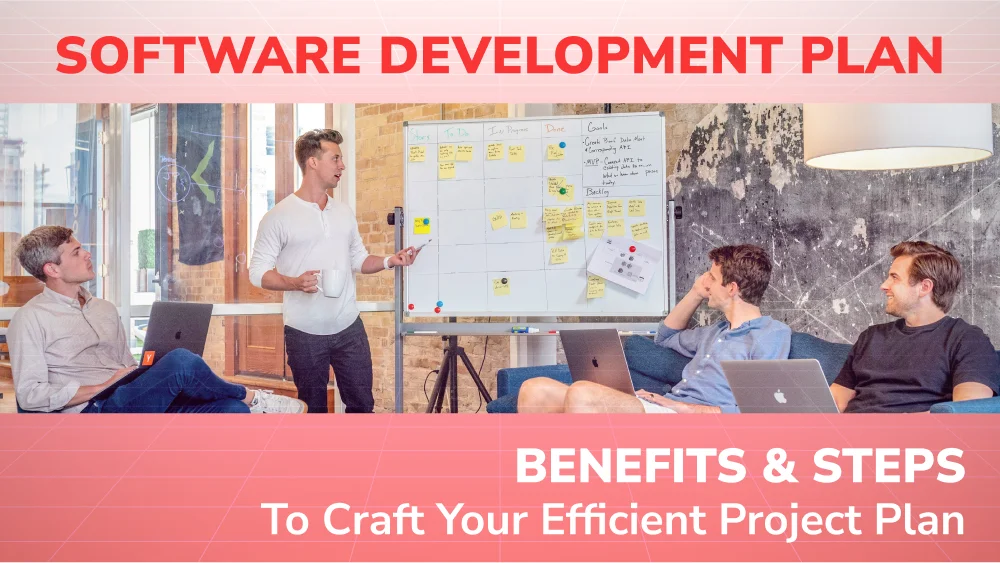
Software Development Plan: Benefits & Steps to Craft Your Efficient Project Plan
Learn how software development planning can help you create an efficient and successful project. Find out the benefits and how to develop your own plan.
Trung Tran | 28/05/2024
Ten Programming Languages for Web Development in 2024
Øyvind Forsbak | 09/02/2024
Best Cloud Certifications: Which Ones Are in High Demand and Why?
Tan Dang | 24/01/2024
Salesforce Service Cloud Vs. Sales Cloud: The Comparison
Shannon Jackson-Barnes | 25/12/2023
Assemble a Competent Web Development Team: Roles, Skills, and Qualities
Hieu Nguyen | 18/12/2023
Disclose the Astonishing Use Cases of Robotic Process Automation in Healthcare
Trung Tran | 19/10/2023
Why Outsource Web Application Development? - All the Practical Benefits to Take Action
Trung Tran | 06/08/2023

The Most Common Software Development Challenges & How to Solve Them
Here are the ten most common software development challenges and how to address them properly.
Trung Tran | 23/05/2024
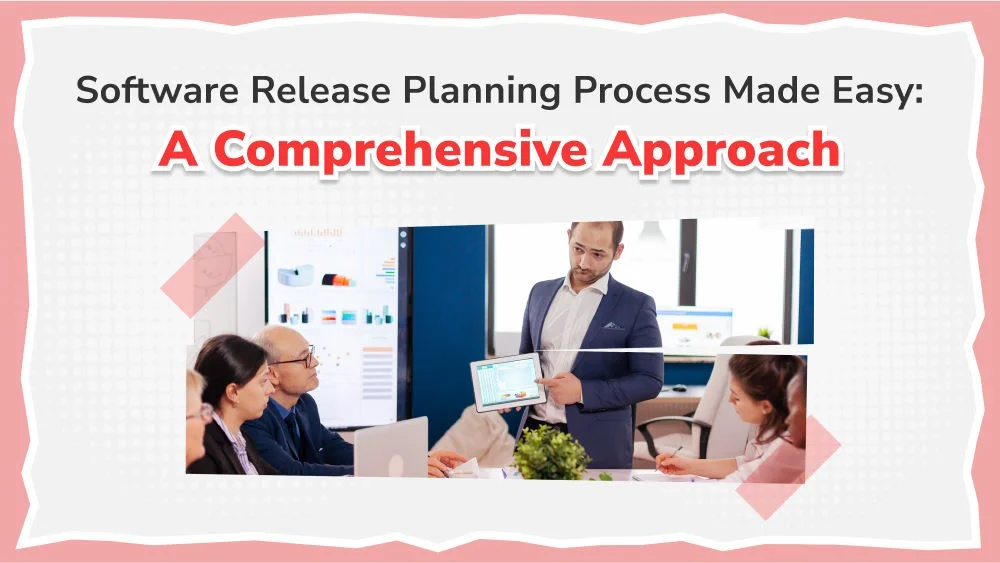
Software Release Planning Process Made Easy: A Comprehensive Approach
Mastering software release planning is crucial for success in software development. It's the key to gaining a significant competitive edge for your business.
Quynh Pham | 17/05/2024

Is Your Recruitment Process Costing You? Check out Recruitment ROI!
Is your hiring process a budget drain? Discover recruitment ROI & learn how to optimize for top talent and cost savings.
Tan Dang | 23/04/2024
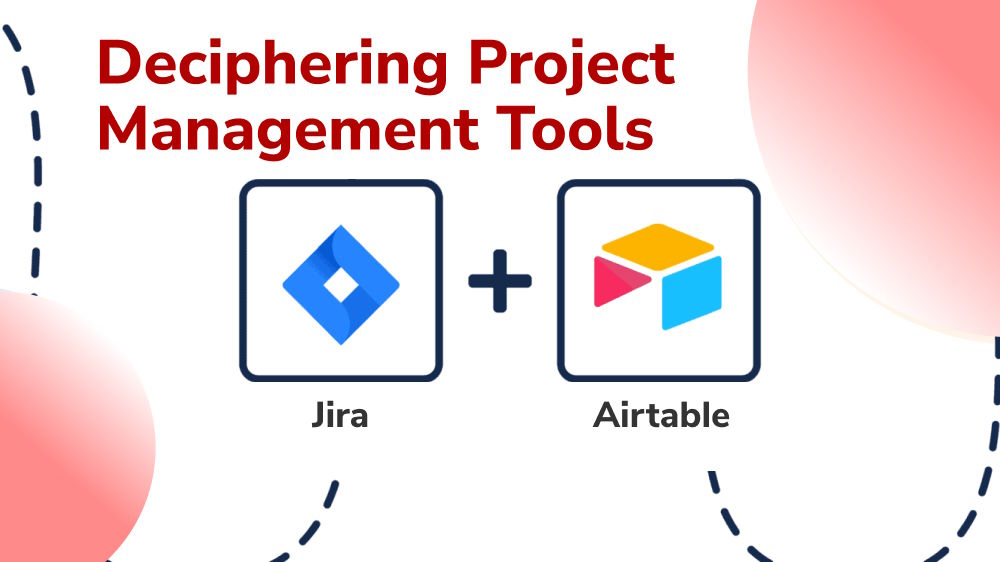
Deciphering Project Management Tools: Airtable Vs. Jira Comparison
Here is what you need to know to choose between Airtable and Jira - two popular project management tools.
Quynh Pham | 05/04/2024
Looking for an IT partner?
Contact us today for a free quote within 3 business days

In this blog...

How to Write A Tech Startup Business Plan
Whether you’re just starting out or have been in business for a while, creating a tech startup business plan is valuable. It will help you clarify your idea, assess its feasibility, and determine what resources you need to make it a reality. Here are some tips on how to write a tech startup business plan to will help you get started.
What is a business plan, and why do you need one for your tech startup?
A business plan is a written document describing in detail how a business will achieve its goals. This document lays out a written plan from a marketing, financial, and operational standpoint.
Sometimes, business plans are prepared for investors or as a requirement for a small business loan . But even if you don’t need outside funding, preparing a business plan is still a good exercise to ensure your ducks are all in one row.
If you’re considering starting a tech startup, having a business plan helps you to stay on track. When you have an idea for a new tech product or service, it’s easy to get caught up in the excitement and overlook the importance of creating a solid foundation for your business. A solid business plan will allow you to take a step back and think critically about your concept. At the same time, you’ll perceive how your concept will be received by the marketplace.
Furthermore, a good business plan keeps you focused on your goals and helps you track your progress as your tech startup grows. As your business evolves, you can refer back to your original business plan and adjust it accordingly. This document should be living and breathing, just like your tech startup.
Elements of a good business plan
The contents of your tech startup business plan will vary depending on your company’s specific needs , but certain elements should always be present. Here are the five key elements that every good business plan includes.
1. Executive Summary
The executive summary is a brief overview of your business plan. It should include your company’s mission statement, a brief description of your products or services, an overview of your target market, a summary of your financial projections , and your goals for the next three to five years.
Even though the executive summary should be the first section of your business plan document, it would be a good idea to write it last. This is because you’ll find all the important information from the other sections to complete the executive summary.
2. Company Description
The company description section of your business plan should provide an overview of your company’s history, mission statement, and core values. This section should also describe your company’s structure and how it will operate going forward. If you have any patents or proprietary technology, this is the place to mention it.
3. Market Analysis
The market analysis section of your business plan should research and describe your industry and the specific market segment you’re targeting. This information will be useful in developing your sales and marketing strategy later on in the business plan. Include information about your target customer’s needs, buying habits, and demographics.
4. Competitive Analysis
In the competitive analysis section of your business plan, you’ll need to identify and research your competitors—both direct and indirect. This portion is where you indicate their strengths and weaknesses relative to yours. Knowing what your competition is up to will help you develop strategies to stay ahead in the marketplace.
5. Sales and Marketing Plan
Your sales and marketing plan will detail how you plan to reach and sell to your target market segment. This part of the business plan should include information about your pricing strategy, promotional activities, distribution channels, and sales methods. You’ll also need to provide realistic financial projections for sales revenue over the next three to five years.
Tips for making your business plan stand out from the competition
Business plans are a dime a dozen. You need to go above and beyond the basics to make yours stand out from competitors. Here are a few tips on how to make your business plan shine:
1. Do your research
This may seem like a no-brainer, but you would be surprised how many people try to wing it when it comes to their business plan. Before you even start writing, take some time to research the industry, your competition, and your target market. This will give you a solid foundation to work from and will help you make your plan as comprehensive and impressive as possible.
2. Keep it concise
Nobody wants to read a 50-page business plan. Get to the point and be as concise as possible. This doesn’t mean that you should skimp on the details, but rather that you should focus on including only the most important information. The executive summary is a great place to start when it comes to being concise; make sure that you include everything!
3. Make it visually appealing
Remember, first impressions matter. Even if your business plan is top-notch, potential investors or partners will likely gloss over it if it’s boring or difficult to read. Use infographics, charts, and other visuals to break up the text and make your plan more enjoyable (and memorable) to read.
4. Proofread the document many times!
Last but not least, be sure to proofread your business plan before sending it off into the world. Nothing screams “unprofessional” louder than a poorly written document. So, take the time to edit and revise until your plan is error-free. Better yet, have someone else look at it for you. Sometimes, it’s easier for someone else to catch errors we overlook.
Final Thoughts: Writing A Tech Startup Business Plan
You now have a basic understanding of the components that make up a tech startup business plan. This is just a starting point, and your specific business will require more detail. But following these guidelines should give you a good foundation on which to build.
Besides a well-written business plan, you will also need the right team to help execute all the necessary actions to solidify your business strategy. When it comes to the tech talent side, Full Scale is the right match for any tech startup or even scale-up.
Full Scale houses the best and brightest software engineers, developers, and QA testers that you can find. You can forego the tedious process of finding, recruiting, and hiring developers for your tech team. We do all that for you and enjoy watching our client partners achieve great results.
Find out what Full Scale can do for you and your tech company!
Learn More about Offshore Development
Copyright 2024 © Full Scale

Tech Startup Business Plan Template

What is a Tech Startup Business Plan?
A tech startup business plan outlines a company's strategy and objectives. It serves as a roadmap for how to start and grow a business, and covers all the important aspects of a business including marketing, operations, and finances. The plan also gives details on how to organize the company's resources to achieve the desired results. It also provides information on the goals and strategies for the company, and how to measure the success of the business.
What's included in this Tech Startup Business Plan template?
- 3 focus areas
- 6 objectives
Each focus area has its own objectives, projects, and KPIs to ensure that the strategy is comprehensive and effective.
Who is the Tech Startup Business Plan template for?
This Tech Startup Business Plan template is designed for tech startup founders, investors, and teams who are looking to launch a new tech venture. The template helps you to plan and organize all the important aspects of your business and provides a comprehensive overview of your strategy, goals, and objectives. With this template, you can easily set measurable targets and create actionable projects to reach those targets.
1. Define clear examples of your focus areas
A focus area refers to the key areas of your business that you want to focus on in order to achieve your goals and objectives. Examples of focus areas could include developing a business model, designing and developing software, or marketing and selling. Each focus area requires its own set of objectives, actions, and measurable targets (KPIs).
2. Think about the objectives that could fall under that focus area
Objectives are specific goals that you want to achieve within each focus area. For example, if your focus area is developing a business model, your objectives could be to establish a sustainable business model, or to implement and refine the model. Objectives should be specific and achievable.
3. Set measurable targets (KPIs) to tackle the objective
Measurable targets (KPIs) provide a way to measure whether or not an objective has been achieved. For example, if your objective is to increase customer base, a KPI could be to increase customer feedback. KPIs should be quantifiable and measurable in order to track progress and measure success.
4. Implement related projects to achieve the KPIs
Projects (actions) are the steps you need to take in order to achieve a KPI. For example, if your KPI is to increase customer base, an action could be to execute the business model. Projects should be concrete and achievable, and should be designed to help you reach your KPIs.
5. Utilize Cascade Strategy Execution Platform to see faster results from your strategy
The Cascade Strategy Execution Platform is a powerful tool to help you quickly and easily track your progress and measure your success. With Cascade, you can easily set measurable targets, create actionable projects, and track your progress. With Cascade, you can ensure that you reach your goals faster and with greater efficiency.
How to Write a Tech Startup Business Plan to Win Investors
You have a great business idea. Now you’re doing the hard part: raising capital.
With a failure rate of 63% in the tech startup industry, you need to have a highly compelling business idea and go-to-market strategy to win over investors.
We’re going to make writing a startup business plan really simple by providing you with a step-by-step guide along with a business plan template you can use to build startup business plan that wins investors.
What is a tech startup business plan?
Why do you need a technology startup business plan.
- 1. Executive summary
- 2. Market opportunity
- 3. Product or service overview
- 4. Marketing and sales strategy
- 5. Team and management structure
- 6. Key milestones
- 7. Financial plan
Sample tech startup business plan [template]
A technology startup business plan is a document that is used to outline the goals, strategies, and objectives of a new tech startup business. This document is often used to secure funding from investors and to help the business leaders form a unified sense of identity and purpose.
The business plan should include information on the products or services offered by the startup, the market opportunity, the business model, the team, the financial projections, and the risks and challenges associated with the business. A tech startup’s business plan should generally address three major areas of the business:
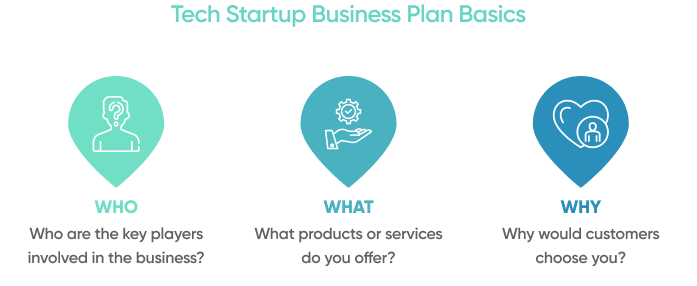
As a startup moves through various stages of growth, the business plan should be updated with new information and forward-looking goals. In this way it can serve as a “source of truth” for all of the startup’s stakeholders.
A business plan is an essential tool for any tech startup. It provides a road map for your business, helping you to define and communicate the company’s vision, goals, and strategies. Having a singular document that acts as a single source of truth for the business will help to keep the startup’s core leadership team unified and provides guidance on how to navigate the often-complex world of starting and growing a business.
You can utilize your startup business plan to secure funding and partnerships. A well-crafted business plan can also help you attract and retain top talent.
In summary, you need a technology startup business plan to:
- Unify the startup’s leadership team
- Secure funding and partnerships
- Attract top talent
- Act as a guide for navigating starting a business
This article will act as a guide for writing a business plan for tech startup founders.
7 key components of tech startup business plan
You know you need a business plan for your tech startup. You know generally what should be included. But, now you need to actually get to writing. We’re going to try to make this as easy as possible by outlining the 7 key components your technology startup business plan should have.
If you’re looking for a real shortcut, make sure you download our easy tech startup business plan template. Included in it you’ll find a sample business plan and an outline of what we’ll cover below.
Stick with me if you’re looking for a more detailed explanation of each of the 7 components.
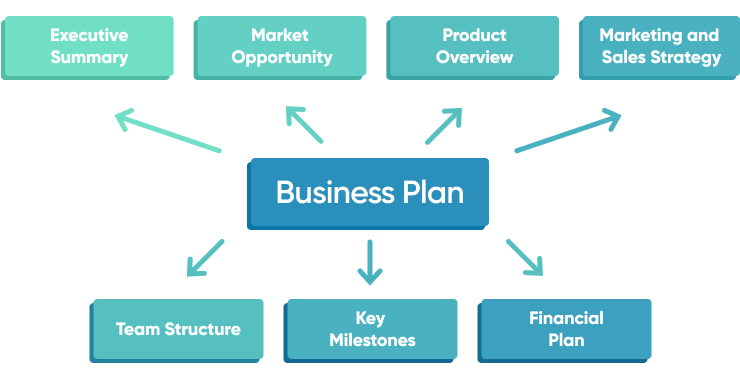
- Executive summary
First up is an executive summary. This brief section should provide some context to readers as they begin to read your business plan. It’s your opportunity to share, at a high level, your business idea.
At a minimum, this section should outline what your business is, the general market you target or industry you are in, and what your products or services are. Optionally, you can include some information about your business’s history, bios of key members of your leadership team, competitive advantages, key customer benefits, and your company’s goals. How detailed you get with this section is up to you. Use this as an opportunity to provide an overview before you get into more detail in the other sections of your business plan.
- Market opportunity
This is where you will start to go into more detail about your business. Starting with the market opportunity allows you to paint the picture of the why _behind your tech startup before you go into the _what . Ultimately, you can only sell the feasibility of your business by backing it up data on who your potential customers will be. This section will help to inform the marketing strategy and sales plan later in the startup business plan document.
Take the time in this section to walk through the research you have done on your audience. To start, you should have data points on the following:
- Demographic data for your target market (age, gender, income, occupation, location)
- Main pain points of your target market
- Values and interests of your target market
- Needs and wants of your target market

It can also be compelling to provide some information on how your products or services will stand out from the competition. Consider answering the following questions in this section:
- Who are your main competitors?
- How will your products or services meet the market’s needs better than the competitors?
- Will your products or services be able to reach a currently unreached audience?
- How will you differentiate yourself from the competition within your target market?
All of this data should back up what the real market opportunity is for your business. Make sure this market opportunity is realistic and achievable. This should lead well into our next section which will cover in more detail the products or services your tech startup will offer to the market.
- Product or service overview
After you have outlined the market opportunity your business will take advantage of, it’s time to provide more details on the exact products or services that you will offer to your market.
Each product or service you include in this section should have a corresponding functional and technical description. The functional description should aim to outline to a layperson what the product or service is, what it does, and how it will be used. The technical description should outline the technologies each product or service utilizes or what technology has been developed specifically for the new business. It’s appropriate to go into detail here to give potential investors more confidence in your product or service.
It’s also important to include information on how the products or services will ultimately benefit customers and what problem they will solve for customers. If you have more than one product or service, make sure to outline this information for each one.
- Marketing and sales strategy
The marketing and sales strategy section of a technology startup business plan should include a description of the target market, the company's marketing and sales objectives, the strategies and tactics that will be used to reach these objectives, the key marketing and sales metrics that will be used to measure progress, and the budget for marketing and sales activities. In short, it should outline your business’s marketing and sales plan.

Starting with the objectives, you should outline specifically what you are trying to achieve with your marketing and sales efforts both in the short term (likely for launch) and long term. Each of your objectives should align with your overarching business goals and make sense for the market you outlined earlier in your business plan. Be realistic here. It’s better to estimate low and over deliver than to overestimate your success.
As you outline the strategies and tactics you will use to achieve your objectives, consider both the what _and the who_:
- (What) What tactics will you employ to achieve your goals?
- (What) What marketing tools do you need to achieve your goals?
- (What) What marketing channels will you use?
- (Who) Will the marketing work be done internally?
- (Who) Will you hire freelancers or a CMO to help implement the work at hand?
- (Who) Will you need a sales team right away?
- (Who) How will marketing and sales work together to achieve your goals?
Your marketing and sales strategy should be backed up by the market opportunity information you provided earlier. The strategies and tactics should be aiming to reach your target market.
Next, outline the metrics that will be used to measure marketing and sales progress. You should include specifically when these metrics will be measured and who will be held accountable for them.
Finally, include a marketing and sales budget in this section. The budget should be broken down by channel and tactic, so that dollars can be accurately tracked and attributed to results.
- Team and management structure
Up next is the team and management structure part of the business plan. To start, provide an overview of the startup’s organizational and management structure. Providing a graphical representation of the reporting structure can be helpful.
This can then lead into an overview of who owns or manages each of the key sectors of the business (CEO, CTO, CMO, etc.). It’s a good practice to provide a bio of each of the members of the leadership team, including their education, work history, and relevant expertise. Along with their bio, provide a description of their role and responsibilities within the organization.

After you have covered the leadership team, outline the other team members along with their roles and responsibilities. Following this, include some commentary on the team’s strengths and weaknesses as well as what gaps remain within the organization. If additional staffing is required, provide a hiring plan that includes a description of the role, salary, and strategy for recruitment.
End this section with an overview of the organization’s values. Paint a picture of what it’s really like to work for your company and how you build a sense of ownership and responsibility within the team. Highlight how you intend for the team to work together to accomplish the company’s goals.
- Key milestones
At this point in the business plan you have outlined the target market, products and services you will offer as well as the members of your team that will bring the company’s vision to life. In this section you’ll provide a timeline of the past and future milestones for your business. This will help to illustrate your startup’s growth path and how you intend to move forward.
Some key milestones to consider when writing this section:
- When business was founded.
- When the business was/will be launched publicly.
- When the business was/will be profitable.
- When the business reached/will reach funding milestones.
- When development project milestones were/will be reached.
- When marketing milestones were/will be reached.
- When key staff were/will be hired.
- Future product release dates.
You might consider showcasing this information in the form of a graphic like this:
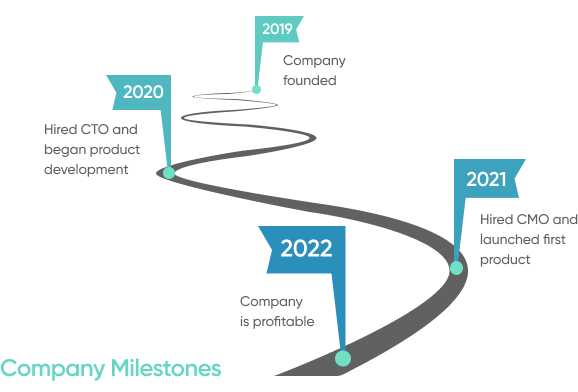
In addition to a company timeline, we recommend you include additional data in this section such as:
- Current number of employees and the number of employees projected in the future.
- The amount of revenue generated in the past and projected for the future
- Key clients or contracts that have been signed or that are in the works.
This section should clearly demonstrate your startup’s ability to grow from an idea into a business. Providing concrete dates and real data in this section will provide some validity to your startup and showcase what you’re able to accomplish.
- Financial plan
The final section of your technology startup business plan should be a financial plan. This is the section of the business plan that outlines how the business has been funded to date and how it will be financed moving forward.
There is no one way to write the financial plan section of a business plan, as the amount and type of information that needs to be included will vary depending on the business and the specific financial goals of the plan.
However, there are some basic elements that should be included in most financial plans. These include a pro forma income statement, balance sheet, sales forecast, and cash flow statement. The pro forma financial statements should be based on historical financial data, if available, and should include assumptions about future revenue and expenses. The financial plan should also include a discussion of the company's capital structure, including its debt and equity financing.
If you’re at a very early stage with your startup and seeking a modest amount of funding, it’s probably sufficient to air on the side of brevity. If you’re seeking series A, B, or C funding, you’ll likely need a very comprehensive financial summary along with a detailed plan on how the funding will be utilized to grow the business. Seek counsel from a business accountant if you’re unsure of how to provide adequate financial documentation.
We have walked through the 7 key elements of any tech startup business plan. Now we’re going to share a sample business plan template to help you get started with writing your own!
Innovation is critical to success in the software industry. The executive team of this startup believes they have the next big thing. They have developed a new software application that helps businesses manage their social media accounts more effectively. The software provides insights on when to post, what to post, and how to engage with customers. The software also allows businesses to track their social media analytics and see the return on investment for their social media campaigns.
The executive team has extensive experience in the software industry and believes this new product has the potential to be a game-changer for businesses. The team is seeking $1 million in seed funding to help with product development, marketing, and sales. The company plans to generate revenue through monthly subscription fees and by selling data analytics services to businesses.
The social media management software market is expected to grow from $9.3 billion in 2020 to $17.4 billion by 2025, at a compound annual growth rate (CAGR) of 13.2%. This growth is being driven by the increasing use of social media by businesses of all sizes and the need to effectively manage social media accounts to drive brand awareness and customer engagement.
The software application developed by the startup helps businesses manage their social media accounts more effectively. The software provides insights on when to post, what to post, and how to engage with customers. The software also allows businesses to track their social media analytics and see the return on investment for their social media campaigns.
The software is available on a monthly subscription basis and businesses can also purchase data analytics services to help them further understand their social media campaigns.
The company plans to generate awareness for the software through online and offline marketing campaigns. The team will target small businesses and medium businesses that are active on social media but do not have the resources to effectively manage their accounts.
The company will use a mix of paid and organic marketing to reach its target audience. For paid marketing, the company will use Google AdWords and Facebook Ads. For organic marketing, the company will use content marketing and social media outreach.
The company plans to sell the software on a monthly subscription basis. The team will offer a free trial to businesses to get them started with the software. Once the free trial expires, businesses will be charged a monthly subscription fee.
The executive team of the startup consists of experienced software professionals. The team has a proven track record of developing and marketing successful software products.
The company plans to hire a sales and marketing team to help generate awareness and drive sales of the software. The team will be based in the United States and will consist of sales and marketing professionals with experience in the software industry.
The company plans to achieve the following milestones over the next 12 months:
- Launch the software application
- Generate 500 paying customers
- Achieve $1 million in annual revenue
The company is seeking $1 million in seed funding to help with product development, marketing, and sales. The company plans to generate revenue through monthly subscription fees and by selling data analytics services to businesses.
The company projects the following financials for the next 12 months:
- Revenue: $1 million
- Expenses: $500,000
- Profit: $500,000
As a startup founder you know that having a software startup business plan on hand is critical to win over investors and get your business funded. However, no one wants to spend days writing a complicated it startup business plan. It’s much more important to focus on the day-to-day operation associated with building your tech startup.
To help save you time (but still create a winning startup business plan), we’ve outlined the 7 key components of any tech startup business plan:
As you tackle writing your own, make sure you refer back to this guide along with our template to ensure you’re writing a compelling business plan that is sure to win over investors!

Technology Business Plan Templates
Written by Dave Lavinsky

In the rapidly evolving technology sector, where innovation and market agility are paramount, a well-structured business plan is crucial for success. It serves as a vital strategic tool for technology entrepreneurs and startups, guiding them through the complexities of product development, market entry, and competitive positioning.
Our array of business plan examples cover various technology business types, including software development companies, hardware manufacturers, IT service providers, and tech startups exploring emerging fields like AI and blockchain. Each plan is carefully constructed to address key components such as market analysis, technological innovation, scalability, funding strategies, and go-to-market approaches. These business plans are essential for technology business owners, offering a comprehensive blueprint for navigating the highly competitive tech landscape, attracting investment, and managing rapid growth. They highlight the importance of detailed and forward-thinking planning in harnessing technological advancements, meeting market demands, and achieving sustainable success in the dynamic world of technology.
Technology Business Plans
Artificial Intelligence Business Plan PDF Biodiesel Business Plan Blogging Business Plan Clean Tech Business Plan Mobile App Business Plan Saas Business Plan Software Company Business Plan Technology Business Plan YouTube Business Plan

How to Write a Software Startup Business Plan in 2024 [With Templates]
Updated 28 Aug 2023
16359 Views

Business analyst
Every company is rooted in a unique business concept. However, having ideas isn’t enough for a company's prosperity and success. Many startups fail due to faulty training in their first year. An IT startup business plan is the first thing that can be corrected by organizing your thoughts and even finding the right people to work with, turning your idea into a prosperous project.
We'll cover how to write a startup business plan, thoroughly covering each part, give some advice, section templates, and more.
Why Does Your Startup Need a Business Plan
Before we go into precise statistics and data, let’s have a closer look at the notion of a business plan. It will assist you in better navigating the subject. The tech startup business plan is a document that summarizes strategies and ideas for the new company launch, support, and even an exit.
Now, we’ll look at stats to understand why a business plan is required. Startups fall due to a bunch of reasons: among the most widespread ones, CBInsights mentions running out of funds (for 38% of startups), absence of market need (for 35%), etc. A business plan can raise startup success chances.
Such a document serves companies for different purposes. The most common of them are:
- Attracting investments
- Building a development strategy
- Predicting your upcoming financial expenses and needs
How can the IT startup business plan assist business owners in implementing these purposes into life? It’s possible due to the following benefits such a document brings:
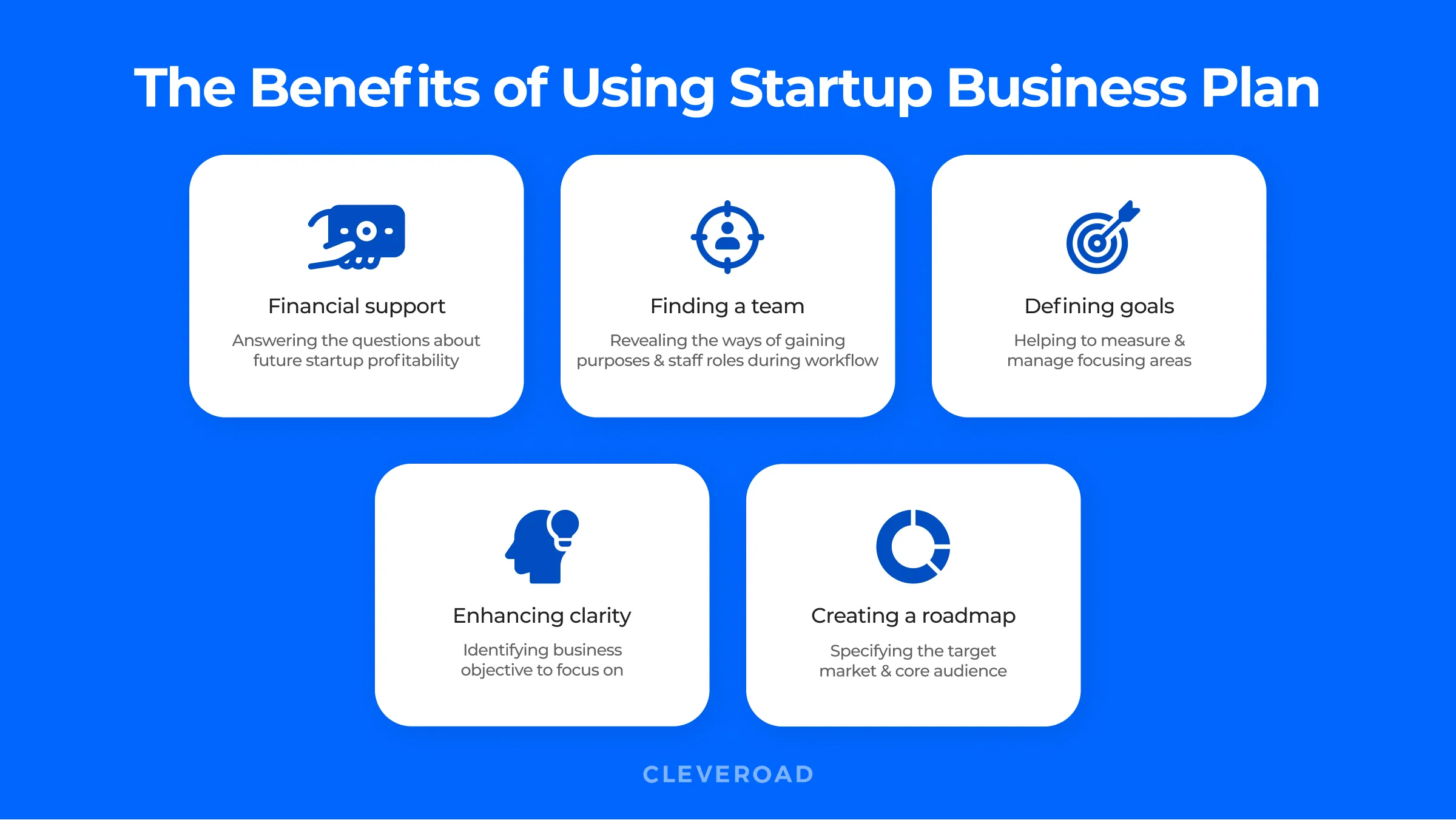
A technology business plan benefits
Remember that to gain these benefits, you must adhere to a specific structure when drafting your startup business plan. It must contain the following parts:
- Executive summary
- Company description
- Marketing plan
- Financial projections
- Team structure
“How to write a startup business plan” is a common question, and many entrepreneurs are looking for an answer. We’ll discuss it in detail, looking closely at each section.
Executive Summary of Technology Company Business Plan
This section serves as an introduction to the entire document. A well-written executive summary grabs readers' attention and instantly illustrates what your technology business plan is all about.
It typically includes the following parts:
Business overview
Introduce your startup to readers, tell them about your plans and offers. This section should be short - about 1-3 sentences.
Target market
Define the target market for your startup company. To make the section more useful and demonstrate your future startup value, provide a detailed market overview and client issues you would solve with your product.
Competition
Portray your possible competitors as well as the attributes that will set your company apart. Describe how you will compete in pricing, quality, or service structure in this part of the executive summary in your software startup business plan.
Emphasize your company's goals and particular milestones, illustrating the said with charts (including profit, sales, and ROI) for greater clarity of prospective investors. Think about financial estimates for different periods.
Briefly describe your team composition or tell about the lack of particular specialists and your possible ways to find them. Portray the existing staff members along with their experience, and don’t forget to mention software development partnership .
The final section tells potential investors how much money you'll need to bring your idea to life. Tell this aspect to stakeholders beforehand, including the appropriate data to the executive summary.
Sometimes even the perfect technology company business plan is not enough for the stakeholders to pay attention to your project. They’ve reviewed piles of such documents, so one more, looking like the previous, may not interest them a lot. But you can change the situation by preparing a presentation of your business plan, where you can mark the vital concepts you’d like to share (e.g., company overview, problems you’d like to solve, startup team composition, etc.).
6 Tips to Create an A+ Executive Summary
We've compiled a list of recommendations to help you create an excellent executive summary of the whole technology startup business plan.
Tip #1. Write it last
Executive summaries should be written last as they summarize the entire business plan. That's why you should complete your research for all areas of your startup business plan and then write the executive summary.
Tip #2. Capture readers’ attention
An executive summary's main objective is to emphasize critical information about the tech company business plan. But, it's vital not to overload the summary with unnecessary details regarding the concept. It should grab people's interest and make them want to learn more.
Tip #3. Keep it structured
A well-defined structure of summary will convey your ideas. Consider including an introduction, main body, and conclusion that are short but informative. The important takeaways from your tech business plan would be provided by this structure.
Tip #4. Mention exit strategy
An exit strategy is an essential part for stakeholders. It can be an acquisition by another company after running technical due diligence , share selling, or employee buyout.
Tip #5. Use facts
Your primary goal is to persuade people to invest in your company. If your startup's goals, experience, and market perspectives are based on facts, they will have more impact. For instance, you may give information about market valuation and your expected market share.
Tip #6. Avoid cliches
There are a few hazards to avoid if you want your executive summary to succeed. For example, don’t mention the team’s passion and enthusiasm. Investors already know it. They’ve seen hundreds of passionate startups before. Instead, provide decision-makers with facts and let them say that for you.
Order a business consultation
Book a call, and get all the answers about business planning from our Business Development Experts!
Company Description
The company description section of a technical business plan exposes its history, aims, team structure, etc. However, it is frequently the shortest part of the business plan.
Company history
This part is based on your company's current stage. If you're an established organization looking for money for a new project, it's a good idea to provide investors with some company background. In case you are a startup business without a rich history, you may tell who is behind the company and how the founders came up with the idea.
Give a brief description of your company's location, including a physical address, or inform investors about your prospective location coordinates. Whether you'll buy or rent an office, as well as how long you'll be using it as a company location. If you have a home office, also indicate this aspect.
Type of business
This section provides information about your industry. It should be brief but not excessively so. Don't write something like, "We're going to sell things." Indicate your domain: travel, healthcare industry, etc. Finish this section off with a domain description.
Management and employees
This is a chance for investors to get acquainted with your team. Mention all staff members and management personnel, defining their duties, abilities, experience, and accomplishments. Also, don't forget to include information about yourself as an opening. Describe any gaps in the team (if you have ones) and explain how you plan to fill them.
Legal structure and ownership
This data is critical for investors because taxation varies based on the legal structure. Specify if you're an LLC, a C-Corp, an S-Corp, a Sole proprietor, or in a partnership. Specify who runs the enterprise and what technical co-founder equity they have.
Company’s mission and principles
Write this part in a creative manner. Come up with one or two lines that precisely define the aims and ideals of your business.
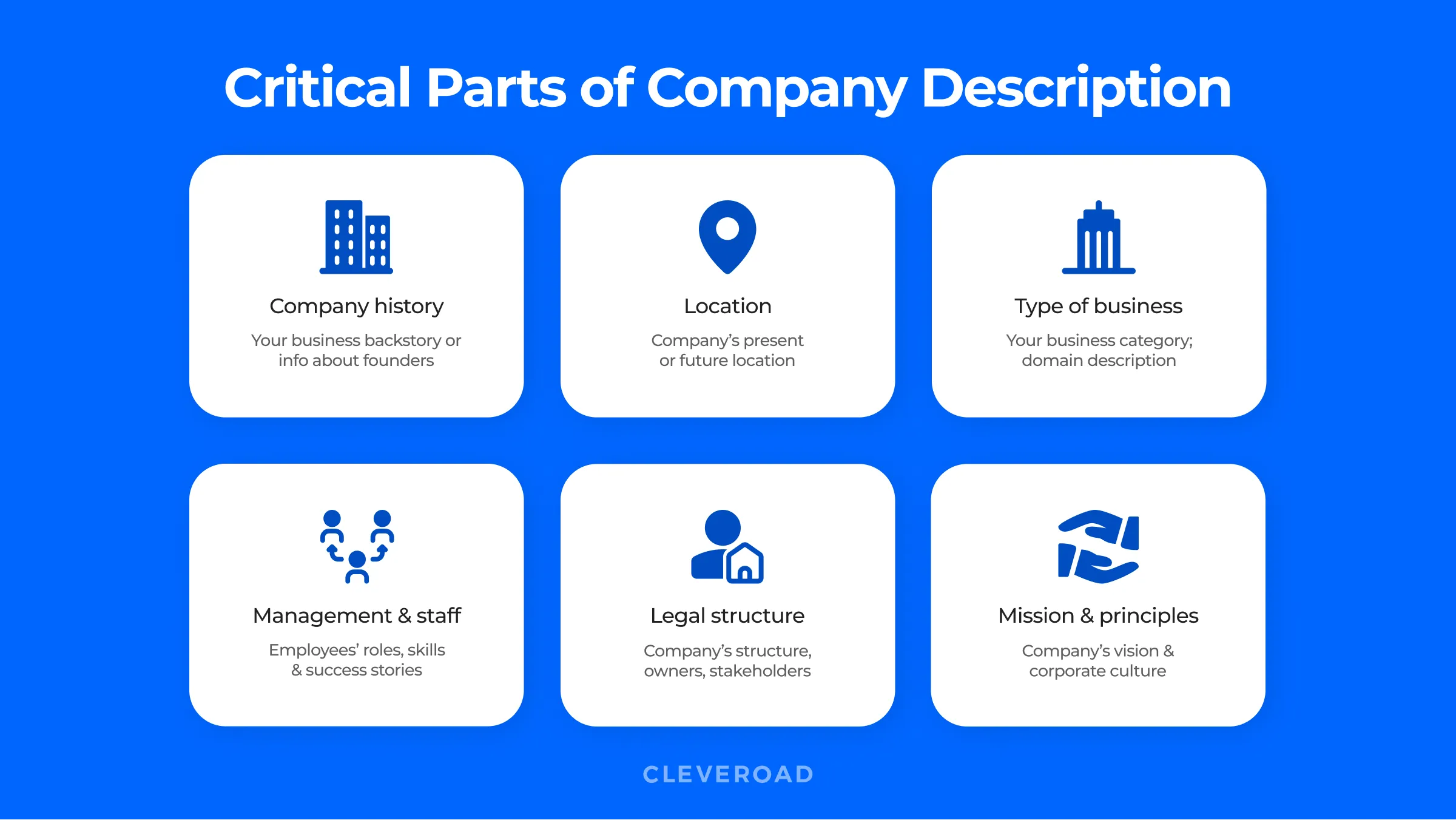
Critical parts of Company description
You can also include the following parts in this section of a tech business plan:
Business scaling strategies
Scaling a business equates to laying the groundwork for your company's future development. So, writing this section of the business plan for technology company, think about appropriate systems, personnel, procedures, technology, or funding — everything you need to scale.
Business opportunities
Prospective investors want to understand why your company’s considered to be profitable. Tell them about your business opportunities, offering information about factors of your future success, specialists you’ve consulted about your business, and their thoughts about it, reasons for selling the certain articles/services, and profit they may bring, etc.
Marketing Plan
It outlines the company's competitive advantage as well as its marketing objectives. This part of the business plan for startup also aids in the particular domain identification and the development of a viable business strategy.
Moreover, you can define and put down such important data as a qualitative concept description and strategies for attracting clients to show stakeholders how to differentiate your startup activity from your competitors’ and ways you may engage the users to cooperate.
This part of the business plan for a tech startup is typically divided into three sections:
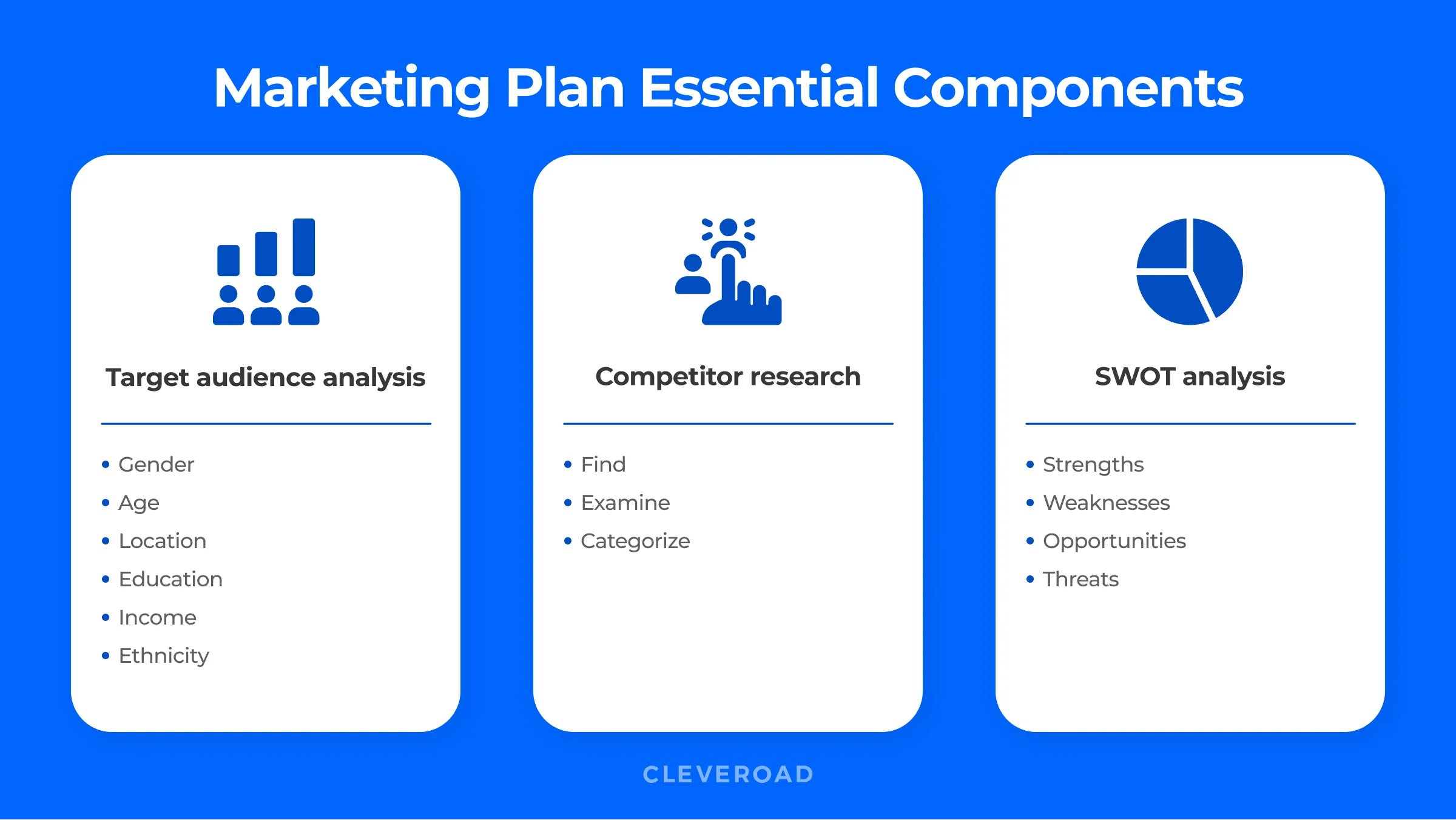
Marketing plan components in a nutshell
Target Audience Analysis
Customers are vital to every company. So, you must determine to whom you will offer your services. Begin with easy tasks and work your way up to more complicated ones.
Let's say your firm is an online car parts store that you want to open on the West Coast of the USA. Your potential core audience may look like this after brainstorming:
- Gender (Males)
- Age (16 - 60)
- Location (Los Angeles, CA)
- Education (Secondary)
- Income ($60,000 - $75,000)
- Ethnicity (drivers, service stations workers)
After determining general characteristics, it is time to dive deeper into the analysis. It can be done in a variety of ways in every sample business plan for tech startup.
Conduct surveys
According to your audience assumptions, you may collect focus groups and conduct surveys. It is possible to complete them both online and personally for technology business plans. Surveys can help you learn more about your consumers to provide better service.
Analyze competitor’s audience
Competitors already meet consumers’ needs, and your task is to identify their audience and understand what makes them use their product or service.
Examine your rivals' marketing channels to see how they do it. Visit their websites, follow them on social media, and sign up for their newsletter. These procedures will assist you in identifying the pain areas of your clients.
Create a buyer persona
The final stage in the target audience study is to create a buyer persona based on the research findings from prior steps of every tech business plan example. Let's take a closer look at it.
A buyer persona is an ideal consumer description, including how they use their leisure time, the obstacles they face, and their decisions. Such a description may be created using various methods. For example, HubSpot's Make My Persona product works perfectly for it.
Learn more about how to define target audience in our article!
Competitor Analysis
Competitor research is critical to the company's success. It allows you to have a deeper understanding of your target market, as well as identify competitors, their tactics, and offerings, among other things.
You should follow three phases while conducting a competitive analysis for a business plan for tech startup.
Step #1. Find competitors
Start by searching for basic requests in Google. Make a list of your rivals in the same business as you and have similar ideas. After that, do some in-depth research, analyzing their social media posts, news reports, or consumer reviews.
Step #2. Examine them
It’s time to dig deeper. But keep in mind that you may need special tools like Ahrefs or SimilarWeb. Carefully examine the following criteria essential for every tech business plan sample:
Pricing. Analyze the charges for their services. It will assist you in determining the pricing boundaries for your goods. However, bear in mind that you are not obligated to value your product lower than your competitors in order to win the competition.
Organic traffic. Determine how many visits they receive due to a Google search. These metrics will display the popularity of your competitors. To handle them, you can use tools like Ahrefs, SimilarWeb, and Alexa.
Social media mentions. It's another way to look into your opponents' activities and see what consumers say about them. With tools like Followerwonk, Social Searcher, and Sprout Social, you can monitor engagement rates, keywords chosen, or social shares and mark them in your business plan.
Time on the market. You must determine the time on the market to see if you will compete with a major company or a start-up. The WHOis.net service may be used to examine the domain name registration date, server stats, and contact information.
Step #3. Categorize them
Even having learnt everything about your competition, you still need to watch your rivals and follow their movements. The next step would be to split competitors into three categories based on their “danger level”:
Primary competitors
These are the main ones oriented to the same core audience as you.
Secondary competitors
They can provide high or low-level versions of your services to a different target audience than yours.
Tertiary competitors
They are indirectly related to your company.
SWOT Analysis
It’s the final step of the section in every tech startup business plan example.
SWOT is an abbreviation of Strengths, Weaknesses, Opportunities, and Threats:
- Strengths contain your strengths, killing features, and those able to help stand out from the competition.
- Weaknesses mean your weak sides and flaws that may slow you down in a competitive race.
- Opportunities are the levers that’ll help you in business development.
- Threats are external threats that may impact your startup yet don’t depend on your decisions.
The SWOT matrix is a tool used by businesses to compile all their data into one page. To simplify this process, we recommend using the below technology business plan template (namely, one for SWOT analysis).
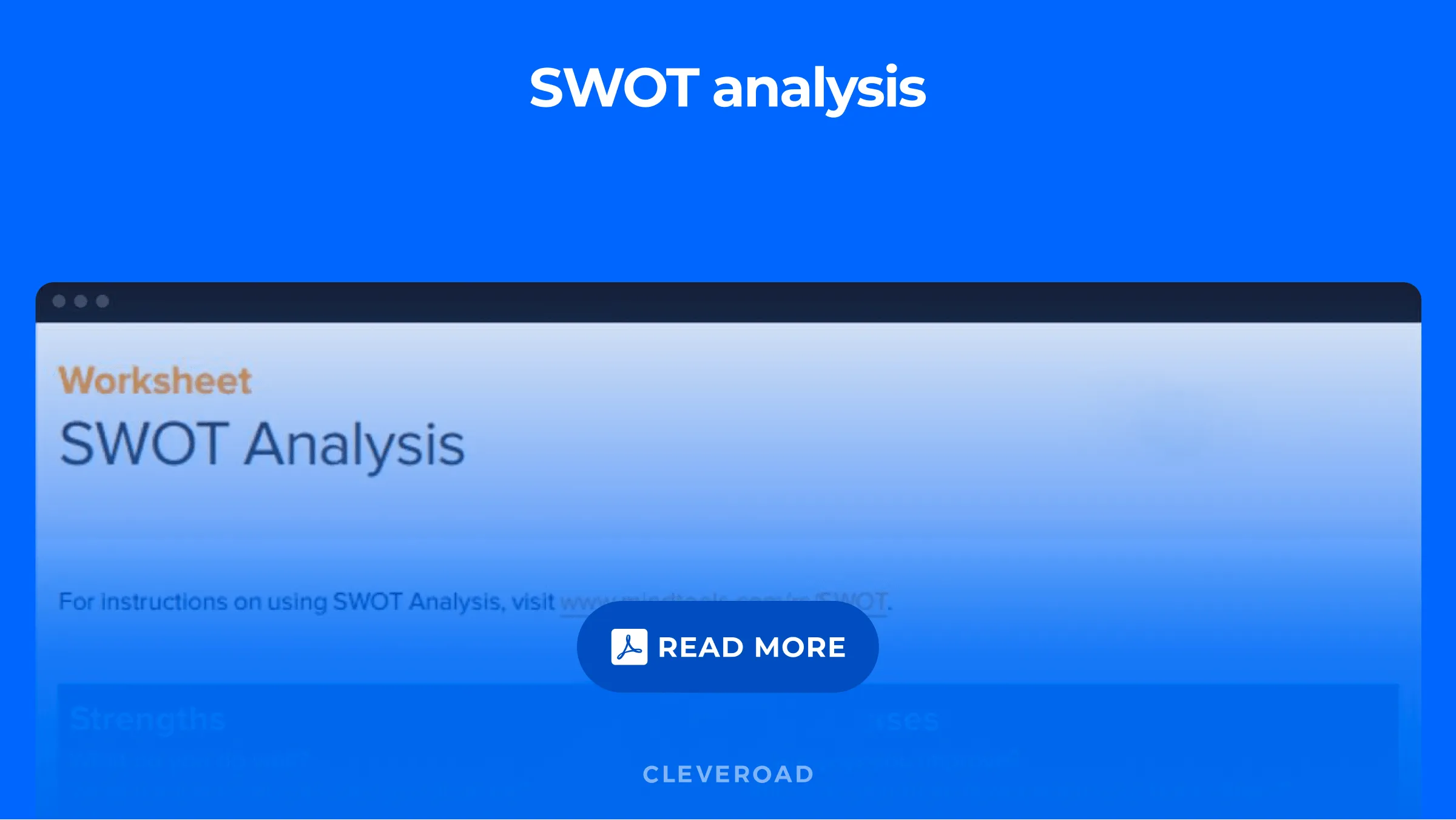
SWOT analysis template
Financial Plan
A financial plan is a projection of future income and costs for your business. It's an important aspect of strategic planning that can turn vague objectives into concrete milestones.
Complete the following parts in your business plan tech startup example or create them yourself:
Balance sheet
This part illustrates your present financial situation. A balance sheet is a wonderful method to forecast your future financial condition and design your growth objectives if you're searching for finances.
Expense projections
You must plan your future expenses classified into fixed and recurring costs to make your concept clearer to stakeholders. In general, estimate how much money will be spent on your idea implementation and how frequent these expenses would be.
Income projections
This part of the business plan tech startup needs summarizes the project's future earnings and sales. To begin with, you must predict your product's sales. After that, forecast the possible revenue for your startup using the sales projection.
Cash flow projections
The cash flow estimates are the last element of the financial plan. In a nutshell, it's a summary of all the money going in and out of the company. It shows your company's financial health at all stages of development, including the company's income and expenses. Depending on it, the remaining cash balance is calculated for a given time.
Monetization strategies
A company establishment and a beginning of the product development flow are only half of the way to market launch, impossible without a proper monetization strategy — a method of future profit gaining. For example, if your upcoming product is a fitness mobile application, you can implement advertisements, in-app purchases, freemium strategy, and others.
For successfully hitting your aims, you should know your destination, as well as the tools and methods you need to achieve established objectives. All this information can be included in your sales plan.
Though it’s considered to be a separate document looking like the business plan, the essential difference is that the business plan contains your objectives, and the sales plan mentions how to achieve them.
You can also include a sales plan as a section in a startup business plan, containing your situation assessment, financial forecasting, resources, revenue targets, etc. Document templates (for example, one from 150 Startups below) will help you understand which direction to choose.
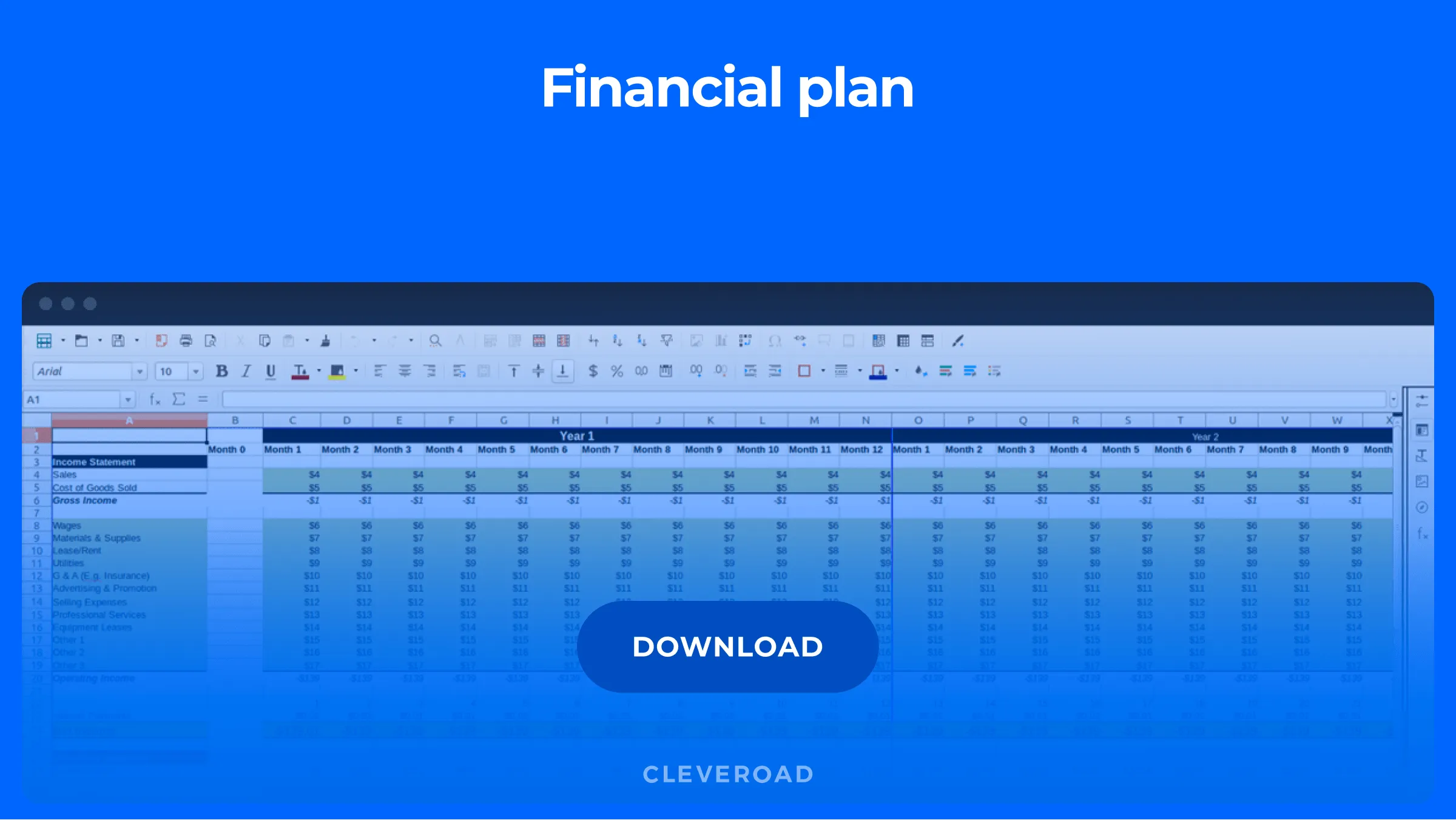
Financial plan section
Tips to Make a Financial Plan
Preparing a financial strategy for a starting firm might be difficult, but it is essential for any business plan. To make the process easier, we've compiled four helpful hints answering how to write a business plan for a tech startup, namely this section.
Keep your financial plan in line with the business plan
The statistics in your financial predictions should back up all of your verbal goals outlined in earlier parts. For example, if you want to launch your product in the third quarter of 2022, you'll need to budget for marketing, shipping, and other expenses during that time.
Your financial assumptions must be clear
Even if the precision in figures of a financial plan is critical, most investors care about your projections comprehension. Demonstrate your understanding to them, providing enough material to back up your financial assumptions: annual financial statements, market/competitor analysis data, etc.
Be optimistic yet realistic
Even a significant financial plan requires a healthy dose of optimism. But don't go too far with it, or you'll come out as a dreamer to the investors. It's critical to balance the accuracy of the facts and the need to show a financially viable project to stakeholders.
Use templates
Many business owners have no clue where to start when creating a financial strategy or how to present it. If so, use pre-made templates with all of the essential sheets and columns.
Get a startup plan: explained!
Entrust to Cleveroad experts your business planning for software development project
Team Structure
This is the final section of the business plan, informing investors about your startup's organizational structure. It may contain the following parts:
Management Team
Team composition is essential for a proper startup functioning, as well as for its future growth. If you’re going to launch a software development company, at the beginning of the startup’s existence, your project team formed may include:
- Chief Executive Officer (CEO) — an expert responsible for company management, supervising, human resources running, communication with CTO, etc.
- Chief Technology Officer (CTO) — a team member competent in development and technology areas, UI/UX design, back-end, or QA team supervising
- Chief Marketing Officer (CMO) — a specialist responsible for the clients’ perception of your service or product offered
- Chief Sales Officer (CSO) — an expert running all activities connected with business development
The software development team composition should contain the following specialists as UI/UX designers, front-end and back-end developers, QA engineers, and others essential for the product’s appropriate development.
How to build a software development team — revealed! Check our recent guide to know more!
So, list and briefly characterize each key management person in your business. Try to tie their expertise to your company's current responsibilities, using the business plan template tech startup requires, or write this part on your own.
For instance, if your VP of Sales has previously worked for an organization that increased sales from $5 million to $10 million, it would be a wonderful addition to demonstrate their knowledge and value on the team. You'll also demonstrate to investors that you've assembled a strong team they can trust with their funds.
Management Team Gaps
This is common when a company lacks some management team members while developing a business plan. If it's your case, you should make a list of any absent personnel and the particular skills for future candidates, such as experience in the needed sector, duties, etc.
For example, if you want to find a CTO for a startup , you can say that the perfect candidate must have 10+ years of experience, top-class knowledge of modern technologies, and extensive skills to effectively manage the team and develop the product.
Board Members
The Board of Directors is a hired group of individuals that assist you in running your business properly. Even if a Board of Directors is uncommon for startups, you may spot one in the team structure and care about these gaps to be filled.
Supplementary Sections For Your Business Plan
If you need to provide stakeholders and other readers of your business plan with additional information about your startup company, you may give it in a supplementary appendix section to your business plan example tech startup needs (or one created by yourself). It isn’t essential; however, your possible investors may need some more data about you and your business (a credit history, for instance).
So, the appendix should be prepared beforehand to save time in the future. You can include in it:
- Charts, tables, and other illustrations absent in the central parts
- Trademark/patent documentation
- Market researches in details
- Credit history
- Supportive papers (contracts, agreements, etc.)
You may also add here:
A production plan: it is your helper during production activity setting tasks that should be completed for aims achievement, every employee function in such a completion, and so on.
An operations plan: it may identify your startup’s primary business needs, such as equipment, requirements to inventory, office building, or location.
Preparing an appendix, care about its simplicity in reading and comfort in use. If it’s too long or contains too many documents to read, make a supplementary table of contents for more straightforward navigation of your plan readers. Disclosing confidential data, please monitor users having access to it and remind them about the necessity of maintaining confidentiality.
On top of that, the readers can skip the supplementary section as it’s the last part of your business plan; your prepared plan should be understandable and self-reliant. Otherwise, it will need reworking.
The Famous Startups Succeeded Due to Planning
A way to success and prosperity isn’t a bed of roses. World-famous companies began their way from startups one day, thoroughly planning every step on the road to fame. For you to inspire, we’ve prepared a shortlist of such startups’ success stories.
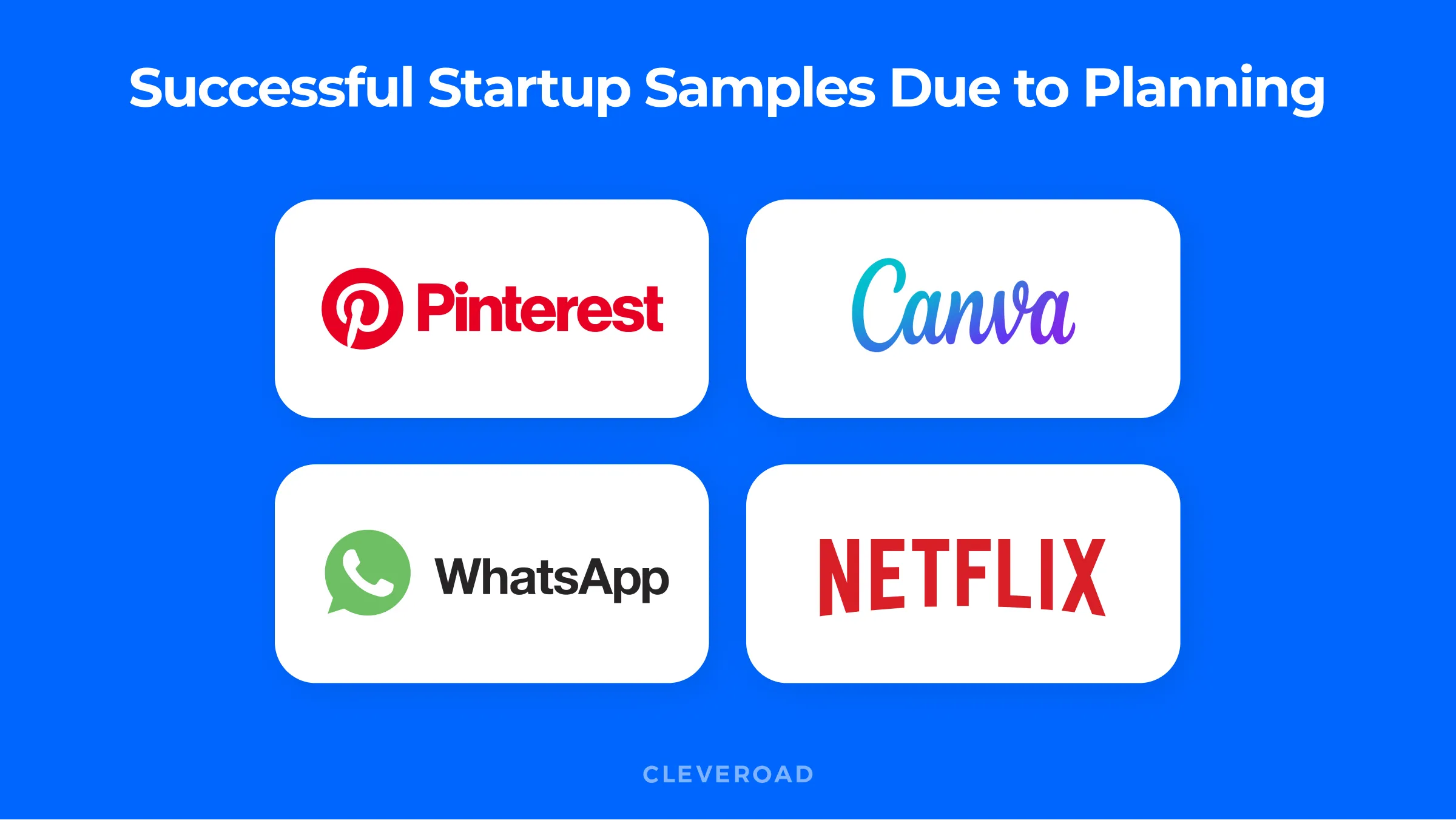
Samples of startups successful due to accurate planning
In the beginning, Pinterest was an invitation-only service. To go further on their development path, the company planned every business step, thinking about a proper UX for their product: Ben Silbermann even gave users his personal phone number to contact him about the site at any time of day or night. This perseverance paid off. Now Pinterest is a unique platform with $633 million revenue.
Canva is one of the leading graphic design platforms designers love to use for everything. This successful Australian business has raised over $US 1 billion of revenue. Due to proper scheduling policy and belief in workforce empowering, Canva CEO Melanie Perkins could make her company successful, having an audience of more than 10 million customers.
The well-known messenger allowing people to communicate worldwide was invented in a gym. When Jan Koum and his co-founder Brian Acton were annoyed with missing calls while at the gym, they created WhatsApp, which allows users to update their "status" to indicate when they are ready to accept calls. They only wanted to make a good product for customers, which approximately turned into more than $5.5 billion of revenue.
Netflix, which started its way as a rent-by-mail DVD service that required users to pay for each rental, is now worth more than $30 billion. It's a brilliant illustration of how pivoting a business model can significantly affect a company's direction. Netflix was able to further establish itself as the go-to media company by pivoting from DVD by mail to developing award-winning programming and gaining revenue of more than $US 7.5 billion .
Creating Your Own Business Plan
Strict planning of business steps was one of the essential things all the above companies had in common to grow and become more successful. We can personally propose a tech startup business plan template from Shopify that most nearly meets the points discussed above.
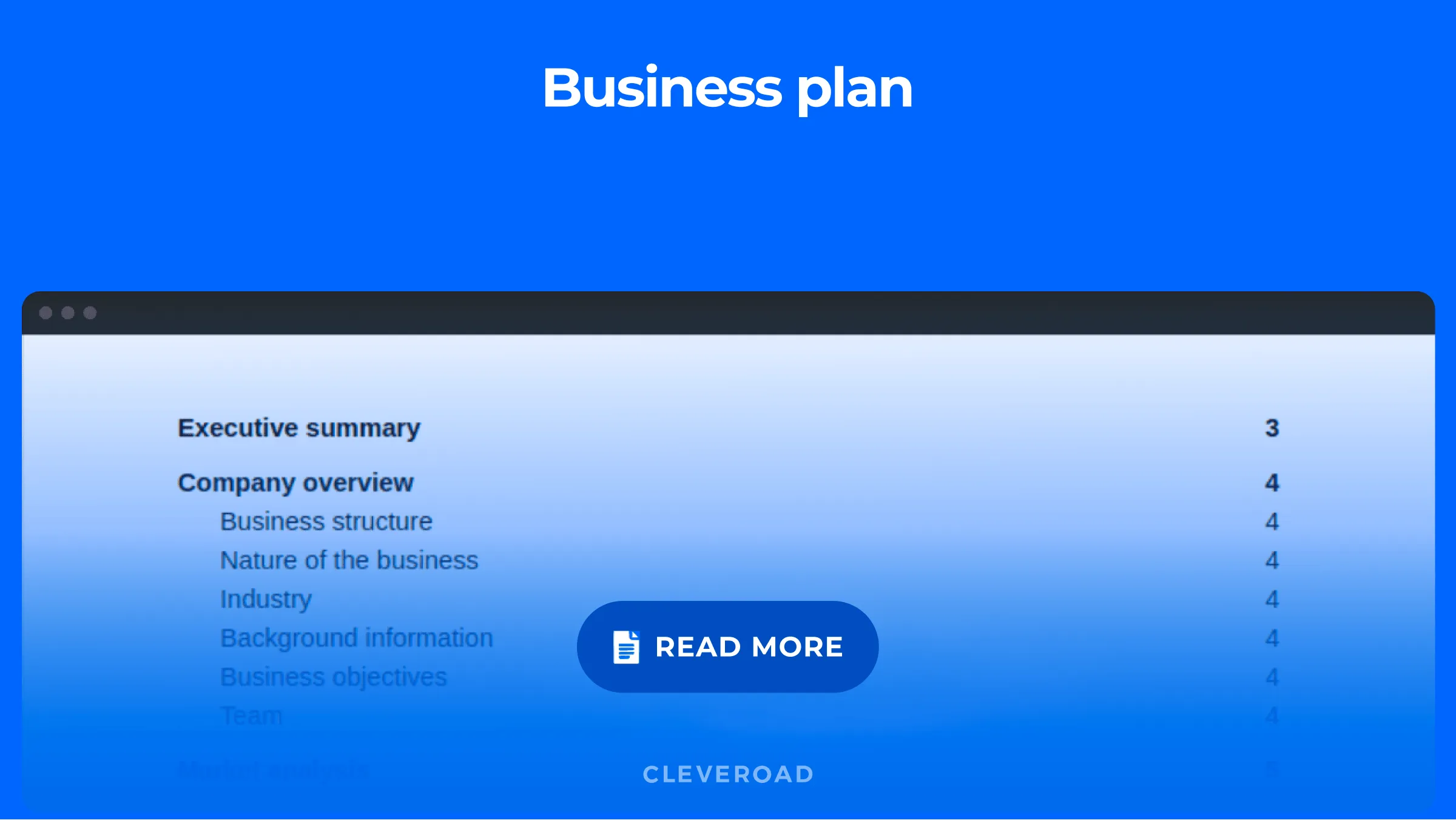
Shopify tech company business plan template
But remember that such a document will properly work if its critical blocks are created with the help of qualified experts. Cleveroad, a skilled IT consulting company and software solution provider from Ukraine, Eastern Europe, is ready to help you with initial project development phases and further ones. Since 2011, we've been assisting startups and organizations of all kinds in acquiring cutting-edge technologies.
During the collaboration with us, you’ll obtain a wide range of services, containing (but not limited to):
- Proven in-depth software development experience in a variety of sectors
- Working with high-qualified, certified, and agile-oriented Business Analysts, Solution Architects, and other tech specialists able to help you solve business issues
- Consultations from our Business Analysts and tech experts about your project
- Initial project estimates from our Sales Managers for free, with no hidden costs
- Honesty with our clients and partners as a critical component of developing outstanding products
You can also apply to us if you have problems with business plan creation. We’ll help you solve them quickly and efficiently build a software product for your business.
Order a consultation on a project
Book a call, and our Business Analysts will give you a full understanding of your software solution
Wrapping Up
Developing an information technology startup business plan is a complicated and time-consuming process that practically every company should undertake. You can adapt pre-made templates, but no one-size-fits-all template will work for every company. That’s why you may make your job easier, applying to specialists competent in software development.
A business plan can help you organize your thoughts, ideas, and even find the right people to work with. Even though making a business plan (or completing a technology startup business plan example) is a long and complex process, almost every startup should go through it.
Your startup business must have these sections:
- Executive summary. This section sums up the entire business plan and works as an introduction.
- Company description. This part reveals history, goals, team structure, and other details about your company.
- Marketing plan. A marketing plan is a representation of the startup’s competitive advantage and marketing goals.
- Financial projections. In plain language, it’s a forecast of the future revenue and expenses of your startup.
- Team structure. This section serves to familiarize investors with the hierarchy of your startup team.
- Step 1. First of all find a flexible template to jot down your business plan.
- Step 2. Write company description.
- Step 3. Define your goals, make a market research and jot down it's results in marketing plan.
- Step 4. Write financial plan.
- Step 5. Write your management team structure.
- Step 6. Sum previous section in executive summary.

Evgeniy Altynpara is a CTO and member of the Forbes Councils’ community of tech professionals. He is an expert in software development and technological entrepreneurship and has 10+years of experience in digital transformation consulting in Healthcare, FinTech, Supply Chain and Logistics
Give us your impressions about this article
Very useful article.
Thank you for helping
Thanks for the article! I'm an entrepreneur, and I've been stuck in this business plan stage. It's hard for newcomers to gather all their thoughts in one plan. But you've explained it perfectly!
Great job, very useful!
Good article. Found it interesting.
Nice piece of information. You've nailed its explanation. Besides, these templates that you've attached are really great. I think that they will suit perfectly for new startups.
May 01, 2024
Oct 05, 2023
Sep 29, 2023
- Services Product Management Product Ideation Services Product Design Design Design Web Design Mobile Application Design UX Audit Web Development Web Development Web Development in Ruby on Rails Backend API Development in Ruby on Rails Web Applications Development on React.js Web Applications Development on Vue.js Mobile Development Mobile Development Mobile app Development on React Native iOS Applications Development Android Applications Development Software Testing Software Testing Web Application Testing Mobile Application Testing Technology Consulting DevOps Maintenance Source Code Audit HIPAA security consulting
- Solutions Multi-Vendor Marketplace Multi-Vendor Marketplace B2B - Business to Business B2C - Business to Customer C2C - Customer to Customer Online Store Create an online store with unique design and features at minimal cost using our MarketAge solution Custom Marketplace Get a unique, scalable, and cost-effective online marketplace with minimum time to market Telemedicine Software Get a cost-efficient, HIPAA-compliant telemedicine solution tailored to your facility's requirements Chat App Get a customizable chat solution to connect users across multiple apps and platforms Custom Booking System Improve your business operations and expand to new markets with our appointment booking solution Video Conferencing Adjust our video conferencing solution for your business needs For Enterprise Scale, automate, and improve business processes in your enterprise with our custom software solutions For Startups Turn your startup ideas into viable, value-driven, and commercially successful software solutions
- Industries Fintech Automate, scale, secure your financial business or launch innovative Fintech products with our help Edutech Cut paperwork, lower operating costs, and expand your market with a custom e-learning platform E-commerce Streamline and scale your e-commerce business with a custom platform tailored to your product segments Telehealth Upgrade your workflow, enter e-health market, and increase marketability with the right custom software

- Case Studies

- Entrepreneurship
- Business Plan for a Technology Startup
Writing a Business Plan for a Technology Startup and the Benefits for Your Company
- 13480 views
- Jul 17, 2020

Business Analyst

Anastasiia S.
- Tech Navigator

Have a business idea but don’t know where to start? Consider creating a business plan first! An extensive and informative business plan allows you to understand your goals, opportunities, and threats, assess the market situation, and get a lot of insights to successfully launch your startup. Moreover, it can help you interest your investors.
Read our article to find out what a business plan is, what its benefits are, and how to create one. Let’s start with a definition.
What’s a business plan?
A business plan presents a detailed vision of your business idea. This document usually consists of 30 to 35 pages and several sections that cover vital topics for your business development such as goals, management, marketing, and funding.
A business plan is usually created before setting up a new business. It projects up to five years into the future to ensure you know where you’re headed at the beginning of your entrepreneurial journey. It’s advisable to revise this plan every month or two to check whether you’re sticking to your goals.
Benefits of creating a business plan
Although creating a business plan requires a lot of time and research, it’s sensible to make one before launching your startup. A business plan helps you realistically assess your opportunities and provides more benefits that we’ll describe below.
Detect weaknesses in your startup idea
When preparing a business plan, you should carry out a SWOT analysis to understand your chances of success.
To perform a SWOT analysis, you need to determine your business’s s trengths, weaknesses, opportunities, and threat s. Take into account that strengths and weaknesses are internal characteristics of your company that you can control, while opportunities and threats are external factors out of your control.
Once you’ve completed SWOT analysis, pay close attention to your weaknesses. By being aware of your soft spots, you can transform them into workable solutions to make your business successful.
- Set goals and milestones
Setting goals is one of the core ideas behind creating a business plan, since by knowing your short- and long-term goals you can clearly understand where your business is heading.
Milestones allow you to track progress toward achieving your goals. Setting milestones is a strategic step that allows you to stick to your plan and not get distracted on your way.
Once you’ve listed your goals, you need to choose the path to achieve them. There are several options to choose from. For instance, you can map a long but predictable path with minimum risks and a short path full of challenges.
Let’s consider different options for launching your MVP as an example. You can choose a soft launch: a careful step-by-step presentation of your product to your target audience. When you use a soft launch approach, you reveal your product to a limited number of users, gather feedback from them, and fix bugs quickly. Thus, we can define a soft launch as a long yet predictable way to reach your goals.
A hard launch, on the other hand, is a short and risky path, since it means presenting a new product to a large number of people at once. It can bring you immediate revenue, but at the same time it can cause a lot of problems if your product isn’t perfect.
Once you’ve distinguished two different paths to reach your goals, which one to choose is up to you.

- Make data-driven decisions
Preparing a business plan entails carrying out a lot of research. To make a realistic business plan, you should dive deep into marketing, finance, and management. You should also perform a comprehensive analysis of your direct and indirect competitors to get a full picture of the market situation.
By gathering information about other market players, you can learn about their strengths and weaknesses along with your own. This gives you a chance to better determine your company’s unique value proposition (UVP) and stand out from the competition.
With this information, your business plan is not merely a suggestion but a realistic view of your startup, the challenges you might face, and the ways you can overcome them.
- Obtain an effective management tool
With a business plan in hand, it’s easier to manage your progress. Since a business plan includes a map with milestones, you can use it to keep track of how well you stick to and achieve your goals.
A business plan also helps you check whether you’re keeping within your budget and how profitable your business is. Plus, it allows you to monitor other financial aspects such as your employees’ incomes, pay raises, and your bonus system.
- Get more information than with a Lean Canvas
Creating a Lean Canvas is a fast way to assess business opportunities. A Lean Canvas is a one-page document with 10 to 12 fields that gives a general overview of the current state of your business, your opportunities, and your goals. Although it’s a nice option for a quick assessment, a Lean Canvas is not very informative.
Here’s an example of how a Lean Canvas looks and what information it can present:

A business plan, in turn, is an extensive document that covers a long period of time (usually up to five years). Consequently, it requires a more comprehensive approach to business analysis than a Lean Canvas does and includes more detailed information about your business idea.
Use your plan as a pitch deck
Once you create your business plan, you can use it as the basis for your pitch deck. Just select the most important information and you’ll have a ready presentation for your investors, business partners, or whoever you want to interest in your business idea.
An informative pitch deck based on your business plan can lead investors to consider your business worth supporting.
How to create a technology startup business plan
Once you understand the benefits a business plan can give you, it’s time to move to developing one. Here are the must-have sections for your business plan.
#1 Executive summary
An executive summary presents your overall business plan. Its aim is to capture your readers’ attention and make them interested in reading through all the details.
This summary should be written in clear language and be understandable even for people who don’t have specific knowledge of your business area.
Do your best to outline the maximum relevant information within a five- to ten-minute read.
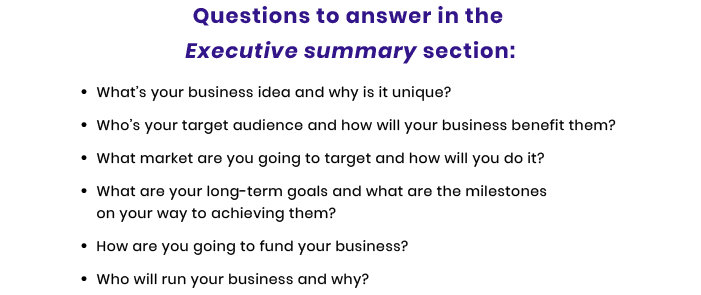
To make your executive summary informative and captivating, it’s best to write this section after you’ve finished all the other sections. Also, you should answer all these questions briefly in the summary since you’ll cover them in detail in the following sections.
#2 Business idea
This section is a detailed presentation of your product or service. You should include the following information:
- Product/service description. Cover all the characteristics of your product, its uniqueness in the market, patent issues and compliance requirements (e.g. PCI DSS for payment systems, HIPAA for healthcare, or GDPR compliance), and a description of the development process.
- Benefits for customers. Explain why your product is outstanding, how it reflects the needs of your target audience, and how it will solve your customers’ problems.
- Pricing. Calculate how much it will cost to create your product and decide what monetization approach to choose (for instance, a subscription-based model or one-time payments). Make sure your revenue will cover your expenses.

#3 Business sector and market analyses
In this section, you’ll present the results of your research that show how successfully you can penetrate the desired market.
First of all, analyze your preferred business sector. Pay attention to the current situation in the sector, predicted trends, sources of profit, and entry barriers.
Then, carry out market analysis including geographical, socio-demographic, socio-economic, and behavior-oriented segmentation of your potential customers. These criteria will help you better understand your target audience and attract more customers in the short term.
Finally, perform competition and location analyses. Competition analysis will help you determine your and your competitors’ strengths and weaknesses while location analysis will help you decide on the location for your company.
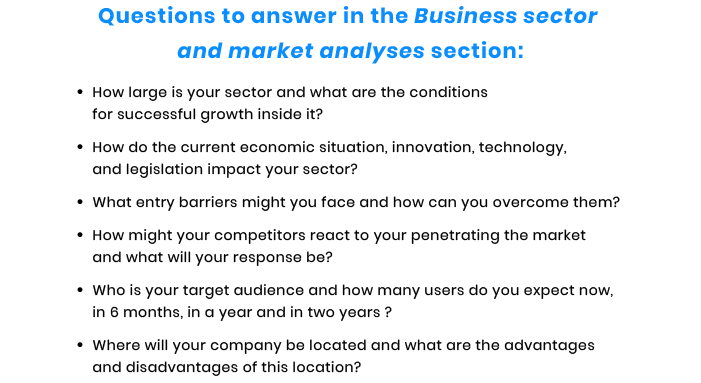
#4 Marketing strategy
This section demonstrates how you will build your marketing campaign. You already know your target audience, your competitors’ weaknesses, and the strengths of your product, so it’s time to sell it. At this stage, it’s important to decide if your marketing campaign will be extensive or targeted, what steps it will include, how many customers you need to attract to make your campaign successful, etc.
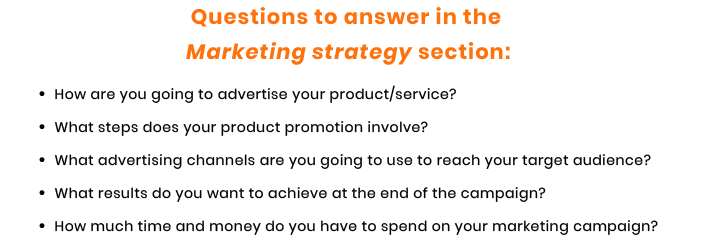
#5 Management
In this section, you should provide information about the key roles inside your company and your legal situation.
When introducing your team, it’s important to mention roles and responsibilities and the qualities that make each person a valuable team member.
By legal situation, we mean the legal structure of your company and the legal framework that determines how your startup operates. You should state whether your business is a one-person startup or a partnership, for instance.
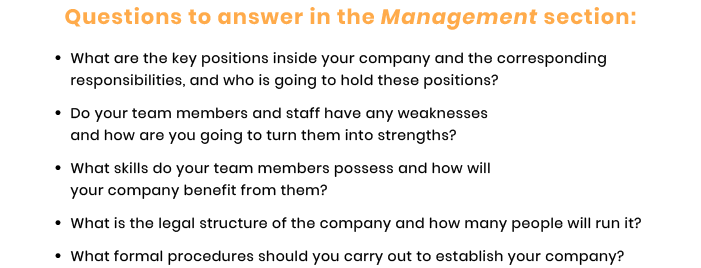
#6 Opportunities and threats
This section describes external opportunities and challenges you can face when starting and expanding your business. To present this information as accurately as possible, you should create both positive and negative forecasts based on detailed research concerning your business sector, the current market situation, upcoming trends, your competitors, etc. Use the results of your SWOT analysis to provide information in this section.

#7 Financial plan
You should prepare a financial plan for the first five years of your business activity. It should include:
- Staff costs. This is the money you’ll spend on human resources at the beginning of your business and as it grows.
- Investment and depreciation information. In this section of the financial plan, you should enumerate any kinds of material investments you plan to make (vehicles, furniture, PCs, etc.) and their predicted service life.
- A profitability plan that includes your revenue and expenses. Make sure that planned revenue exceeds your expenses. There’s no point in starting a business that isn’t profitable.

#8 Funding opportunities
This section should list sources of investment and include the amount of money you need to start your business. You should also list investment options that you’re going to use. You can choose among local banks, venture capitalists, public funding schemes, business angels, and other options.
Once you decide how you’ll fund your business ‒ take out a loan or find investors ‒ include a repayment plan or mention the conditions of cooperation with your financiers.

#9 Map for the future with milestones
In this section, you should describe the step-by-step implementation of your plan. It’s important to set priorities, divide the whole plan into small scopes of tasks, and set realistic deadlines. By doing this, you’ll get milestones that lead to your business success.
It can be a sensible idea to present milestones graphically so it’s easier for your readers to perceive the information and track your progress.

Final thoughts
With an elaborate business plan, you’ll have a clear understanding of your business opportunities and a chance to get into the desired market. Once you’ve created a comprehensive business plan, it’s time to create an MVP to attract your first customers.

What benefits does a business plan provide?
Writing a business plan is an important step before launching a startup. With a detailed business plan, you can:
- Detect weaknesses in your startup
- Have a starting point for creating a pitch deck
What sections should I include in a business plan?
There are nine main sections you should include in a business plan:
- Executive summary
- Business idea
- Business sector and market analyses
- Marketing strategy
- Opportunities and threats
- Financial plan
- Funding opportunities
- Map for the future with milestones
Is it necessary to create a business plan for my technology startup?
Writing a business plan isn’t obligatory, but you might want to do it since having a plan gives a lot of benefits. A business plan can help you understand your opportunities and threats, analyze the current market situation, learn more about your competitors, attract investors, and more.
If you already have a business plan and need help creating your MVP, contact us for professional assistance .
Rate this article!

Share article with
RubyGarage Blog
Please identify yourself to leave comments and connect with other readers
There are no comments yet
Subscribe via email and know it all first!
Thanks for your subscription!

- 16890 views

- 27344 views

- 16763 views
BUSINESS STRATEGIES
How to start a tech business
- Rachel Bistricer

If you're passionate about innovation and managing a range of technological services, starting a tech business could be an exciting venture for you. If yes, this guide will walk you through the steps of initiating and operating a successful tech business, including the advantages and challenges involved in starting a business , how to go about creating a business website to support your tech business and how to generate revenue in the tech industry.
What is a tech business?
A tech business is a service-oriented business that offers technological solutions, products and services to clients. Tech businesses typically provide services such as:
Software development and programming
IT consulting and support services
Cloud computing and storage solutions
Web development and design
Cybersecurity services
Why start a tech business?
The technology industry is experiencing significant growth and is expected to expand at a rate of 6.55% annually until 2028 . Starting a business in this sector could be highly profitable. The tech industry is a major revenue generator, with annual spending by businesses and individuals in the billions on software, hardware, and related services.
How to start a tech business in 6 steps
Create a business plan
Select a business structure
Obtain business financing or capital
Set up accounting and bookkeeping services
Source specific tech equipment
Register your tech business
01. Create a business plan
Develop a comprehensive business plan that covers key aspects of your business planning such as your target market, executive summary, marketing strategy and financial projections. This plan serves as a roadmap for your business and aids in conveying your vision to potential investors when seeking funding. It should also include other important business information such as the type of business you plan to start and your choice of a business name .
Here’s a tech business plan template to get you started:
Tech business plan template
Executive Summary
Business Name: [Your Tech Company Name]
Business Structure: [Sole Proprietorship/Partnership/LLC/Corporation]
Location: [City, State]
Founding Date: [Month, Year]
Founders/Owners: [Names]
Mission Statement: [Concise statement of the company’s purpose]
Business Description
Overview: Briefly describe your tech company, including its key features, amenities and services.
Unique Selling Proposition (USP): Clearly define what sets your tech business apart from competitors.
Target Market: Identify your primary customer demographic and market segment.
Services and Amenities
List and describe the tech services and solutions your company will offer. Include software development, IT consulting, cloud services, cybersecurity, etc.
Market Analysis
Industry Overview: Provide an overview of the tech industry, including trends and growth projections.
Competitor Analysis: Identify key competitors, and analyze their strengths and weaknesses.
Target Audience: Define your target customer profile and their preferences.
Marketing and Sales Strategy
Marketing Plan: Outline your strategies for promoting the tech company, including online and offline channels.
Pricing Strategy: Detail your pricing structure and any promotional pricing.
Sales Tactics: Describe how you will attract clients and increase revenue.
Operational Plan
Location and Facilities: Describe the physical location and facilities of your tech company.
Suppliers: List and describe key suppliers for technology and services.
Staffing: Outline your staffing plan, including roles and responsibilities.
Financial Plan
Startup Costs: Detail initial investment requirements and startup expenses.
Revenue Projections: Provide realistic revenue projections for the first 3-5 years.
Operating Costs: Outline ongoing operating expenses, including utilities, maintenance and staff salaries.
Funding Requirements: Specify any funding needed and potential sources (loans, investors).
Funding Proposal
Purpose of Funding: Clearly state how the funds will be utilized.
Amount Needed: Specify the amount of funding required.
Repayment Plan: Outline the proposed repayment plan for loans or investments.
Risk Analysis
Identify potential risks and challenges that may impact the success of your tech business.
Develop strategies to mitigate and manage these risks.
Include any additional documents or information relevant to your business plan.
Examples: Market research data, resumes of key team members, mock-ups of marketing materials.
Summarize the key points of your business plan and highlight the potential success of your tech company.
Conclude with a call to action or next steps.
Note: This template serves as a general guide. Adjust and expand sections based on your specific business model and goals.
02. Select a business structure
Choose an appropriate business entity or structure for your tech business, such as a sole proprietorship , partnership , limited liability company (LLC ) or corporation . Each structure has its own advantages and disadvantages, so select the one that best aligns with your business goals.
Learn more: How to start an LLC
03. Obtain business financing or capital
Starting a tech business involves substantial initial costs. You’ll need to secure considerable financing through methods like bank loans, grants or stakeholder investment to launch and sustain your business.
Costs that you’ll need to factor in when securing financing for your business include:
Research and development costs for software and technology solutions
Acquisition of necessary hardware and equipment
Fees for obtaining licenses and permits for tech operations
Recruitment and training costs for tech professionals
Marketing and advertising campaigns to promote the tech business
Making a website and its maintenance
Installation of necessary software and technology infrastructure
Initial inventory of tech supplies and materials
Legal fees for assistance with contracts, permits and compliance
Fees for consultants, programmers and other professionals
Costs associated with pre-launch marketing events or promotions
A reserve fund for unforeseen expenses or cost overruns
Contingency budget for the initial months of operation
Payment of applicable taxes, including business taxes
04. Set up accounting and bookkeeping systems
Establish robust accounting and bookkeeping systems from the outset to track income, expenses and ensure financial viability. This includes managing corporate tax obligations if applicable.
05. Source tech equipment
Acquire the necessary equipment for your tech business, ranging from computers and servers to software and development tools, based on the services you plan to offer. Some more specific examples of this include:
Computers and servers for software development
Programming tools and software licenses
Cybersecurity software and hardware
Cloud computing infrastructure
Networking equipment for IT services
Website development and design tools
Communication and collaboration software
Data storage solutions
06. Register your tech business
Register your tech business in compliance with local regulations, obtain the required licenses and secure appropriate insurance coverage.
Learn more: How to register a business , How to get a business license
Tips for managing your tech business for profitability
Once you’ve got your tech business off the ground, you’ll need to understand how to properly run and manage it to ensure profitability. Here are some general tips on how to achieve that.
Research your industry and gain a deep understanding of the tech industry, including market competition, target demographics and financial requirements. If you lack experience in the tech industry, consider working for an established tech company or collaborating with experienced professionals.
Develop a robust marketing strategy from the beginning to proactively promote your tech business. Creating a business website is essential for online visibility, customer engagement and promotions.
Exceptional customer service is crucial for success in the tech industry. Ensure a positive experience for clients from initial inquiry to service delivery.
Tech businesses to inspire (all built on Wix)
This software development company creates virtual meeting enhancement tools to help companies and remote teams bridge the gap between the virtual and the physical world.
Camtech-health
Camtech-health is a digital health solution company empowering individuals to take charge of their health and well-being with at-home self-collection tests that offer personalized health insights, actionable support and virtual consultations.
Valr Tech is a digital marketing agency using AI and the latest techniques to ensure that every marketing campaign is tailored to the unique needs of the client.
Benefits of starting a tech business
Operating a tech business allows you to be your own boss, set your own hours and make independent decisions. At the same time, the demand for tech services is consistently high, particularly in areas with a substantial business presence. For business owners who enjoy working with cutting-edge technology, a tech business can be rewarding on many levels.
Read more: Tech business ideas for beginners that will help you turn profit. Also, learn how to make a tech logo for your business.
Challenges of running a tech business
Tech management requires diverse skills in areas such as software development, IT consulting and cybersecurity. You’ll either need to become an expert quickly in all of these areas or invest in professionals who can excel in them.
Coordinating projects, managing client expectations and ensuring timely service delivery can be challenging. Working with project management tools and collaborative software is crucial for managing this effectively.
Tech industry competition is fierce and standing out requires a unique value proposition and effective marketing.
How profitable is a tech business?
The profitability of a tech business depends on factors such as location, market demand, competition, pricing strategies and operational efficiency. For example, tech hubs and business-centric areas often offer more potential clients but may also mean increased competition from other tech companies. Streamlining business processes can contribute to higher profitability by reducing costs and enhancing service delivery.
Other business ideas you might be interested in
How to start a construction business
How to start a car detailing business
How to start a DJ business
How to start a dog walking business
How to start a catering business
How to start a real estate business
How to start a lawn care business
How to start a food truck business
How to start a landscaping business
How to start a pressure washing business
How to start a cleaning business
How to start a tutoring business
How to start a coaching business
How to start a pool cleaning business
How to start a food business
How to start a painting business
How to start a finance business
How to start a music business
How to start an animation business
How to start an architecture business
How to start a baking business
How to start a handyman business
How to start a nail business
How to start a trucking business
How to start a rental property business
How to start a farming business
How to start a homecare business
How to start a flower business
How to start a car wash business
How to start a medical supply business
How to start a gaming business
How to start a sports card business
How to start a courier business
How to start a laundromat business
How to start a wedding business
Related Posts
The 15 best tech startup logos to check out
How to start a tech blog
11 profitable tech business ideas for beginners
Was this article helpful?
Technology Business Plans
Written by Dave Lavinsky

Position your technology venture at the forefront of innovation with our comprehensive selection of technology industry business plan examples. This invaluable resource is engineered for entrepreneurs, startup founders, and IT leaders seeking to navigate business planning in the fast-paced tech landscape. The plans presented provide a professional framework for addressing key components such as product development, market penetration, intellectual property strategy, funding mechanisms, and scaling operations.
Technology Business Plan Templates
Mobile App Business Plan Template
SaaS Business Plan Template
Software Business Plan Template
Technology Business Plan Template
YouTube Business Plan Template
Internet Cafe Business Plan Template
Network Marketing Business Plan Template
Social Media Marketing Business Plan Template
Cybersecurity Business Plan Template
How to Create a Tech Startup Business Plan and Succeed
- Updated on 5 Mar 2024
Like Abraham Lincoln spending four hours sharpening his ax before chopping down a tree in six, proper planning is essential for launching a successful tech startup in 2024.
Sure, coming up with a great idea is the first step, but having an organized business plan to execute that vision is what separates the startups that thrive from those that flounder.
Despite the rewards, the tech industry is intensely competitive.
In their excitement, many founders with creative ideas overlook crafting a solid business plan and rush into launch.
A well-structured business plan serves as the driving force behind a startup’s growth and success. It allows tech entrepreneurs to set ambitious goals, secure early funding, track progress, and assemble the necessary resources.
This article provides tech founders with a comprehensive guide for creating a business plan tailored to launch a thriving startup.
It outlines practical steps to craft a strategic vision and set measurable objectives so those long hours sharpening your “ax” pay dividends down the road.
With the proper preparation, a thoughtfully laid plan, and commitment to persistent execution, your tech startup can chop through the competition.
Ready to Bring Your Idea into Reality?
Unlock your startup potential now — start transforming your vision into a scalable solution with our expert developers today!
What is a Business Plan, and Why Do You Need It?
A business plan is an outlined process documentation of a company’s goals and how it intends to achieve them by laying out the roadmap for all different business aspects like marketing, finance, and operations.
Before creating a well-structured business plan, knowing why you need one is essential.
Writing a business plan for tech startups helps in assessing the startup opportunities realistically, in addition to other benefits such as:
- A better understanding of the business and its objectives
- Forecast the financial needs and expenses
- Build a development strategy
- Attract investors and support fundraising campaigns
- Pitch deck to prove the startup will last and grow
- Prepare the company to face critical challenges and overcome them
- Analyze the targeted market and competitors
Creating a Business Plan for Your Tech Startup
Now that you clearly understand what business plans are used for, it’s time to take the first step. Therefore, we’ll demonstrate the practical steps of how to start a business plan.
Step 1. Write a Company Description
A startup description is an overview of the business that answers two main questions: ”Who is the founder behind the startup?” and “What will the founder undertake to guarantee the startup’s success?”.
It provides extensive details about the business approach, includes all the required elements to grab investors’ attention, can be utilized as a startup pitch deck, and usually contains the following information:
- Tech startup business name and location
- The vision and mission statements
- Long-term and short-term goals and objectives
- The legal form of ownership, e.g., LLC, cooperation, etc
- Products, services, and targeted market
- Starting date with a brief history of how the idea came up
- The startup’s strength points and competitive advantages
- A summary of founders and team members
You can never learn how to create a business plan for a startup without drafting some fundamental ideas and then developing the content gradually until it covers all the requirements and conveys the complete business information.
Most importantly, everything about the tech startup must be explained in detail in this section.
As for the business structure, the registration process could be tedious so it is advisable to consult experts before deciding if it is best to start an LLC , a sole proprietorship, or a corporation.
Registering the business helps your clients to verify your business and give the assurance that it is legitimate and trustable.
Step 2. Draft an Executive Summary
While learning how to make a startup business plan, many founders confuse the executive summary with the business description.
But the truth is, it’s like the difference between the movie trailer and the movie itself!
The executive summary provides a brief overview of the business plan using short, clear, and concise language.
Although it has the same structure as a business plan, information must be demonstrated briefly and straightforwardly.
However, the executive summary must include the following key elements:
- Startup goals and objectives
- Products and services
- Targeted market and potential opportunities
- Competitor analysis
- Marketing and sales strategy
- Financial outlines
Step 3. Identify Your Target Market
The target market is the core customer base, and identifying it ensures the business is on the right track and the cost-effectiveness of marketing efforts.
Knowing the customers’ needs, motivations, demographics, and other relevant information will help determine what customers want and are willing to spend.
The following questions help in target market identification:
- Who are the tech startup customers? Their gender, age, profession, income, etc.
- Where are they located?
- What do they think? What are their interests?
- What do they like and dislike?
- What do they do for a living?
- Are they online users or offline customers?
The more details are known about the target market, the tech startup’s success chances increase, and investors will become more likely to support the business.
Moving forward, it’s time to learn about market research in detail.
Step 4. Conduct Market Research
The market research provides deep insight into the targeted audience and the startup product-market fit.
It’s one of the best methods for target market identification that eliminates the concerns about whether there is a market for the startup or not.
Instead of jumping in and dumping tons of investments on a tech startup doomed to fail, market research empowers informative decision-making based on real-life input.
This stage is especially useful if you’re thinking about selling your business after it’s grown.
Conducting market research answers the fundamental questions all tech startups ask:
- Is the product or service helpful for customers?
- Does it solve a current problem for end-users?
- Will they pay that amount of money for such a solution?
There are several methods to conduct market research, such as:
- Survey: online and offline surveys are the most used form of market research
- Use survey templates to streamline the process.
- Interview: an individual conversation with members of the target market
- Observation: observing the ideal customer behavior while using the product or service
Step 5. Analyze Your Competitors
As a startup, it’s essential to determine what makes you stand out from the crowd.
Competitor analysis helps to figure out market positioning by answering the following questions:
- Why should customers buy the startup product or service?
- Why wouldn’t customers buy the currently available products in the market?
- How can the startup improve the current competitor products available in the market?
Answering those questions and knowing who the competitors are, their strengths, and weaknesses will allow the tech startup founders to understand how to be unique and overcome competitors effectively.
TypeScript Developers
Find the best TypeScript developers for your project.
Step 6. Develop a Financial Plan
The tech startup business plan template usually embodies a financial projection and analysis for the first five years of business activity.
The financial plan will ensure the startup is profitable, supporting the investment’s decision-making.
It’s highly recommended to have a reasonable and realistic financial plan away from being optimistic not to mislead investors.
Moreover, there’s no need to show an exaggerated profitable projection because investors know that startups can’t make profits from the beginning.
The critical elements of a successful financial plan are:
- Capital fundraising expectations and methods
- Revenue streams to describe how the startup will generating passive income
- Human resources cost spent on staffing and development
- Major expenses in the form of predictions of mega payments
- Financial milestones to provide a detailed expansion strategy
Step 7. Consider Crowdfunding for Fundraising
It’s vital to demonstrate potential fundraising methods for collecting the necessary capital to launch the tech startup.
Crowdfunding is an efficient fundraising method, especially for innovative tech projects, and many international platforms are dedicated to organizing crowdfunding campaigns.
Leveraging fundraising software could additionally enhance and streamline these processes.
However, before raising the topic, startup founders need to check different platforms and examine their advantages to decide on the most suitable one.
Check Kickstarter vs. Indiegogo as two significant crowdfunding trustworthy platforms, and explain the reasons behind your selection in the financial plan.
Step 8. Create a Marketing and Sales Plan
No tech startup survives without sufficient marketing and sales strategies.
While the marketing strategies promotes the startup’s products and services, the sales plan provides channels that enable customers to purchase them, such as e-commerce.
This tech startup business plan section outlines acquiring prospects and converting them into buyers. It includes the following basic points:
- A well-explained description of brand awareness campaigns
- Pricing plans and potential sales channels
- Marketing campaigns and available platform
At this point, you might feel lost with all those details, and to make things easier for you, later in this article, we’ll demonstrate the most popular software for a business plan with a brief introduction for each.
Step 9. Structure Your Team
The business plan should include a team structure to assign responsibilities within a structural hierarchy.
In other words, the team structure part of the business plan explains who does what.
For example, a venture capitalist, a marketing professional, and an engineer founded LinkedIn in 2003.
Another example is Amazon, which Bezos didn’t start on his own.
Besides him and his wife, he had a handful of 21 employees to help kickstart the project; a software engineer, a catalog specialist, a merchandise website editor, an IT director, an information architect, a marketing specialist, and others on the operations side of the business.
A standard organizational structure of a tech startup consists of the following:
Board members
The members of the board of directors must be listed in the business plan.
Each one of them must be introduced by name and board position.
Additionally, provide a background including education, experience, skills, etc. Adding an appendix with the executive directors’ resumes is a plus.
Management Team
Investors will be interested in the management team and their previous experience in the tech industry. Therefore, provide a detailed description of their skills, responsibilities, and proven track record of prior work.
The startup team will consist of specialists and professionals whose respective skill-sets complement one another.
A tech startup team usually includes graphic designers, inbound marketing experts, and expert coders.
Make sure to present their professional experience and the merits of each one to convey the value they add to the business.
Following, we’ll talk about the best software for creating a business plan:
Software to Help Write a Business Plan
Business plan softwares walks users through each section mentioned above and provide expert advice about the overall document. Here is a list of the top 3 software we recommend for this purpose:
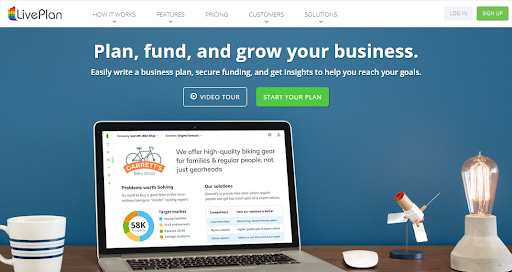
Liveplan is software that provides a modern, rich template business plan with a superior user interface, easy-to-use features, and various options.
- Create as many business plans as you want
- Utilize a vast library of 500+ business plan templates
- Export your business plans ar Word or PDF files
- Build a creative pitch executive summary
- A step-by-step practical guide for software users
- Pay $15 per month for the annual plan
- Pay $18 per month for the six-months plan
- Pay $20 per month for the monthly plan
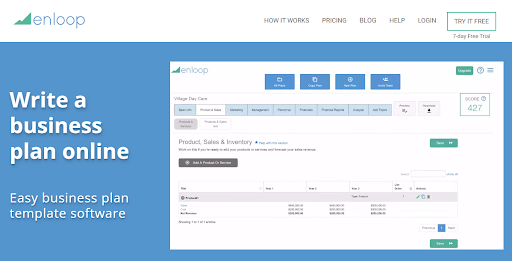
Enloop creates simple and fast business plans. It’s dedicated to creating business plans with automated text writing, financial forecasts, and real-time performance scores.
Maximize Your Agency's Potential – Go White Label Today!
Access premium design and development services for unmatched success.
- Generate texts automatically and customize them later
- Generate editable financial statements
- Analyze and compare the financial performance
- Identify the business plan issues with pass and fail reports
- Utilize the 7 days free trial to test the platform
- Pay $19.95 per month for the detailed plan
- Pay $39.95 per month for the advanced performance plan
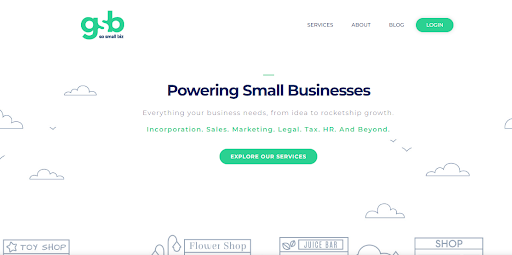
Gosmallbiz is a multiple business management tools platform.
For tech startups, Gosmallbiz is an excellent choice as it offers not just business plan making but also access to business continuity planning software to create a road map or build a website and other features.
- Many business-plan templates relevant to the tech industry
- User-friendly business plan building wizard
- Free website building tool and hosting
- Library of business documents
- Advanced dashboard for digital marketing
- Library of helpful business courses
- Pay $39 per month with no contracts and a free cancellation program
Ready to Build Your Product?
Creating a solid business plan is a crucial first step for any new tech startup.
With a solid business plan, you’ll be prepared to start building your minimum viable product (MVP) and discovering if you have a product-market fit.
Our team specializes in MVP development , taking your validated concept and efficiently bringing an initial product to market to start gathering real-world feedback.
If you’re ready to take the leap with your tech startup idea, we’d love to learn more about your business goals and how we can help.
Reach out today to chat with our startup specialists.
We offer free consultations to hear your vision and provide candid advice on the next best steps for testing assumptions, building traction-driving products, raising funds, and ultimately – growing a successful and scalable company.
Our CEO, Max, has an impressive 11-year background in SaaS development. His strong analytical skills have played a critical role in driving the company's growth and success in the highly competitive tech landscape.
Subscribe to our blog
Recommended posts, the best hr software solutions for your business.
Whether you are running a startup or a big enterprise, having reliable HR software is a must. HR tools were created to…
The Ultimate Guide to Electronic Medical Records: Benefits and Challenges
Is it profitable to launch a healthcare solution like EMR in 2024? Well, in the post-COVID world, venture capitalists find it harder…
The Future of HR: Human Resource Management Systems
There are many HRMS solutions available on the market. However, finding the one that matches your needs can be challenging. In this…
Product Discovery Phase: What It Is & Why It Matters in Software Development
Imagine investing months of effort and thousands of dollars into developing a software product, only to find out that nobody wants it….
How Cloud Migration Discovery Works and Why It’s Important
According to a McKinsey report, by the end of 2024, most companies aim to spend $8 out of every $10 on cloud…
Software MVP Development: What It Is & Why You Need One
An MVP, or minimum viable product, is a term often heard in the business and startup world. Even those not directly involved…
A Comprehensive Guide to Healthcare IT Outsourcing
According to Deloitte’s 2022 Global Health Care Outlook, the healthcare IT outsourcing market is predicted to reach $390.7 billion by the end…
How Much Does iOS App Development Cost in 2024?
Have you ever wondered how much time people spend on their favorite mobile apps? According to the DataReportal, smartphone users spend about…
How to Build Software as a Service? A Comprehensive Guide for 2024
If you’ve been thinking about building a SaaS application, we have good news for you! First, now is the perfect time to…
How to write a business plan for a tech startup

Even the greatest new business ideas could fail to get off the ground without the right launch plan. Any potential investors, venture capitalists, lenders, and potential customers want to know what your new tech business is about and what your goals are.
Do startups need a business plan? Generally, no they aren't required, but it can make it easier for investors, lenders, and customers to understand your ideas. It serves as a roadmap to how you’ll succeed, with an in-depth look at your business needs, business opportunities, and how you’ll proceed each step of the way.
A good business plan also gives you a chance to focus on all aspects of your business, spot potential problems before they arise, and make sure you’ve thought through your strategy. The right business plan can save you time and money later on.
What are the most important elements of a tech startup business plan?
The key elements of a business plan identify what products or services you’ll offer, why customers would choose your company, and who your competitors are. It highlights your goals and your strategy for accomplishing them.
Of course, there’s more to a successful business plan than the above basic elements. So what should a tech startup business plan include? Here are eight topics to include:
1. Executive summary
Think of this as your “elevator pitch.” It’s something that anyone who reads your business plan will focus on, to get an idea of what your business is about.
The executive summary should include:
- A description of your business operations, including its products and services
- Your target market and potential customers
- Your top competitors and what sets you apart from them
- Your company’s goals, both short-term and long-term
- The background and business history of yourself and your team
- Financial information, such as your investors and any customers you may have lined up
You might also include a mission statement, an identification of key stakeholders, and a SWOT analysis of your strengths, weaknesses, opportunities, and threats.
2. Company description
This should offer a more detailed explanation than what’s included in the executive summary. It outlines your business model, your day-to-day operations, your business's location, how you’ll provide value to your customers, and your business’s strengths and weaknesses.
You might also include potential obstacles and how you’ll overcome them, which new products or services you’ll offer, and your plan for product development or software development.
3. Products and services
Every product or service you intend to offer should have a detailed description of its purpose and why a customer would choose to buy it.
Think of this as the “why” your tech company will succeed and how your customers will benefit from doing business with your company. What problems do your potential customers have and how will you solve them?
4. Market analysis
Potential investors will want to see that you’ve done your homework and can demonstrate a demand for what your business will offer with a market and competitive analysis. This explores what you have to offer, how you compare to the competition, and your target customers.
Your startup’s market research should include:
- Demographic information for your target market, such as their age, income, and location
- The needs of your potential customers and how your company will meet them
- Your main competitors and an analysis of their products or services
- How your products or services compare to your competitors
- How your company will set itself apart from the competition
5. Marketing plan and sales strategy
Once you’ve identified your competitors and potential customers, you’ll need to figure out how you’ll reach those customers, spread the word about your company, and gain a competitive advantage over other businesses.
Your marketing strategy should define your marketing and sales objectives, a method for meeting those objectives, and by what metrics you’ll measure success. You might base this on sales revenue, customer acquisition, profitability, or your market share compared to your competitors after your first year.
It’s important to think realistically when setting your sales and revenue objectives. A potential investor will want to see that you’re ambitious, yet rational about your business plans. You might be better off if you under promise and over deliver in your sales objectives.
There are many items you might address in your strategy:
- How will you meet your marketing goals?
- Will you market your business internally, externally, or a combination of the two?
- When do you need to hire your marketing and sales teams?
- What marketing channels will you use? Traditional advertising? Social media (LinkedIn and Facebook)?
- Your target audience
- Your sales plan and marketing and sales budgets, from startup to product launch
6. Operational structure
This should include detailed information about your co-founders, your management team, and their qualifications and experience. It should also highlight what their roles will be within the company.
You might include an organizational (org) chart that gives an idea of how your company will be organized, with the names and duties of each team and team member. Even if you don’t have all of these positions filled, an org chart can help you plan for future hiring and outline how your business will grow.
Your operational plan could also include a hiring strategy that gives an idea of when you expect to fill each position, job descriptions for each role, and the qualifications needed for each of them. Your hiring plan could also give a salary range for each position and how you’ll recruit new employees.
7. Financial plan
Your financial plan should go beyond a simple balance sheet to explain how your business is funded, what your monetary needs will be in the future, and how you’ll meet them. It should include estimates and forecasts for the next five years.
This could be based on financial trends within your industry and projections on future revenue growth and expenses. Any investor or lender will want to see this information before they’ll do business with you.
Financial plans typically include:
- Financial statements and financial projections
- Cash-flow statements
- Capital expenditure budgets
- Pricing information
- Profit margins
You might also include an estimate on when your startup will start to break even and turn a profit.
8. Key milestones
This section should include key target dates for your business and how you’ll measure success, such as:
- When you expect to become fully funded.
- Development milestones for your products and services.
- Target dates for product launches.
- Whether you expect to go public and when it could happen.
- When you expect to become profitable.
- Your number of employees and projected staffing levels.
- Any customers or contracts you have or expect to have in the near future.
Find the right business insurance coverage for your startup
[video: an illustrated header displays the Insureon logo and the text: "What insurance do I need for my startup business?"]
NARRATOR: Starting a business often comes with the same or even greater risks that bigger, established businesses face. But having the right insurance coverage will protect your business from costly legal fees, repairs, and medical expenses.
There are several insurance policies you can carry that offer valuable peace of mind, and safeguard your new business.
General liability insurance covers third-party accidents, such as customer injuries or property damage.
[video: an illustrated header displays the text: "General liability covers: Slip-and-fall accidents; Client property damage; Product liability lawsuits"]
Commercial property insurance covers costs if your business property is damaged, destroyed, or stolen.
[video: an illustrated header displays the text: "Commercial property covers: Fires; Storm damage; Equipment theft"]
A business owner's policy, or BOP, bundles general liability and commercial property coverage together. It typically costs less than buying both of these policies separately.
[video: an illustrated header displays the text: "A BOP covers: Client accidents; Stolen or damaged property; Business interruptions"]
Errors and omissions insurance will protect your business from lawsuits related to work mistakes and oversights. This policy is also referred to as professional liability insurance.
[video: an illustrated header displays the text: "Errors and omissions (E&O) covers: Accusations of negligence; Missed deadlines; Errors that cost clients money"]
Cyber Insurance can help your business financially recover from data breaches and cyberattacks.
[video: an illustrated header displays the text: "Cyber insurance covers: Data breach notification costs; Data breach investigations; PR costs for reputational harm"]
Workers compensation insurance is required in most states and can shield your startup from work-related medical costs.
[video: an illustrated header displays the text: "Workers' comp covers: Work-related medical expenses; Disability benefits; Lawsuits from employee injuries"]
Commercial auto insurance protects your business from auto accidents involving company-owned vehicles.
[video: an illustrated header displays the text: "Commercial auto covers: Auto accident injuries; Property damage caused by vehicles; Vehicle theft and vandalism"]
Employment practices liability insurance helps pay for legal expenses if an employee sues your startup for discrimination, harassment, or wrongful termination.
[video: an illustrated header displays the text: "Employment practices liability covers: Wrongful termination claims; Discrimination lawsuits; Other violations of employee rights"]
Directors and officers insurance covers lawsuits related to decisions made by officers and board members on behalf of your startup.
[video: an illustrated header displays the text: "Directors and officers insurance covers: Lack of transparency; Mismanaged funds; Failure to comply with regulations"]
So, why is it important for you to have insurance for your startup?
[video: an illustrated header displays the text: "Why is insurance important for a startup?"]
You may need coverage to sign a contract or lease. You also might need insurance to comply with federal, state, and local laws.
[video: an illustrated header displays the text: "Startups may need insurance to: Sign a contract or lease; Apply for a loan; Comply with federal or state laws"]
Additionally, insurance protects your startup from catastrophic losses that could shutter your business. Plus, the right coverage can help you gain client trust, as well as attract top talent to your startup.
[video: an illustrated header displays the text: "Insurance can also help: During business closures; Gain client trust; Attract talent"]
Get the best coverage for your startup with Insureon today. Click the link to get started.
[video: an illustrated header displays the text: "Insureon is your #1 agency for small business insurance"]
[video: an illustrated header displays the Insureon logo]
Protect your investment
It takes time, money, and a lot of work to launch a tech startup. Your business plan can’t foresee every contingency, so you’ll need to make sure you’re financially protected against the unexpected.
Insurance companies look at a variety of information in setting premium rates, including your history of claims. With a new company, an insurance organization may want to see your business plan. It gives insurers an idea of what your business is about and what kind of risks you face.
The type of business insurance you’ll need for your startup depends on many things, though you’ll likely need general liability insurance . It’s typically the first policy for every new business. It covers common business risks such as customer injuries, damage to a customer’s property, and advertising injuries.
Beyond general liability, other policies you should consider include:
- Commercial property insurance . If you rent space for your startup, your landlord will probably require you to have coverage. This policy insures against stolen or damaged business property in the workplace.
- Commercial auto insurance . Additionally, if your business owns or leases a vehicle, you’ll be required to have a commercial auto policy, since a personal auto policy won’t cover any work-related accidents.
- Business owner’s policy (BOP) . This bundle includes both general liability coverage and commercial property insurance. It's usually less expensive than buying these policies separately.
- Cyber liability insurance . Also known as cybersecurity insurance, this policy insures you against the cost of a data breach or malicious software attack.
- Technology errors and omissions insurance (tech E&O) . This policy includes both errors and omissions insurance and cyber liability insurance. If a client claims your work was late, inaccurate, or not delivered, this policy would cover the cost of a lawsuit or settlement.
- Workers’ compensation insurance . Required in most states for businesses with employees, workers’ comp covers medical costs and disability benefits for employees who suffer a work-related injury or illness.
- Fidelity bonds . Fidelity bonds provide reimbursement for your client if one of your employees steals from them, including theft by electronic funds transfer. They're also called employee dishonesty bonds.
Having the right insurance partner can help
We can help you find the right insurance for your tech startup. Complete Insureon’s easy online application today to compare insurance quotes from top-rated U.S. carriers. You can also consult with an insurance agent on your business insurance needs. Once you find the right policy for your small business, you can begin coverage and get your certificate of insurance in less than 24 hours.

Mike Mosser, Content Specialist
Mike spent several years as a reporter and editor covering politics, crime, and the world financial markets. He’s worked for several newspapers, a financial newswire, and a monthly magazine. As a copywriter, Mike has produced SEO-based content, marketing, public relations, and advertising work for a variety of companies.
Get business insurance quotes from trusted carriers
How and Where to Write About Technology in Your Business Plan

6 min. read
Updated October 27, 2023
Often, a business plan introduces a new technology that requires some explaining.
On one hand, as a reader of business plans for investors, I see way too many business plans that ask a reader to wade neck-deep through technology to get to the business. That’s a great way make your reader run in the other direction! It’s a business plan, not a term paper or thesis. Establish technology as a differentiator, when it is. Tell me about it in relation to its importance to the business. Don’t force me to understand it when I don’t need to.
On the other hand, as a writer, manager, and user of business plans as tools for steering a business, I believe you should discuss your technology in the plan for any business. Even if technology isn’t the driving force of your business or your main differentiator, these days, almost all businesses have to manage technology as part of branding, marketing, and communications.
To the extent that technology matters, I want to see it in the priorities and in specific milestones. Are we developing what we should? Are we using what we should? Are we competitive with tools and process?
- Let your business purpose be your guide
The point of my opening paragraphs is that the right way to handle technology in a plan depends on the context of the plan. As always, in business, form follows function.
As you develop technology descriptions, priorities, milestones and such in your own business plan, consider first the business plan’s purpose.
Business plans aren’t all the same. They are used for different things, such as:
- Some business plans are intended for outsiders, as summary and description of the business, to serve the purpose of raising money with investors, backing up a commercial loan document, and so forth. In these cases the purpose of describing your technology is validation, proof of value; you’re making your technology part of the reasons that your business is a good investment or a good risk for a loan.
- Most business plans are intended to optimize management and allow business owners and management teams to better steer the business. For these plans, technology is not describing, but rather planning, setting milestones, dates, priorities, directions, and so forth.
- Technology in a plan for outsiders
Investors, bankers, and other outsiders look at technology as part of the secret sauce, the things that make your business better than competitors, defensible, or differentiated. They want to know about the technology for its business impact. But they rarely want to wade through the ins and outs of how that technology works and evaluate it for themselves. They want to know about the technology, not know the technology. The only exception is the technology they know and work with themselves.
To explain the difference, let’s take me as an example:
I’m a software entrepreneur, and, in recent years, a member of an angel investment group. I looked to scientists in the group to evaluate technology when we invested in molecular chemistry that can ease the pain of chemotherapy. I get involved in detail when the group is looking at startups in software, web, mobile apps, or financial forecasting.
When a business plan involves expertise in software, the web, apps, and technologies related to financial forecasting, I’m curious, and I’ll look for an appendix with interesting details. I’ll join in the due diligence for my angel group, test for myself, and develop my informed opinion. In fact, during my consulting years in the 1980s and 1990s, I had multiple consulting engagements with venture capital firms that contracted me to evaluate software as an expert.
When a business plan involves pharmaceuticals, medical electronics, biotechnology, clean energy, and so many other technologies that aren’t within my areas of expertise, I validate as I suggested above, with background checks, patents, and so on. I don’t, however, wade through scientific documentation.
I’m comfortable with what I don’t know. When it involves my specific investment group, I trust other members who do know.
The detailed look at the technology comes during due diligence, not in the plan or during the pitch. For plans and pitches, we look for the patents, customer testimonials, and backgrounds and achievements of the team as validators. We want to see those for sure, and we expect good summaries as part of the business plan discussion of product-market mix, or company background (in either section, whichever seems better to the founders). Technical background and technical details go into appendices, or extra docs used for due diligence, not the main body of the plan.
Brought to you by
Create a professional business plan
Using ai and step-by-step instructions.
Secure funding
Validate ideas
Build a strategy
- Technology in business planning for owners and managers
For business owners, I recommend a lean business plan as a dashboard and GPS. It’s just big enough to steer the business. It skips the text summaries and descriptions you won’t need because it’s for your own use only. It’s reviewed and revised frequently. It includes strategy and tactics as summary bullet points to serve as reminders. It includes milestones and schedules too.
Since the lean plan is just for you and the team, not for outsiders, it doesn’t necessarily include or cover your technology. Does your technology differentiate your business from all others? Is it vital to staying competitive? Does it create barriers to entry? Does it create competitive advantage? If you answer yes to any of those questions, then you are probably already managing technology as part of your strategy and tactics. So you include bullet points related to technology in your lean plan, in strategy, tactics, milestones, and schedules.
For example, tech businesses managing product development road maps, research and development teams, extending software features or tech features in hardware would be likely to build strategy and tactics around technology. More traditional businesses, on the other hand, such as real estate, restaurants, or personal training, would be less likely, on average.
But, even within traditional businesses, some innovative leaders set themselves apart for the use of new technology. Maybe the real estate brokerage is working on its app to show houses, or the restaurant is developing new techniques for cold pressed processes. Maybe the personal trainer is offering subscriptions to remote workouts.
The key to where technology goes into your lean plan is the execution and management. You don’t describe for description only. Instead, you list tasks and deadlines and action points. If there are none of those related to technology in your business, then leave it out of the lean plan.
- Stick with the business purpose
Remember, a business plan is about business. It’s not a forum for showing off. Even in the case of a show-off business plan for angel investors, keep to the business side of it. The business plan is about what you’re going to do, not what you know.
Give the investors what they need to know, and spare them from the rest. They’ll thank you. For you business owners and managers, how you develop and manage technology is a critical factor for steering the business. Make sure you plan for it, with reinforcement in strategy, tactics, and milestones to develop accountability and keep you on track.
Tim Berry is the founder and chairman of Palo Alto Software , a co-founder of Borland International, and a recognized expert in business planning. He has an MBA from Stanford and degrees with honors from the University of Oregon and the University of Notre Dame. Today, Tim dedicates most of his time to blogging, teaching and evangelizing for business planning.

Table of Contents
Related Articles

6 Min. Read
How to Write Your Business Plan Cover Page + Template

4 Min. Read
How to Write About Sourcing and Fulfillment in Your Business Plan

10 Min. Read
How to Set and Use Milestones in Your Business Plan

How to Write a Competitive Analysis for Your Business Plan
The Bplans Newsletter
The Bplans Weekly
Subscribe now for weekly advice and free downloadable resources to help start and grow your business.
We care about your privacy. See our privacy policy .

The quickest way to turn a business idea into a business plan
Fill-in-the-blanks and automatic financials make it easy.
No thanks, I prefer writing 40-page documents.

Discover the world’s #1 plan building software
Small Business Trends
50 tech business ideas: unlocking success in the digital age.

Table of Contents
Understanding the Tech Business Landscape
A few things have given this rocket a boost. Think about mobile technology. As more folks got their hands on smartphones, the need for mobile apps and services shot up.
Identifying Profitable Tech Business Niches
Choosing the right small business ideas in the tech industry is a lot like finding the right pair of shoes. It’s got to be a good fit. To increase your chances of success, it’s smart to find a niche within the tech space.
Or take cybersecurity. With more data stored online, protecting it has become a top priority. A cyber security startup could be your ticket to success if you’ve got the skills to keep information safe.
Criteria for Crafting Successful Tech Business Ideas: Our Methodology
50 innovative tech business ideas.
| Tech Business Idea | Brief Description |
|---|---|
| Mobile App Development | Craft innovative applications for smartphones and tablets that solve problems and entertain users. |
| Web Design Business | Design attractive, user-friendly websites that help businesses increase their online presence and drive sales. |
| Digital Marketing Agency | Help businesses reach their target audience and increase their online visibility through SEO, content marketing, social media, and PPC campaigns. |
| Artificial Intelligence Consultancy | Provide businesses with expert advice and solutions on implementing AI technologies to improve efficiency and decision-making. |
| Ecommerce Business | Sell products or services online, offering customers a convenient, accessible shopping experience. |
| Virtual Reality Gaming Company | Create immersive virtual reality games that offer players a uniquely engaging experience. |
| Cybersecurity Services | Protect businesses from digital threats by providing security audits, defense strategies, and recovery solutions. |
| Cloud Computing Services | Offer businesses scalable, efficient solutions for data storage and access, improving their operational efficiency. |
| Chatbot Development | Create intelligent chatbots that improve customer service and engagement on business websites and social media platforms. |
| Smart Home Automation | Provide solutions that make homes more efficient, convenient, and secure using IoT technology. |
| SaaS Solutions | Develop and offer subscription-based software services that businesses can access over the internet. |
| Drone Services and Technology | Provide drone services for photography, delivery, surveillance, or create innovative drone technology. |
| IoT Solutions | Develop IoT-based solutions to improve efficiency and productivity in homes, businesses, or cities. |
| Blockchain Consulting and Development | Help businesses leverage blockchain technology to improve transparency, security, and efficiency. |
| Online Education Platform | Create an online platform where users can access educational resources and learn new skills at their own pace. |
| Augmented Reality Applications | Develop AR apps that provide interactive and immersive experiences for users in gaming, retail, education, and more. |
| Niche Social Networking Platform | Create a social networking platform focused on a specific interest group, providing a dedicated space for interaction and engagement. |
| Big Data Analytics and Consulting | Provide big data solutions and insights to help businesses make informed decisions. |
| IT Support and Managed Services | Offer IT support services like troubleshooting, system management, and network security. |
| Wearable Technology Development | Design and develop wearable tech like smartwatches or fitness trackers that help users monitor their health, fitness, or other activities. |
| 3D Printing Services | Offer 3D printing services for prototyping, product development, or customized items. |
| Online Marketplace for Freelancers | Create a platform where freelancers can offer their services and businesses can find talent to meet their needs. |
| Subscription Box Service for Tech Gadgets | Offer a curated selection of tech gadgets delivered to customers' doors on a regular basis. |
| Health Tech and Telemedicine Solutions | Develop tech solutions that improve healthcare delivery, such as telemedicine platforms or health monitoring apps. |
| Video Game Development Studio | Develop engaging video games for various platforms including PCs, consoles, and mobile devices. |
| Podcast Production and Editing | Offer services to produce, record, and edit podcasts for individuals or businesses. |
| Livestreaming Platform | Create a platform where users can broadcast live video content to viewers around the world. |
| E-Sports Platform and Event Management | Develop a platform for hosting e-sports tournaments or manage events in the e-sports industry. |
| Robotics Company | Design and develop robots that can automate tasks in industries like manufacturing, healthcare, or hospitality. |
| Smart City Solutions | Develop technologies that improve urban living, such as intelligent transportation systems, smart grids, or IoT-enabled infrastructure. |
| Online Coding Bootcamp | Create an online platform where users can learn coding and programming languages efficiently and effectively. |
| Digital Wallet and Payment Solutions | Develop secure digital payment solutions that make transactions easier and faster for consumers. |
| Language Translation Software | Create software that accurately translates languages in real-time, aiding communication across different language speakers. |
| Custom PC Building Service | Provide a service to build personalized computers according to customers' specifications and requirements. |
| Tech-focused Affiliate Marketing | Run a blog or website promoting tech products and earn commissions on any sales made through your referral links. |
| Green Technology Solutions | Develop sustainable technologies that help reduce environmental impact and promote efficient energy use. |
| Remote Work Software and Tools | Develop tools and software that make remote work more efficient, such as project management tools or communication platforms. |
| Online Privacy and VPN Services | Provide services to enhance online privacy and security, including VPNs, encrypted messaging, and secure email. |
| Influencer Marketing Platform | Build a platform where businesses can connect with influencers to promote their products or services. |
| Content Management System (CMS) Development | Develop a CMS that makes it easier for businesses to manage their digital content. |
| Mobile Device Repair Services | Offer repair services for mobile devices like smartphones and tablets. |
| Domain and Web Hosting Services | Provide domain registration and web hosting services for businesses and individuals looking to build a website. |
| Tech-focused YouTube Channel or Blog | Start a YouTube channel or blog focusing on tech topics like product reviews, tutorials, or industry news. |
| Graphic Design Services | Offer design services for businesses needing logos, website designs, marketing materials, and more. |
| Crowdfunding Platform for Tech Startups | Create a platform where tech startups can raise funding for their projects from the crowd. |
| Niche Job Board for Tech Professionals | Develop a job board specifically for tech professionals to find jobs and for businesses to find tech talent. |
| Ethical Hacking and Bug Bounty Platform | Create a platform where ethical hackers can find and report security vulnerabilities for a reward. |
| Data Storage and Recovery Solutions | Offer solutions for businesses to securely store their data and recover it in case of loss. |
| Software Localization Services | Provide services to adapt software for different languages and cultures, making it usable and accessible for a global audience. |
| Social Media Management Tool | Develop a tool that makes it easier for businesses to manage their social media presence, schedule posts, and monitor their performance. |
1. Mobile apps development
In this age of smartphones, mobile apps have become our go-to solution for many needs. Whether it’s for booking a ride with Uber or ordering food via DoorDash, we depend on these handy applications. If you’ve got coding skills, starting a mobile app development business could lead you to substantial success.
2. Web design business
3. digital marketing agency, 4. artificial intelligence consultancy, 5. e-commerce business.
The explosion of online shopping sites like Amazon and Etsy has proven that e-commerce is here to stay. Whether you’re selling handmade crafts or curated vintage clothing, launching an e-commerce business allows you to reach a wide customer base and operate globally. There are many types of tech e-commerce businesses to consider in various niches.
6. Virtual reality gaming company
7. cybersecurity services, 8. cloud computing services, 9. chatbot development.
Thanks to platforms like Facebook Messenger, businesses from all industries are employing chatbots to improve customer service. A business focused on developing intelligent chatbots can help companies engage with customers around the clock.
10. Smart home automation
11. software-as-a-service (saas) solutions, 12. drone services and technology, 13. internet of things (iot) solutions.
Devices are getting smarter, from refrigerators to thermostats, thanks to IoT. A business providing IoT solutions can help consumers and businesses alike by connecting their devices and systems.
14. Blockchain consulting and development
15. online education platform, 16. augmented reality applications, 17. niche social networking platform.
While platforms like Facebook cater to everyone, niche social networks like Ravelry (for knitters and crocheters) can cater to specific communities. Starting such a platform could build a strong, dedicated user base.
18. Big data analytics and consulting
19. it support and managed services, 20. wearable technology development, 21. 3d printing services.
From custom jewelry to prosthetics, 3D printing has diverse applications. A 3D printing service could cater to these needs, offering unique custom products or prototypes.
22. Online marketplace for freelancers
23. subscription box service for tech gadgets, 24. health tech and telemedicine solutions, 25. video game development studio.
The video gaming industry has soared in recent years, creating vast opportunities. Establishing a video game development studio would allow you to ride this wave. Think along the lines of studios like Bethesda or CD Projekt, which have produced blockbuster games like The Elder Scrolls and The Witcher series.
26. Podcast production and editing
27. livestreaming platform, 28. e-sports platform and event management, 29. robotics company.
Robotics is revolutionizing industries, from agriculture to healthcare. Imagine creating robots that assist in surgeries, perform household tasks, or even help explore other planets. A robotics company could design and manufacture these innovative solutions, shaping the future of tech.
30. Smart city solutions
31. online coding bootcamp, 32. digital wallet and payment solutions, 33. language translation software.
In an increasingly global world, language barriers can still pose a challenge. By developing a language translation software – like Google Translate, but perhaps with a specific niche focus – you could help bridge these gaps and facilitate smoother communication.
34. Custom PC building service
35. tech-focused affiliate marketing, 36. green technology solutions, 37. remote work software and tools.
As remote work becomes increasingly common, there’s a high demand for software and tools that facilitate smooth communication and collaboration. Your business could offer solutions like project management tools, virtual whiteboards, or time-tracking software to make remote work more productive.
38. Online privacy and VPN services
39. influencer marketing platform, 40. content management system (cms) development, 41. mobile device repair services.
As more and more people own smartphones and tablets, the demand for repair services increases. A mobile device repair business could offer services like screen replacement, battery repairs, and water damage fixes.
42. Domain and web hosting services
43. tech-focused youtube channel or blog, 44. graphic design services, 45. crowdfunding platform for tech startups.
Many promising tech startups lack the necessary funding. By creating a crowdfunding platform dedicated to tech startups, you could help innovative ideas come to life and allow investors to be a part of cutting-edge tech projects.
46. Niche job board for tech professionals
47. ethical hacking and bug bounty platform, 48. data storage and recovery solutions, 49. software localization services.
As businesses go global, there’s a need for software that caters to different languages and regions. A business offering software localization services could help make software accessible to users worldwide.
50. Social media management tool
Turning your tech startup ideas into a reality, creating a solid business plan.
Remember, your business plan should reflect your strategic thinking, knowledge depth, and your tech startup’s unique aspects. It’s a document and a tool to help you shape your business’s future.
Funding Your Tech Business
Building a strong team, ensuring success in the competitive tech industry.
The world of technology is a dynamic and ever-evolving landscape filled with boundless opportunities for those with innovative ideas and the determination to bring them to life. As we’ve explored these 50 exciting tech business ideas, it’s evident that there is a niche for every aspiring entrepreneur, whether you’re passionate about mobile apps, web design, artificial intelligence, or any other facet of the tech industry.
For those with coding skills, mobile app development offers a chance to tap into the smartphone-driven world. In contrast, web design businesses can cater to the ever-growing demand for aesthetically pleasing and user-friendly websites. If digital marketing is your forte, running a digital marketing agency can help businesses establish a strong online presence. Artificial intelligence is transforming industries, and AI consultancies can guide businesses in harnessing its potential.
FAQs: Tech Business Ideas
What skills do i need to start a tech business.
Setting up a tech business from scratch requires a blend of both technical and business skills. You need a good understanding of the tech industry and its trends. Specific technical skills, like software development or web design, are also valuable depending on your chosen niche. Business skills like project management, leadership, and financial literacy are essential. Also, soft skills like communication, creativity, and resilience play a crucial role in your tech startup’s success.
How Do I Market My Tech Business to Attract Customers?
What are some challenges tech businesses face, and how can they be overcome, how can i ensure my tech business stays relevant and innovative in the long run, how do i determine which tech startup idea is right for me.
Choosing the right tech startup idea depends on your skills, interests, and the market demand. Consider your technical skills and how they can be applied to meet a market need. Conduct market research to identify gaps that your tech startup can fill. It’s also important to consider what you’re passionate about. Running a startup is a big commitment, and it’s much easier to dedicate time and energy to something you care about.
What Are Some Ideas for Starting a Profitable Business in the Tech Industry?

Tech Startup Business Plan

Many of us have this wild dream of becoming a hot-shot CEO with a cup of overpriced coffee on one hand and the latest smartphone on the other, but to get there, you still need to start fresh. You may also see business plan outline with examples .
- Business Plan Outline with Examples
- How to Create a Business Plan?
Having a good business idea is one thing, but turning this vision into a reality is another matter that many individuals refuse to invest on when the struggles they need to go through become known.
Technology Startup Business Plan Template
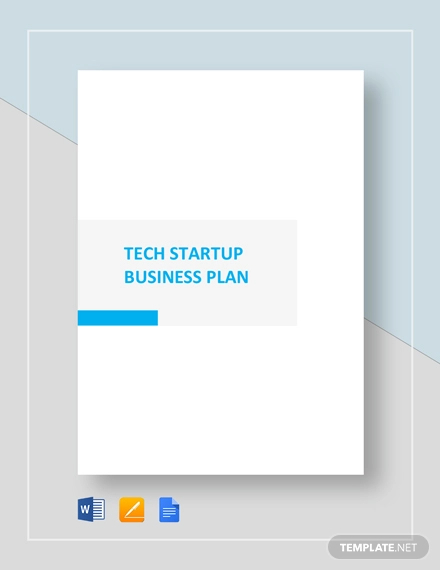
- Google Docs
Size: A4, US
Tech Startup Business Plan Example Template
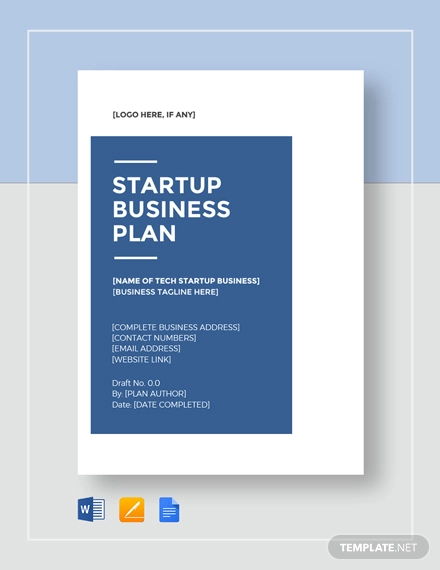
With the many opportunities and promising business ideas to choose from, business owners are starting to recognize what technology can offer them not just for personal use, but as a corporate investment as well.
Amidst the likes of Apple, Samsung, and Sony comes the wide variety of tech startups emerging in the marketplace at rapid speed. So in this article, we discuss what it takes to become a successful tech startup with the help of a simple business plan .
Tech Startup Business Plan Template

Business Plan for Startup Example
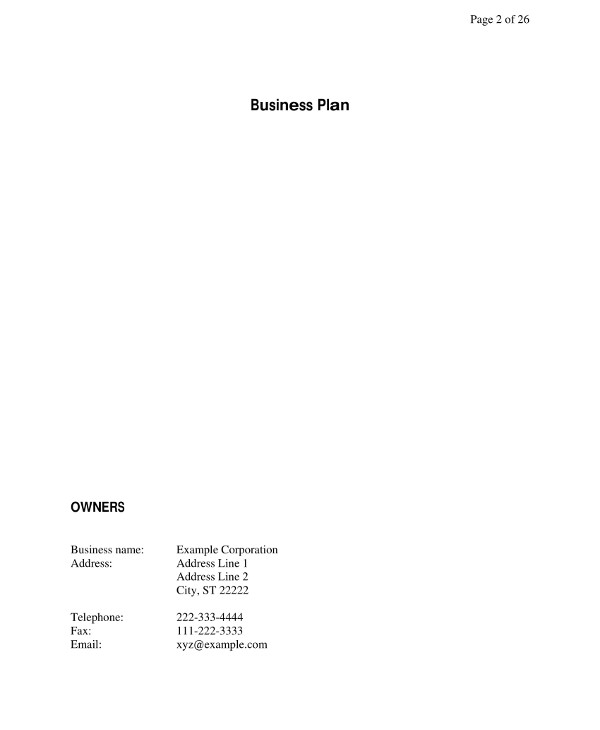
Size: 96 KB
Educational Tech Startup Business Plan Example

What Is a Tech Startup?
With the wide use of technology being more prominent now than ever, many tech startups are making the attempt to make a breakthrough in the competitive market with their innovative (and sometimes peculiar) product and service offers for consumers to enjoy. You may also like business plan guidelines examples . A tech startup is a company whose purpose is to bring various forms of technology-based products and services to the market. These companies are set to deliver a wide range of new or existing technology products or services in a variety of ways.
They come in the form of a company, a partnership, or a temporary organization that is designed to search for a repeatable and scalable business model to launch. With technology being an essential factor of our day-to-day lives, startups aim to bring innovativeness, scalability, and growth through their creations. Though it might be a while until robots and artificial intelligence completely replace manual labor, we can expect a lot from these promising tech startup ideas, especially those with an exceptional business plan in place. You may also see business operational plan examples .
IT Startup Business Plan Example

Size: 294 KB
Mobile Tech Startup Business Plan Example
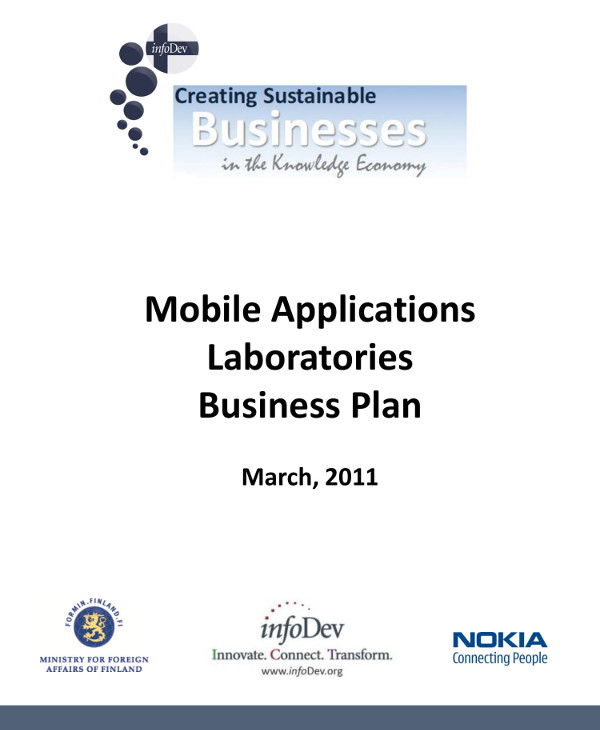
10 Essential Elements of a Tech Startup Business Plan
Every tech startup is different, with each company specializing in one thing that’s fairly different from the other. But if there’s one principle that every startup company needs, then it’s the universal wisdom of experience. You may also like to learn how to create a business plan . Truth is, many companies have attempted to try new things but failed while at it. Others have pivoted and re-branded hoping to get another shot with investors and clients, only to come out empty-handed.
Transforming your big idea into a revenue-generating reality can be a daunting experience of disappointments and rejections. But then again, in order to succeed in business (and life in general), you need to learn from these experiences to come out a million times better. The following items explain what makes a tech startup successful and the factors that you need to keep in mind when constructing your business plan :
1. Think Highly of Yourself.
This may sound like an egoistic move, but don’t take it the wrong way.
As a startup business, it wouldn’t hurt to pretend you’re a lot bigger than you actually are. They say that this can attract the type of energy you hope to achieve. Acting like a bigger company will also allow you to grow into the efficiencies it gives you. It also requires you to work just as hard as the big dogs do. Not to say you’re prohibited from having a fun work environment, as you do want to keep employees happy for them to stick around long enough for the company to prosper, but insisting on a disciplined execution will definitely keep the business afloat. This will make it easier to partner or collaborate with other successful brands who might just offer you your big break. You may also check out market analysis business plan examples .
2. Choose the Right Partners.
As a startup founder, choosing the right partners to complement your skill set and realize your vision is crucial to corporate success. Partnerships can be a tricky business, especially when it has become so easy for offshore or outsourcing companies to squeeze the money out of a vulnerable (and rather gullible) startup. It’s best to do your research on existing companies and startup founders, preferably those who have been a part of a successful company in the past, before you engage in a potential deal. You may also see network marketing business plan examples .
3. Create a Software-as-a-Service (SaaS) Plan.
You know how TV shows come out with pilot episodes first before they can release an entire season of the show? With the same concept in mind, experts believe that it’s always best to start selling parts of your product before completing a full platform. Getting market validation early on in your startup’s growth stage will give an idea of what your target customers are looking for in a product or service. This will also help you start building revenue as you continue to understand how the entire process works. You may also like how to make a business plan .
They also believe that while a good business idea is important, so is the way it is presented to investors and clients. Allowing your prospects to see your capabilities will work wonders for your startup along the way. You may also check out importance of business plan .
4. Go for the Standout Pitch.
It’s always hard to make a pitch with a potential investor. With the dozens of business ideas that come their way, standing out from the “good” and the “pretty good” is crucial to getting noticed. Your pitch with a prospect will only end with one of two ways: you either get accepted or declined. Naturally, getting accepted is the only thing that matters most. You might be interested in free business plan examples .
Since it may be difficult to identify the things that you should do and should not do for your pitch, it’s a good idea to speak with entrepreneurs with businesses that did not make it. It’s easy to focus on the successes, but not many seem to recognize the value of failures as well. This provides you with enough insight regarding how and why a company or an idea did not make the cut. You may also see bookkeeping business plan examples .
Professional Tech Startup Business Plan Example

Tech Startup Business Plan Example
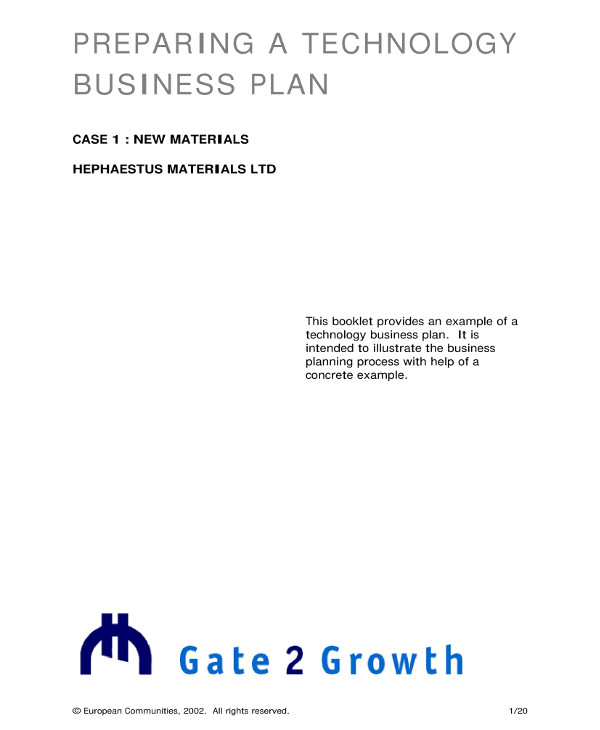
Size: 84 KB
Tech Startup Business Plan for Students Example

5. Prepare to Be Rejected.
You’ve probably heard this a thousands times before, and it couldn’t be emphasized enough. Rejection will always be a possibility, but just because a couple of investors have said “no” to you before, don’t use this as a reason to give up.
Getting the first check is the hardest, which is why many successful business owners suggest to spend the time building VC (Venture Capital) relationships before funding, and to continue networking until you have secured the necessary funds. The rejection will definitely take a toll in your spirit and drive to move forward, but you need to learn to get back up and rise above the negativity for a better and brighter future. You may also see hotel business plan examples .
6. Keep It Innovative.
There should never be a reason to stop building. You can always turn a “good” idea into something “great.” And even if it feels like you’ve reached the peak of greatness, there will always be room for more improvement.
Take tech giant Apple as an example. Even when people thought that the Touch ID of the iPhone 5S was a phenomenal feature, Apple released a facial recognition feature through Face ID which was specially designed for the iPhone X. The system was designed just a few years after the Touch ID, which proves just how the company continues to uphold the value of innovation through their products. You may also check out advertising and marketing business plan examples .
7. Aim for a Deliverable Product.
Startup founders tend to be optimistic and idea-driven, yet, they can’t seem to confine to the status quo. Though adapting to market demands is also important, picking a single area of innovation and focusing on a product that’s better than anyone else’s is key. You need to make sure you’re moving toward the right direction by understanding the exact things that your target market wants. You may also like business plan examples .
However, you need to work quickly. Trends fade and people get bored too easily. If you want to prosper, start delivering products as soon as you can and stay focused on making them a hit.
8. Put Pen on Paper.
Even after an investor has made a vow to work with you, you still need to put it in writing. Contract documents are a real thing, and you need to be responsible for them. This goes both ways in your professional relationship, as you’d want to make your counterpart feel comfortable to work with you, and you need to be able to trust that these prospects would stick to their word.
Though creating these formal documents may be pricey, it’s definitely worth the spend to guarantee long-term business relationships.
9. Be Careful with Cryptocurrency.
You might have heard about various prediction market platforms and forecasting tools that have allowed users to foresee the outcomes of real-world events, as well as buying and selling shares through smart contracts. You might be interested in simple business plan examples .
While building on blockchain or relying on cryptocurrency may seem like a promising venture, you’d still want to sketch out a full architecture of your plan, challenge it, and then build it.
10. Plan for the Long-Term.
Even with the potential risks and challenges that may cause your business to fail along the way, you still need to be optimistic enough to plan for the long-term. Investing in strong talent and developing a culture for your business to thrive on will help build a solid foundation for your startup. This will also pave the way for many opportunities, leading your business to the right direction. You may also see bar business plan examples .
Tech Startup Business Plan Guidelines Example
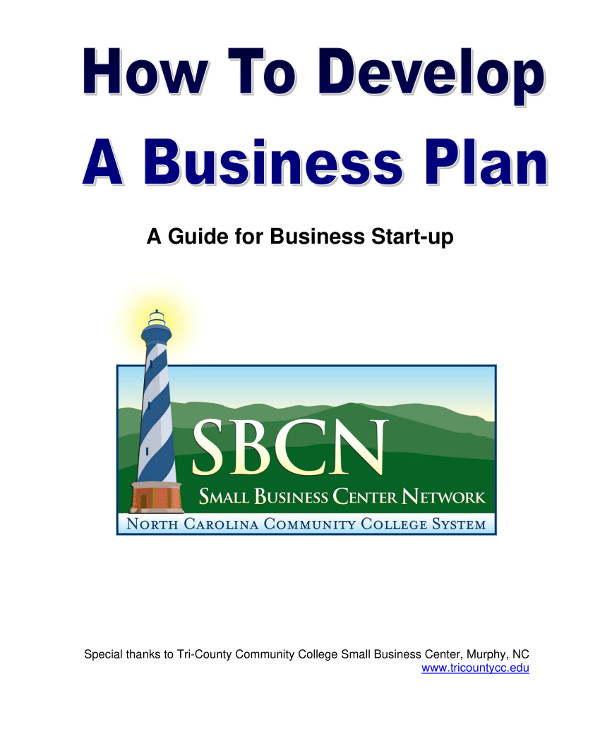
Size: 238 KB
Tech Startup Business Plan Sample
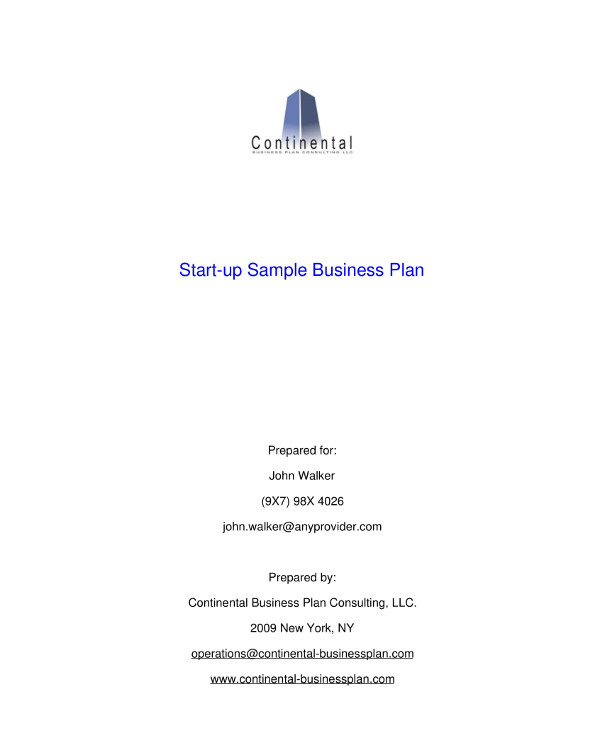
Size: 195 KB
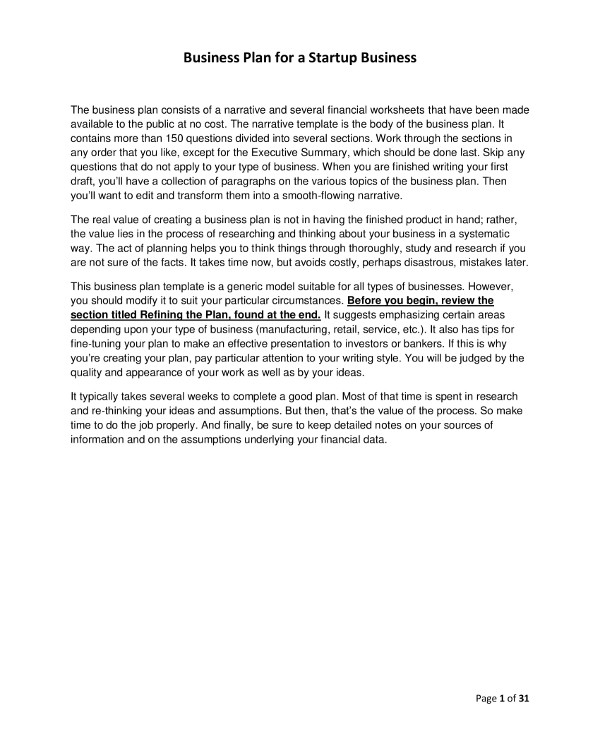
How to Write a Business Plan for Your Startup
Anyone can have a great idea; in fact, you can ask a 12-year-old for a business idea and they’d probably give you something more imaginative than what any other 30-year-old could offer. But transforming this idea into a viable business is a different ballgame you wouldn’t want to mess up. You may also see e-commerce marketing plan examples .
So if you’re hoping to launch a tech startup anytime soon, here are a few tips on how you can create an effective business plan:
1. Have a clear objective.
Set a clear objective that’s anything but ambiguous. You need to be specific about what you hope to achieve. Since starting a business requires you to offer a solution in order to address a problem, your business plan should identify who you are and what you aim to do. You must also state the kind of products and services you’ll be offering and in what industry for a more specific approach. You may also see convenience store business plan .
2. Identify your target audience.
Although your products and services will be made available for the general public, it isn’t exactly designed for everyone. Some tech startups create products for other businesses, while others cater to buying customers of a specified demographic. Knowing who your target consumers are will help you determine every detail of the product, its ideal market price, the right distribution channels, as well as your promotional strategies. You may also see business checklist examples .
3. Study your competition.
Another important factor to include in your research is your competition. You need to remember that as a startup, no one knows about you, let alone care that you exist. With so many direct competitors in the marketplace, standing out is a definite must. Figure out what makes you different from other existing companies, and you can go from there. A SWOT analysis may also be used for proper assessment.
4. Budget properly.
Running out of cash is one of the primary reasons why many businesses fail. You might start out with a million dollars in capital, but be down to your last thousands after a year or two. When this happens, your business is at risk of closing and filing for bankruptcy. This is why it’s important to take the time to budget accordingly to help minimize the risk. You may also check out marketing strategy business plan examples .
5. Define your power structure.
Running a tech startup can never be a one-man show. You need to have a reliable team of staff members to manage each department of the company, including your accounting, marketing, operations, and HR sectors. This doesn’t have to be too complex, as new businesses usually start small before they begin expanding. You may also see digital marketing plan examples .
Launching a startup company can be an exciting experience for any ambitious entrepreneur. However, it’s easy to rush into things and wind up regretting your wrongful decisions. So before anything else, always remember to write a good business plan to launch your company on the right foot. You may also like business plan examples in PDF .
Text prompt
- Instructive
- Professional
Create a study plan for final exams in high school
Develop a project timeline for a middle school science fair.
More From Forbes
How To Start A Business Plan: A Step-By-Step Guide
- Share to Facebook
- Share to Twitter
- Share to Linkedin
Creating a business plan is a critical first step for any entrepreneur. Knowing how to start a business plan will help you create a roadmap, guiding your business from startup to growth and beyond. Whether you're looking for investment, trying to set clear goals, or simply organizing your thoughts, a solid business plan can make all the difference.
Here is a guide to help you get started on your business plan:
1. executive summary.
What It Is: This section summarizes your business plan as a whole and outlines your company profile and goals.
What to Include:
- Business name and location
- Products or services offered
- Mission statement
- The purpose of the plan (e.g., seeking funding, guiding the startup process)
Tip: Keep it concise. Although it's the first section, it's often best to write it last, after you’ve detailed everything else.
2. Company Description
What It Is: This section provides detailed information about your company, including who you are, what you do, and what markets you serve.
‘House Of The Dragon’ Season 2, Episode 5 Recap And Review: The Seeds Of The Dragon
Trump says rewritten gop convention speech will call for unity after assassination attempt, will smith’s ‘bad boys: ride or die’ gets digital streaming date.
- Your business structure (e.g., sole proprietorship, LLC, corporation)
- The industry and marketplace needs your business meets
- Your business’s objectives and how you stand out from competitors
Tip: Use this section to highlight your company’s strengths and what makes you unique.
3. Market Research
What It Is: Market research demonstrates your understanding of the industry and target market.
- Market size and growth potential
- Target customer demographics
- Market trends and outlook
- Competitive analysis, including strengths and weaknesses of competitors
Tip: Include data and statistics to back up your findings and show that you’ve done your homework.
4. Organization and Management
What It Is: This section outlines your business’s organizational structure and management team.
- Organizational chart
- Information about the ownership of the company
- Backgrounds and qualifications of the management team
- Roles and responsibilities within the company
Tip: Highlight the skills and experiences of your team that will help the business succeed.
5. Products or Services Line
What It Is: Here, you detail the products or services you offer or plan to offer.
- A description of each product or service
- The lifecycle of products or services
- Research and development activities, if applicable
- Intellectual property, such as patents or trademarks
Tip: Focus on the benefits your products or services bring to your customers.
6. Marketing and Sales Strategy
What It Is: This section explains how you will attract and retain customers.
- Marketing strategies, including advertising, promotions, and public relations
- Sales strategies, including sales processes, channels, and tactics
- Pricing strategy and how it compares to competitors
Tip: Ensure your marketing and sales strategies are aligned with your market research findings.
7. Funding Request
What It Is: If you’re seeking funding , this section outlines your requirements.
- Your current funding needs
- Future funding requirements over the next five years
- How you intend to use the funds
- Potential future financial plans (e.g., selling the business, repaying debt)
Tip: Be specific and realistic about how much funding you need and how it will be used.
8. Financial Projections
What It Is: Financial projections provide a forecast of your business’s financial future.
- Income statements
- Cash flow statements
- Balance sheets
- Break-even analysis
Tip: Use realistic and conservative estimates. Consider hiring a financial professional to help with this section if needed.
9. Appendix
What It Is: The appendix includes any additional information that supports your business plan.
- Resumes of key management team members
- Permits and leases
- Legal documents
- Detailed market research data
- Product photos
Tip: Only include essential information that adds value to your business plan.
Final Tips for Creating a Business Plan
Creating a business plan requires clarity and precision. First and foremost, keep your business plan clear and concise. Avoid using jargon or complex language that could make the plan difficult to read or understand. Your aim should be to communicate your ideas effectively and efficiently.
Next, be realistic in your approach. Ensure that your goals and financial projections are attainable based on your research and understanding of the market. Overly ambitious projections can undermine your credibility and potentially lead to unrealistic expectations.
It's also essential to remember that a business plan is a dynamic document. As your business grows and market conditions change, you should revisit and revise your plan regularly. This helps you stay aligned with your goals and adapt to new challenges and opportunities.
Finally, seek feedback from experienced business professionals. Having someone with business experience review your plan can provide valuable insights and help identify any potential issues or areas for improvement. Their feedback can enhance the overall quality and effectiveness of your business plan.
By following these tips, you'll be better equipped to create a robust and effective business plan that can guide your business towards success.
The bottom line is that starting a business plan may seem challenging, but with careful planning and attention to detail, you can create a comprehensive guide to steer your business toward success. Use this step-by-step guide to ensure that all essential components are covered, giving your business the best possible start.
Melissa Houston, CPA is the author of Cash Confident: An Entrepreneur’s Guide to Creating a Profitable Business and the founder of She Means Profit . As a Business Strategist for small business owners, Melissa helps women making mid-career shifts, to launch their dream businesses, and I also guide established business owners to grow their businesses to more profitably.
The opinions expressed in this article are not intended to replace any professional or expert accounting and/or tax advice whatsoever.

- Editorial Standards
- Reprints & Permissions
Join The Conversation
One Community. Many Voices. Create a free account to share your thoughts.
Forbes Community Guidelines
Our community is about connecting people through open and thoughtful conversations. We want our readers to share their views and exchange ideas and facts in a safe space.
In order to do so, please follow the posting rules in our site's Terms of Service. We've summarized some of those key rules below. Simply put, keep it civil.
Your post will be rejected if we notice that it seems to contain:
- False or intentionally out-of-context or misleading information
- Insults, profanity, incoherent, obscene or inflammatory language or threats of any kind
- Attacks on the identity of other commenters or the article's author
- Content that otherwise violates our site's terms.
User accounts will be blocked if we notice or believe that users are engaged in:
- Continuous attempts to re-post comments that have been previously moderated/rejected
- Racist, sexist, homophobic or other discriminatory comments
- Attempts or tactics that put the site security at risk
- Actions that otherwise violate our site's terms.
So, how can you be a power user?
- Stay on topic and share your insights
- Feel free to be clear and thoughtful to get your point across
- ‘Like’ or ‘Dislike’ to show your point of view.
- Protect your community.
- Use the report tool to alert us when someone breaks the rules.
Thanks for reading our community guidelines. Please read the full list of posting rules found in our site's Terms of Service.
- Election 2024
- Entertainment
- Photography
- AP Buyline Personal Finance
- AP Buyline Shopping
- Press Releases
- Israel-Hamas War
- Russia-Ukraine War
- Global elections
- Asia Pacific
- Latin America
- Middle East
- Election Results
- Delegate Tracker
- AP & Elections
- Auto Racing
- 2024 Paris Olympic Games
- Movie reviews
- Book reviews
- Financial Markets
- Business Highlights
- Financial wellness
- Artificial Intelligence
- Social Media
Biden to call for 5% cap on annual rent increases, as he tries to show plans to tame inflation
President Joe Biden speaks from the Roosevelt Room of the White House in Washington, Sunday, July 14, 2024, about the apparent assassination attempt of former President Donald Trump at a campaign rally in Pennsylvania. (AP Photo/Susan Walsh)

- Copy Link copied
WASHINGTON (AP) — President Joe Biden is ready to propose a 5% cap on annual rent increases for tenants of major landlords as he tries to show he’s doing something about the high cost of housing, according to a person familiar with the plan.
The proposal, to be announced while the president visits Nevada on Tuesday, is being championed by Biden in the middle of a tense presidential campaign and a time when housing costs have been a major driver of overall inflation.
But the plan would require solid Democratic control of Congress to become law. Additionally, most policymakers have said the best way to limit housing costs would be through more construction and changes to land use regulations.
The person familiar with the plan spoke on the condition of anonymity because the proposal has not yet been formally announced.
Biden himself previewed the announcement at his NATO news conference Thursday, folding it into comments that blamed inflation on companies trying to maximize their profits in the aftermath of the pandemic.
“It’s time things get back in order a little bit,” Biden said. “If I’m reelected, we’re going to make sure that rents are kept at 5% increase.”
The Washington Post first reported Monday the details of the plan, which would only apply to landlords who own 50 or more units. The price cap would not apply to units that have yet to be built.
What to know about the 2024 Election
- Democracy: American democracy has overcome big stress tests since 2020. More challenges lie ahead in 2024.
- AP’s Role: The Associated Press is the most trusted source of information on election night, with a history of accuracy dating to 1848. Learn more.
- We want to hear from you : Did the attempted assassination on former president Donald Trump change your perspective on politics in America?
- Read the latest: Follow AP’s live coverage of this year’s election.
White House officials declined to comment.
The median national rent was $1,411 a month in June, up from roughly $1,150 in early 2021 when Biden became president, according to Apartment List .
Asking prices for rentals jumped in the aftermath of the pandemic and have since cooled, but the Harvard University Joint Center for Housing Studies found in its most recent report that half of renters were “cost burdened” because they spend more than 30% of their income on housing and utilities.
In recent months, housing has been a primary contributor to keeping the consumer price index elevated at 3% annually. Inflation has been a fundamental obstacle for Biden politically as he competes against Donald Trump, the former president and Republican nominee.
The president has proposed policies designed to increase home construction, but industry representatives were quick to criticize the rent cap as ineffective for addressing the overall shortage and possibly leading to fewer habitable units than the country would otherwise have.
“This is not going to create a single unit of housing — which is what is needed to create more housing opportunities for Americans,” said Sharon Wilson Géno, CEO of the National Multifamily Housing Council. “This is really a campaign-driven piece of rhetoric.”
Géno noted that landlords need to be able to keep up with costs such as maintenance, insurance and state and local taxes. If those costs exceed what they can charge for rent, the risk is that landlords will do less to maintain their properties and tenants could be worse off.
“What does that mean — the quality of the housing suffers,” she said.
But affordable housing advocates said that if Biden’s proposal had already been in effect, it would have likely reduced evictions and homelessness.
“The recent unprecedented increases in homelessness in communities across the country are the result of those equally unprecedented — and unjustified — rent hikes of a couple years ago,” said Diane Yentel, president and CEO of the National Low Income Housing Coalition. “Had such protections against rent gouging been in place then, many families could have avoided homelessness and stayed stably housed.”

- Disaster recovery planning and management

Olivier Le Moal - stock.adobe.co
6 benefits that make a disaster recovery plan worth it
Disaster recovery plans help reduce recovery time, ultimately saving time and money. time spent testing and planning upfront pays dividends when a disaster strikes..

- Stuart Burns
Disaster recovery planning requires organizations to invest time, money and personnel. It often involves testing, trainings and exercises, not to mention hardware and software investments for offsite, on-premises and cloud recovery options.
However, the costs are far outweighed by the benefits of a DR plan . Businesses without good backups and tested DR plans are more likely to go out of business due to data loss, reputational damage and the other risks they take by not having a DR plan in place. Organizations with a DR plan can reap strong benefits, such as meeting legal requirements and having a better understanding of the resources they need.
Below are six benefits of a disaster recovery plan.
1. It reduces the panic of dealing with an unexpected crisis
One of the best things about having a disaster recovery plan ready to go is that most scenarios that could make a disaster worse have already been thought about, and mitigations and plans have been documented, tested and validated by the DR team . It provides a tested roadmap for the worst day imaginable. It can also highlight current risks that have not been thought about before.
Doing so reduces the risk of panic and improvisation that could potentially make the situation worse. As the name suggests, a plan gives an outline of what needs to happen, when and by whom. A good DR plan also includes exercises to test it, leading to snags being ironed out ahead of time.
As with most things, the more practice, the better the outcome.
2. The right people are involved at the right time
Another benefit of a disaster recovery plan is that those key individuals that are needed in a disaster know about it ahead of time. It also cuts through the chatter and gets the right people at the right time to the right place. When people know they are to be called upon in a DR plan, it enables them to manage that much better.
3. It manages expectations and brings in necessary parties
If a company is experiencing a crisis that requires it to invoke the DR plan, knowing who needs to be notified and how to contact them means that those people who can positively affect the situation are aware and well-rehearsed mitigations can be put in place. It also can inform stakeholders and customers of the disruption and manage their expectations. The last thing a company needs in a disaster is the distraction of third parties trying to conduct business as usual on systems that are down.
4. It helps meet legal and PR requirements
One thing a lot of administrators don't immediately think about is that some scenarios can have reporting and other legal requirements. Documenting these in the DR plan provides a degree of clarity.
This can also extend to PR teams and having preagreed communications to help protect the company's reputation. This can be a major concern for many organizations, especially high-profile businesses or those in regulated industries .
5. Investing in DR is good for data backup
Businesses that invest in a DR plan tend to be those that have quality, tested backups . Without backups, the best DR plan is worthless. This is an absolute requirement for successful recovery.
6. It provides a better understanding of required resources
Implementing disaster recovery plans can be expensive. That said, if an appropriate disaster recovery plan exists, it becomes straightforward to quantify the spending involved. DR plans outline internal and third-party resources the business will use in a crisis. Having these resources laid out in an official DR plan can ease future communications with third-party services and provide an understanding of the potential expenses that will be required.
Stuart Burns is a virtualization expert at a Fortune 500 company. He specializes in VMware and system integration with additional expertise in disaster recovery and systems management. Burns received vExpert status in 2015.
Dig Deeper on Disaster recovery planning and management

disaster recovery (DR) test

disaster recovery plan (DRP)

4 disaster recovery plan best practices for any business

Best practices for a strong disaster recovery testing strategy
Backups are critical when using Windows Server. While third-party cloud vendors offer protection, Windows Server admins can back ...
This comprehensive guide explains backup basics, the issues affecting risk and the seven critical backup strategies you need to ...
There are several different types of backup. Here's how to choose the best way to safeguard your data and recover appropriately ...
Is unmanaged, unstructured data clogging up your primary storage? Get control of this costly, performance-sapping situation and ...
The acquisition brings Storj's distributed storage offerings together with Valdi's distributed compute services for ...
Pure Storage is the latest infrastructure vendor to add Nvidia DGX SuperPod certification and new product offerings to support ...
In response to a wave of recent attacks on customers, Snowflake introduces new authentication offerings that enable ...
Fallout from the attacks on Snowflake customers continues as AT&T is the latest victim organization to disclose a data breach ...
Businesses must be ever vigilant in detecting the increasingly sophisticated nuances of deepfakes by applying security techniques...
The next U.S. president will set the tone on tech issues such as AI regulation, data privacy and climate tech. This guide breaks ...
Formulating budgets for digital transformation projects is fraught with complexities, expectations and unknowns that ...
Employers need to start planning for compliance with the FTC noncompete ban, effective Sept. 4, despite uncertainty around ...
Gen Z's latest fashion hack is using iPhone Notes to plan outfits. Here's how to do it yourself.
- iPhone owners are uploading photos of their outfits to the Notes app on their phones.
- The Gen Z viral style hack is helping people to remember and plan their looks.
- Here's which iPhone features to use if you want to try it.

Gen Z fashionistas are taking closet organization into their own hands — and using a simple iPhone feature to do it.
While Pinterest boards offer style inspiration, some young people are using the Notes app instead. There, they can upload photos of their own wardrobe and outfits and plan looks based on clothes they already have.
One big benefit: There aren't any special apps or tools to download. This closet-organizing hack is doable with an up-to-date iOS device .
It's unclear who was the first to figure it out, but it was popularized by influencer Morgan Riddle in 2023. It's particularly helpful when planning outfits for a vacation, and many people break them down by location or occasion.
TikTokers praise the hack for helping them remember their favorite outfits and plan for trips. Some compared it to dress-up toys like Polly Pocket or the changeable avatar skins in the video game Fortnite.
Here's how to make your own version of Cher Horowitz's closet from the "Clueless" movie.
Start in your Photos app
You can either try on potential outfits or use photos you've already taken, but you'll want to use full-body pictures of yourself.
Pro tip: For the best results, choose images in which you're the main focus and the only one in the photo.
Once you've chosen your first picture, press down on your body until it's highlighted with a glowing outline and a list of options at the top. Then, press "copy."
Now head to the Notes app
Once you've copied the outfit, open the Notes app and select a note to paste your image onto. You can use a generic title like "Outfits" or name your note based on a trip or occasion.
Related stories
Press anywhere on the empty note to paste your outfit. It'll probably take up most of the note at first, but don't worry.
To shrink it down and make room for more pictures, press the three dots in the top right corner of the note. When the options come up, press "attachment view," then select "set all to small." That should make your images smaller. You can do this after adding all of your attachments, but doing it after the first one made it easier for me to organize them.
Repeat and customize it based on your needs
Once you've uploaded all of your ensembles, it's time to organize them how you see fit. Since I'm not going on a trip soon, I sorted some past outfits based on which season they're best suited for.
You could also sort them by a particular aesthetic or the type of event to which they'd be worn.
As someone who tends to plan her outfits about an hour before walking out of the door in them, I was skeptical of this hack.
However, being able to keep a record of my favorite looks from over the years has made this a useful tool.
I might not want to repeat my 'fits, but having them side by side is giving me new inspo on how to mix and match my clothes.
Watch: Why the retail industry has its eye on Gen Z
- Main content
- Share full article
Advertisement
Supported by
U.S. Creates High-Tech Global Supply Chains to Blunt Risks Tied to China
The Biden administration is trying to get foreign companies to invest in chip-making in the United States and more countries to set up factories to do final assembly and packaging.

By Edward Wong and Ana Swanson
Reporting from Washington
If the Biden administration had its way, far more electronic chips would be made in factories in, say, Texas or Arizona.
They would then be shipped to partner countries, like Costa Rica or Vietnam or Kenya, for final assembly and sent out into the world to run everything from refrigerators to supercomputers.
Those places may not be the first that come to mind when people think of semiconductors. But administration officials are trying to transform the world’s chip supply chain and are negotiating intensely to do so.
The core elements of the plan include getting foreign companies to invest in chip-making in the United States and finding other countries to set up factories to finish the work. Officials and researchers in Washington call it part of the new “chip diplomacy.”
The Biden administration argues that producing more of the tiny brains of electronic devices in the United States will help make the country more prosperous and secure. President Biden boasted about his efforts in his interview on Friday with ABC News, during which he said he had gotten South Korea to invest billions of dollars in chip-making in the United States.
But a key part of the strategy is unfolding outside America’s borders, where the administration is trying to work with partners to ensure that investments in the United States are more durable.
We are having trouble retrieving the article content.
Please enable JavaScript in your browser settings.
Thank you for your patience while we verify access. If you are in Reader mode please exit and log into your Times account, or subscribe for all of The Times.
Thank you for your patience while we verify access.
Already a subscriber? Log in .
Want all of The Times? Subscribe .
We've detected unusual activity from your computer network
To continue, please click the box below to let us know you're not a robot.
Why did this happen?
Please make sure your browser supports JavaScript and cookies and that you are not blocking them from loading. For more information you can review our Terms of Service and Cookie Policy .
For inquiries related to this message please contact our support team and provide the reference ID below.

COMMENTS
A technology business plan is a plan to start and/or grow your technology business. Among other things, it outlines your business concept, identifies your target customers, presents your marketing plan and details your financial projections. You can easily complete your Technology business plan using our Technology Business Plan Template here.
Marketing Plan. Traditionally, a marketing plan includes the four P's: Product, Price, Place, and Promotion. For a technology business plan, your marketing plan should include the following: Product: In the product section, you should reiterate the type of technology company that you documented in your Company Analysis.
1. Begin your company overview section by describing what your business specializes in and the technology behind it. This part of the company overview is intended to give readers and investors a general idea of your business. 2. Next, proceed to explain the nature of the industry and marketplace. 3.
Communication Technology Business Plans. Administrative Service Business Plan. Cell Phones Retailer Business Plan. Computer Laser Accessories Business Plan. Computer Repair Business Plan. Integrated Communications Business Plan. Satellite Communications Business Plan. Telecom Wireless Business Plan. Telecommunications Business Plan.
By including the seven elements below, you'll have a plan that gives your company a much stronger footing. 1. Executive Summary. The executive summary is, without a doubt, the most critical element of your tech startup business plan. Despite this, a lot of plans fail here because the summary doesn't captivate readers.
A Sample IT Tech Startup Business Plan Template. 1. Industry Overview. An IT technology company (often tech company) is a type of business entity that focuses on the development and manufacturing of technology products, or providing technology as a service. "Technology", in this context, has come to mean electronics-based technology.
A tech startup business plan is a comprehensive document that outlines the goals, objectives, and strategies of a technology-based startup company. It is a crucial tool that helps entrepreneurs in the tech industry to define and organize their ideas, demonstrate the feasibility of their business concept, and present a clear plan for how they ...
Here are the five key elements that every good business plan includes. 1. Executive Summary. The executive summary is a brief overview of your business plan. It should include your company's mission statement, a brief description of your products or services, an overview of your target market, a summary of your financial projections, and your ...
Your operations plan should have two distinct sections as follows. Everyday short-term processes include all of the tasks involved in running your IT business, including answering calls, meeting with new clients, billing and collecting payments from clients, etc. Long-term goals are the milestones you hope to achieve.
A tech startup business plan outlines a company's strategy and objectives. It serves as a roadmap for how to start and grow a business, and covers all the important aspects of a business including marketing, operations, and finances. The plan also gives details on how to organize the company's resources to achieve the desired results.
The business plan should include information on the products or services offered by the startup, the market opportunity, the business model, the team, the financial projections, and the risks and challenges associated with the business. A tech startup's business plan should generally address three major areas of the business:
Our array of business plan examples cover various technology business types, including software development companies, hardware manufacturers, IT service providers, and tech startups exploring emerging fields like AI and blockchain. Each plan is carefully constructed to address key components such as market analysis, technological innovation ...
A well-defined structure of summary will convey your ideas. Consider including an introduction, main body, and conclusion that are short but informative. The important takeaways from your tech business plan would be provided by this structure. Tip #4. Mention exit strategy. An exit strategy is an essential part for stakeholders.
How to create a technology startup business plan. Once you understand the benefits a business plan can give you, it's time to move to developing one. Here are the must-have sections for your business plan. #1 Executive summary. An executive summary presents your overall business plan. Its aim is to capture your readers' attention and make ...
How to start a tech business in 6 steps. Create a business plan. Select a business structure. Obtain business financing or capital. Set up accounting and bookkeeping services. Source specific tech equipment. Register your tech business. 01. Create a business plan.
A tech startup business plan is a stepping stone that turns your ideas into a successful business. Unfortunately, many entrepreneurs and startups overlook the significance of business plans. If you are looking to start a technology startup with high earning potential, then creating a business plan is the way to go. ...
Position your technology venture at the forefront of innovation with our comprehensive selection of technology industry business plan examples. This invaluable resource is engineered for entrepreneurs, startup founders, and IT leaders seeking to navigate business planning in the fast-paced tech landscape.
Every technology startup is different, but the recipe for what makes a successful startup business plan is the same: it comes down to the universal wisdom of experience. Successful startups have ...
For tech startups, Gosmallbiz is an excellent choice as it offers not just business plan making but also access to business continuity planning software to create a road map or build a website and other features. Features: Many business-plan templates relevant to the tech industry; User-friendly business plan building wizard
Your hiring plan could also give a salary range for each position and how you'll recruit new employees. 7. Financial plan. Your financial plan should go beyond a simple balance sheet to explain how your business is funded, what your monetary needs will be in the future, and how you'll meet them.
Establish technology as a differentiator, when it is. Tell me about it in relation to its importance to the business. Don't force me to understand it when I don't need to. On the other hand, as a writer, manager, and user of business plans as tools for steering a business, I believe you should discuss your technology in the plan for any ...
A well-structured business plan is the backbone of every successful business, and tech startups are no exception. It serves as a roadmap, guiding your business decisions, helping you manage challenges, and persuading potential investors of your business's viability. Here are some essential elements to include in your business plan:
You may also see e-commerce marketing plan examples. So if you're hoping to launch a tech startup anytime soon, here are a few tips on how you can create an effective business plan: 1. Have a clear objective. Set a clear objective that's anything but ambiguous. You need to be specific about what you hope to achieve.
Here is a guide to help you get started on your business plan: 1. Executive Summary. What It Is: This section summarizes your business plan as a whole and outlines your company profile and goals.
The median national rent was $1,411 a month in June, up from roughly $1,150 in early 2021 when Biden became president, according to Apartment List.. Asking prices for rentals jumped in the aftermath of the pandemic and have since cooled, but the Harvard University Joint Center for Housing Studies found in its most recent report that half of renters were "cost burdened" because they spend ...
David Ellison's plans for Paramount don't just include making better TV shows and movies. They call for better tech. How's that going to work?
The benefits of a disaster recovery plan are many and varied. Here are six reasons implementing a disaster recovery plan is worth the cost and effort. ... Businesses without good backups and tested DR plans are more likely to go out of business due to data loss, reputational damage and the other risks they take by not having a DR plan in place ...
iPhone owners are uploading photos of their outfits to the Notes app on their phones. The Gen Z viral style hack is helping people to remember and plan their looks. Here's which iPhone features to ...
The core elements of the plan include getting foreign companies to invest in chip-making in the United States and finding other countries to set up factories to finish the work.
International Business Machines Corp.'s proposed $6.4 billion takeover of software maker HashiCorp Inc. will undergo an in-depth antitrust review by the US Federal Trade Commission.